Trip Report:
The Mountain Gorillas of Rwanda
Trip 2,
November 2012
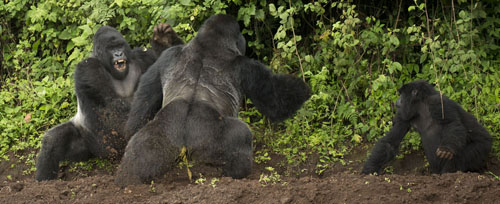
This trip marked our 71st to 75th Mountain Gorilla Trek, and our 75th trek became the most exciting, action-packed, and rewarding trek we ever had. One would think that with 75 treks (the world record, by the way!) we'd have seen and photographed everything possible but that simply isn't true. Each trek is a new experience and has the potential, as the 75th trek showed, of an incredible experience.
That afternoon the lodge, our outfitter, and the National Park held a wonderful event celebrating the completion of our landmark 75th trek. Perhaps making it even more special, Mary had had a total knee replacement on June 29th, just 5 months earlier.
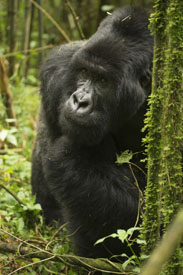 One of our participants really said it best. He noted that you really don't get a fair idea of how big these animals are, how intimate the experience is, and how great the experience is until you've done it. Pictures, no matter how wonderful, simply do not truly convey the uniqueness, the wonder and awe, of this experience.
One of our participants really said it best. He noted that you really don't get a fair idea of how big these animals are, how intimate the experience is, and how great the experience is until you've done it. Pictures, no matter how wonderful, simply do not truly convey the uniqueness, the wonder and awe, of this experience.
We'll be doing many more Rwanda Mountain Gorilla treks and we'd urge you to join us ... there is nothing like it in the natural world.
If you are interested, please read our Brochure and our other trip reports to get a great idea of the incredible opportunities a Rwanda Mountain Gorilla Trek offers.
Check out our Previous Trip Reports: 2010, 2011, January 2012, October 2012
What follows it the complete report.
Day 1. Our flight from Nairobi to Kilgali, Rwanda went uneventfully but our lunch, upon arrival, was marked by an incredible storm. From our open air restaurant we could hear the storm advancing over the city, as the countless tin roofed structures created a pounding, drumbeat as the storm advanced. Our restaurant had a metal roof as well and through much of the meal we were silent as the drumming rain made speaking almost impossible.
Our drive to our lodge went smoothly as the rains had stopped and, surprisingly, there was little evidence of the storm. As we reached the lodge, however, the rains began again, coming down in driving sheets that stopped just as we headed to our rooms. It rained through much of the evening and into the night and we worried that we’d face rains on our first day of trekking.
Day 2. Sabyinyo Group
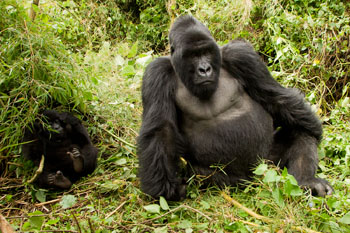
Scattered clouds covered the volcanoes to the east, reflecting a pleasing orange in the predawn light, a visual that should have been captured as an image. We had our group assigned and our briefing at park headquarters and headed out to Sabyinyo. Some clouds covered the volcano slopes but the eastern sky and much of the sky above us was clear and we hoped that the clouds would build up to a pleasant canopy by the time we did our shoot.
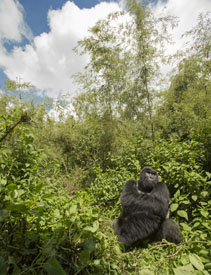
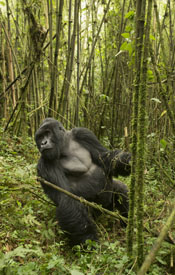
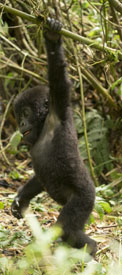
We love using wide-angle lenses when we can to incorporate the landscape. Bright sunlight can create terrible contrast but in an opening, with the sky included, the light worked. In thick bamboo the shutter speeds are slow, especially when the hoped-for clouds block out the sun.
For the most part it did not and for much of the shoot, in fact the first half, the sun was bright and the contrast was simply terrible. I had borrowed another DX camera from my friend Bill as my DX’s LCD monitor had died and I did not want to do the shoot without having some reference to check exposures. The Sabyinyo group of 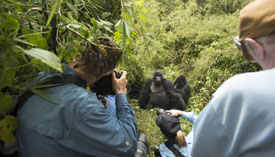 gorillas was in a fairly open glade amongst the bamboo, but most of the group, most times, were in the shade along the edges. A young gorilla, about 8 months old, repeatedly climbed a couple of bamboo stalks, and occasionally a cloud offered some shade, and good shooting, for a brief time.
gorillas was in a fairly open glade amongst the bamboo, but most of the group, most times, were in the shade along the edges. A young gorilla, about 8 months old, repeatedly climbed a couple of bamboo stalks, and occasionally a cloud offered some shade, and good shooting, for a brief time.
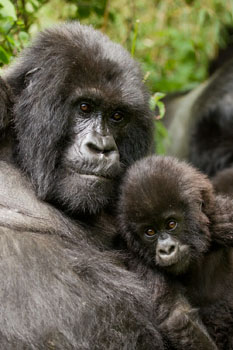
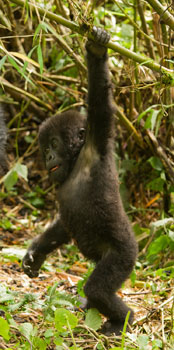
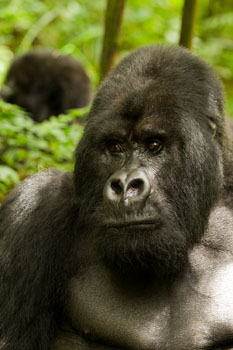
Mary's Sabyinyo Portfolio
The crazy Black-back, Shirimpumu, of the group was surprisingly well behaved, actually somewhat disappointingly so as his antics do create some excitement on a shoot. Guhonda, the 42 year old silverback and perhaps the largest in all the Virungas, made several appearances and at one point disciplined a juvenile or a female, pouncing on the smaller ape and apparently mauling it, but actually not creating any wounds.
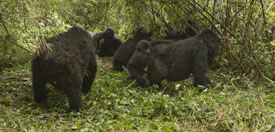
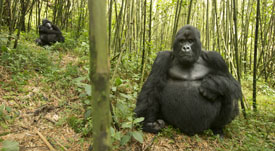
His son, a twenty year old silverback, now disputes ownership of the family, creating tension at times. Our guide told us that this silverback, Gihishamosisi, often prevents Guhonda from mating. Last trip, however, Guhonda severely punished this other silverback for getting one of the babies in trouble, being caught in a snare. We could see the now healing wound on his shoulder.
Towards the end of the shoot Gihishamosisi walked right through our group, almost brushing shoulders with two of us as it went by.
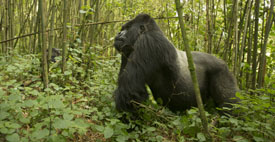
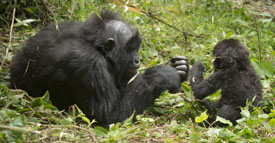
Guhonda left, too, and we followed him into the bamboo where we had our final few minutes as he sat in the shade of the bamboo, fully in the open, and later, standing in the classic silverback pose.
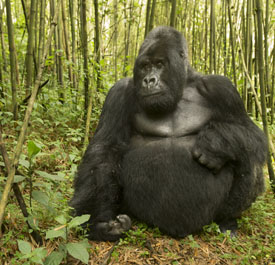 We were finished our shoot by 10:50 or so, and returned to the vehicle by 11:45. The volcanoes behind us were framed by ominous black storm clouds and, as we walked back we had the soft, cloudy-bright light we hoped for on the shoot. By 2 the storms reached our lodge and the day, once bright, is again dreary, dark, and very damp.
We were finished our shoot by 10:50 or so, and returned to the vehicle by 11:45. The volcanoes behind us were framed by ominous black storm clouds and, as we walked back we had the soft, cloudy-bright light we hoped for on the shoot. By 2 the storms reached our lodge and the day, once bright, is again dreary, dark, and very damp.
Day 3. Kwitonda
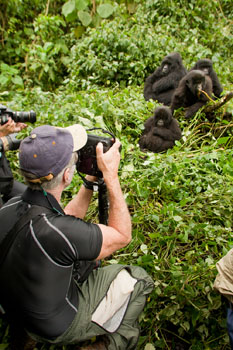 Clouds covered the volcanoes at dawn and we worried that we might have rain early in the trek but by the time we started our worries were reversed – we hoped that the patches of blue sky would pass. Our guide drove our vehicle within a quarter mile of the stone fence that marks the park and the trek across the fields went fast, almost too fast as we hoped that the longer we waited the more likely the clouds would come. The trek through the forest was more difficult than yesterday, with a gradual uphill climb but through thick vegetation, often cut fresh with machetes. We met the trackers in a clearing amidst extremely thick vegetation, but shrub-like, and we hoped when we reached the gorillas we’d find them in a clearing.
Clouds covered the volcanoes at dawn and we worried that we might have rain early in the trek but by the time we started our worries were reversed – we hoped that the patches of blue sky would pass. Our guide drove our vehicle within a quarter mile of the stone fence that marks the park and the trek across the fields went fast, almost too fast as we hoped that the longer we waited the more likely the clouds would come. The trek through the forest was more difficult than yesterday, with a gradual uphill climb but through thick vegetation, often cut fresh with machetes. We met the trackers in a clearing amidst extremely thick vegetation, but shrub-like, and we hoped when we reached the gorillas we’d find them in a clearing.
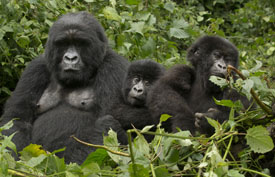 Indeed we did find a small family group parked in a clearing where four or five gorillas clumped together, posing nicely. Others climbed bamboo or tall trees in the background, but the contrast there was simply too great. By the time we reached the gorillas the clouds did arrive, making for wonderful cloudy bright conditions. Eventually the group moved off and we followed, looking for another opportunity.
Indeed we did find a small family group parked in a clearing where four or five gorillas clumped together, posing nicely. Others climbed bamboo or tall trees in the background, but the contrast there was simply too great. By the time we reached the gorillas the clouds did arrive, making for wonderful cloudy bright conditions. Eventually the group moved off and we followed, looking for another opportunity.
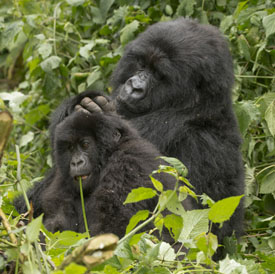
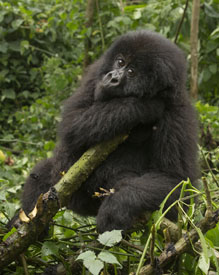
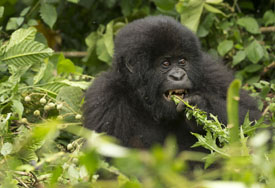
The first several minutes of this shoot were productive, with a family group posing together as well as both juveniles and a baby performing for us in the open.
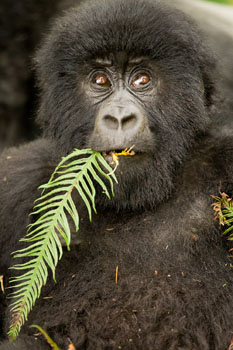
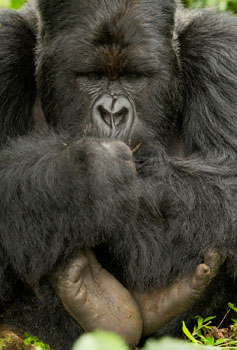
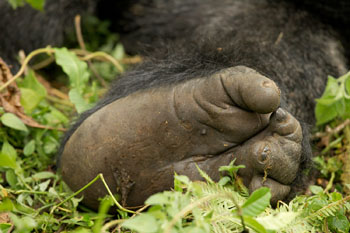
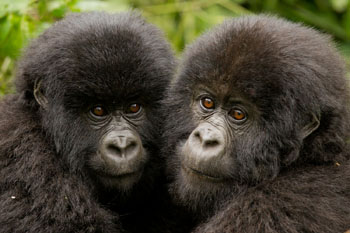
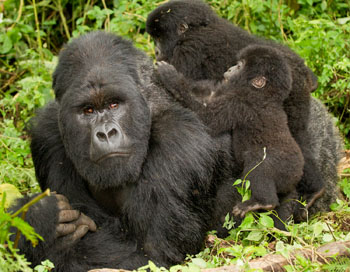
Mary's Kwitonda Portfolio
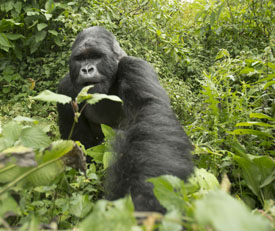 We found the dominant silverback sitting in a clearing, and through the rest of the shoot some females and babies moved in to join him. Our shooting, for the most part, comprised doing a semi-circle around the male. Towards the end of the shoot first one baby, then another slightly younger, joined the silverback and climbed atop his back. The first one to arrive slapped the male repeatedly across the silver back, but the male never flinched.
We found the dominant silverback sitting in a clearing, and through the rest of the shoot some females and babies moved in to join him. Our shooting, for the most part, comprised doing a semi-circle around the male. Towards the end of the shoot first one baby, then another slightly younger, joined the silverback and climbed atop his back. The first one to arrive slapped the male repeatedly across the silver back, but the male never flinched.
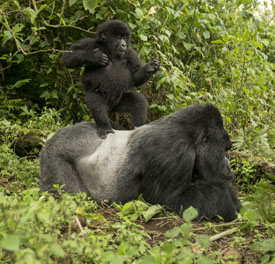
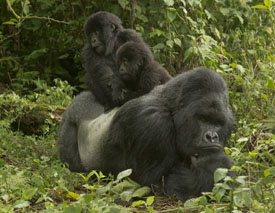
When the other arrived they wrestled, and at one point the older of the two stood on the silverback’s back and did his own chest thumping. As our hour progressed the shooting only got better and more intense, but fortunately the babies finally got off the silverback and, in a moment of relative calm, we were forced to leave as our time was up.
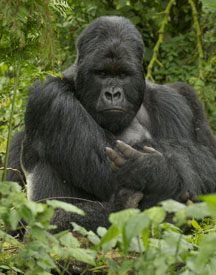
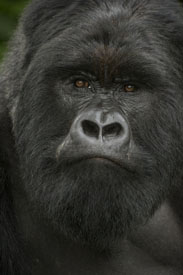
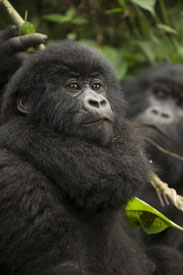
Portraits of a silverback and a juvenile being groomed. Below, a silverback disciplines a female, a fast charge that was extremely exciting to watch.
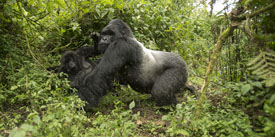 Heavy black clouds crept in again but we did not have rain, and by 3PM, although the tops of the volcanoes are lost in cloud, it had not rained. Most of the group went out with our guide for some landscapes and people photography, although Don, Mary, and I stayed back to catch up on various things. By 4:15 the rains began again, continuing through most of the evening as a drizzle.
Heavy black clouds crept in again but we did not have rain, and by 3PM, although the tops of the volcanoes are lost in cloud, it had not rained. Most of the group went out with our guide for some landscapes and people photography, although Don, Mary, and I stayed back to catch up on various things. By 4:15 the rains began again, continuing through most of the evening as a drizzle.
Day 4. Agasha
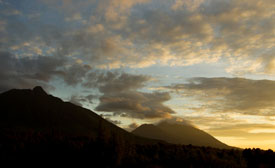 Some clouds covered Sabyinyo and Muhabura volcanoes and, by 5:45AM, beautiful color lit up the sky, the clouds, and the volcano slopes. In this early, hard angular light the fluted, convoluted slopes of the volcanoes can clearly be seen, parallel ridges that extend from the base high up onto the slopes. Seeing these, one can easily envision these mountains in more active times.
Some clouds covered Sabyinyo and Muhabura volcanoes and, by 5:45AM, beautiful color lit up the sky, the clouds, and the volcano slopes. In this early, hard angular light the fluted, convoluted slopes of the volcanoes can clearly be seen, parallel ridges that extend from the base high up onto the slopes. Seeing these, one can easily envision these mountains in more active times.
Our hike to the forest wall was short and easy but once inside the lava rock fence the trail grew steep as we climbed continuously through the dark, dank bamboo forest. We were told that the hike would take nearly an hour and we hoped that, with that climb, we’d find the gorillas outside of this deadly bamboo belt.
Normally, by 9:30 or so we’re with the gorillas but not today, as we skirted along the topographic line following the clearings and skirting the distant wall. In another 45 minutes or so we encountered the gorillas, but they were in thick cover, in an open glade so thickly vegetated that gorillas inside the brush were virtually invisible. By 10:30 we found a female atop a nest and the silverback nearby but neither stayed long and the entire troop slowly worked their way downhill. We followed, as best we could, negotiating over the slippery stems and roots of the meadow vegetation, sometimes brushing against the flat leaves or hairy stems of the innumerable stinging nettle bushes lining the trail.
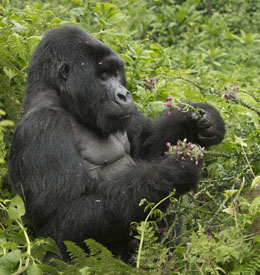

A silverback feeds upon thistle flowers.
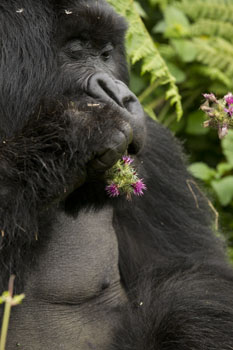
We had the Silverback once in an opening where he was feeding upon the flowers of thistles. A few weeks ago one of the babies in the group had been caught by a snare, requiring a veterinarian to tranquilize the baby. Agasha, the silverback, was quite upset and for the next several days charged any visitors, effectively closing down this group to tourism. We were cautioned not to point our monopods, as they might look like a dart gun and trigger some aggression from the male. He moved within a few minutes and what followed was a long, winding route through nettles, bamboo, thick brush, bamboo tunnels, and slippery roots as we slowly descended the mountain. Sometimes the silverback would just be a few yards in front of us, as if he was about to stop and rest, while at other times we’d need to step off the trail to let a mother, with a baby riding her back, stride by.
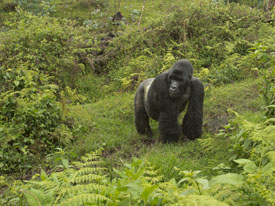 Eventually we reached the lava rock boundary wall again where, scattered about at various eucalyptus trees, most of the gorilla family were huddled, busily chewing at the bark. The silverback paused in an opening on the park side of the fence, offering a wonderful view as several of his family passed beside him. He moved on and we followed, expecting him to climb over the stone fence and join the majority of his group.
Eventually we reached the lava rock boundary wall again where, scattered about at various eucalyptus trees, most of the gorilla family were huddled, busily chewing at the bark. The silverback paused in an opening on the park side of the fence, offering a wonderful view as several of his family passed beside him. He moved on and we followed, expecting him to climb over the stone fence and join the majority of his group.
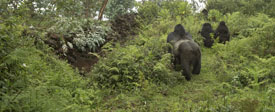
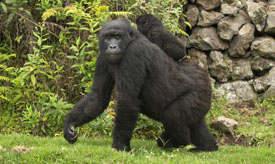
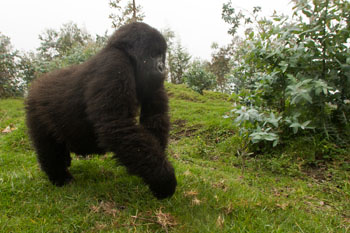
We lost sight of the silverback momentarily and then, before us in a wide gap in the trail, he strode passed, offering just a brief glimpse of his massive forearms and a flash of his silver back. A second later a female passed, then another and another, and that viewing, offering no shots and lasting just a moment, was a quintessential experience – a tantalizing glimpse of wild gorillas, not a stoic, static primate sitting before us. He continued through the forest and we changed course, deciding on going for the large number of gorillas still feeding outside the wall.
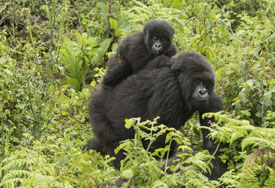 We crossed at a true barrier, climbing up and over with some difficulty. As the last people made the climb the gorillas began to pass, walking or stepping rapidly by, moving on to another clump of eucalyptus trees. We had one wonderful session with a female that stood and climbed a tree, opening her mouth wide at times to rake her incisors down, scraping away at the soft pulp beneath the bark. At one point, as Judy and I photographed, another gorilla unexpectedly walked right between us, just inches away, as it continued downhill to join another at a tree.
We crossed at a true barrier, climbing up and over with some difficulty. As the last people made the climb the gorillas began to pass, walking or stepping rapidly by, moving on to another clump of eucalyptus trees. We had one wonderful session with a female that stood and climbed a tree, opening her mouth wide at times to rake her incisors down, scraping away at the soft pulp beneath the bark. At one point, as Judy and I photographed, another gorilla unexpectedly walked right between us, just inches away, as it continued downhill to join another at a tree.
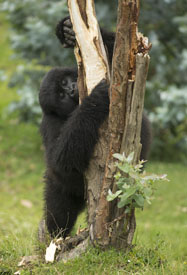 The group fed and moved, paused for some bark or to tear off a eucalyptus branch, and moving on again, slowly working their way back to the lave rock wall. As the last gorilla climbed back over the wall the mist and low clouds we had all morning finally transitioned into a misting rain. We found a low breach in the wall and moved back into the forest as the rain intensified. The silverback sat beneath a canopy of bamboo inside but with the rain and an advancing fog the light had dropped to near night conditions. Shooting was impossible, or a waste of time and a threat to our equipment, and we called a halt to the shoot. Our porters joined us within minutes and, in a serious rain, we hiked back to our vehicle for a wet ride home.
The group fed and moved, paused for some bark or to tear off a eucalyptus branch, and moving on again, slowly working their way back to the lave rock wall. As the last gorilla climbed back over the wall the mist and low clouds we had all morning finally transitioned into a misting rain. We found a low breach in the wall and moved back into the forest as the rain intensified. The silverback sat beneath a canopy of bamboo inside but with the rain and an advancing fog the light had dropped to near night conditions. Shooting was impossible, or a waste of time and a threat to our equipment, and we called a halt to the shoot. Our porters joined us within minutes and, in a serious rain, we hiked back to our vehicle for a wet ride home.
Day 5. Kwitonda
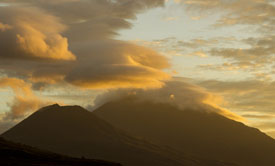 The volcanoes were capped with clouds at dawn and, as the sun cleared the horizon, we had the most spectacular sunrise landscape of the trip. Muhabura, the furthest volcano to the northeast, was topped by puffy clouds that caught the yellow-orange light brilliantly. As the early morning progressed we worried that our day would be too bright, as the eastern sky was clear of clouds. By 8 cloud cover began to build over all of the volcanic peaks and as we started our trek much of the sky was covered with a light veil of clouds.
The volcanoes were capped with clouds at dawn and, as the sun cleared the horizon, we had the most spectacular sunrise landscape of the trip. Muhabura, the furthest volcano to the northeast, was topped by puffy clouds that caught the yellow-orange light brilliantly. As the early morning progressed we worried that our day would be too bright, as the eastern sky was clear of clouds. By 8 cloud cover began to build over all of the volcanic peaks and as we started our trek much of the sky was covered with a light veil of clouds.
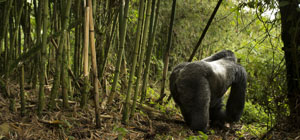 Several of the closer gorilla groups have been deep in the bamboo forest, generally the least auspicious area for photography. Kwitonda was reported to still be below the bamboo belt and we decided to return to that group, and today the trekking was extremely easy, about a 2 on a scale of 10.
Several of the closer gorilla groups have been deep in the bamboo forest, generally the least auspicious area for photography. Kwitonda was reported to still be below the bamboo belt and we decided to return to that group, and today the trekking was extremely easy, about a 2 on a scale of 10.
When we started our shoot we worried that this would be a repeat of yesterday for the gorillas did not stay long at any spot and much of our time was simply spent following the group. Early on, soon after meeting the gorillas we did have a family group in the open,
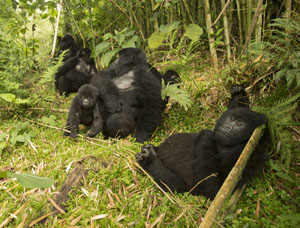
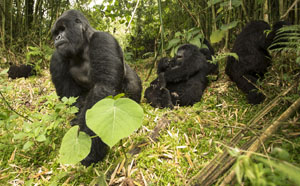
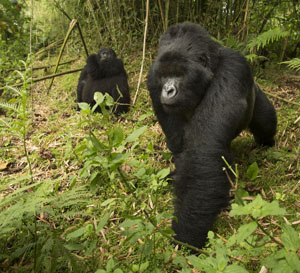
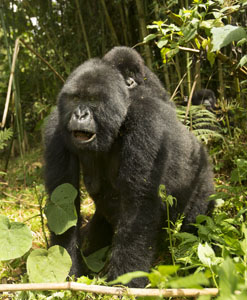
The family group in the first clearing.
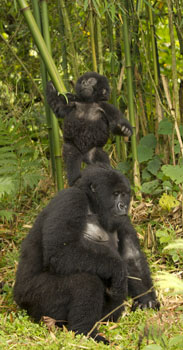
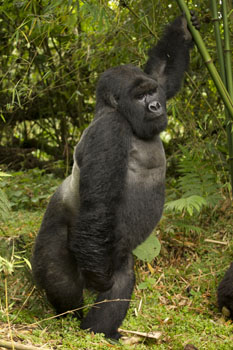
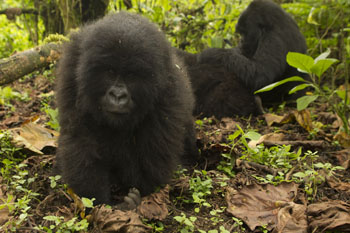
Mary's Kwitonda Portfolio
which provided a few nervous moments. One gorilla rushed right by me, and a mother gaped and vocalized at another, quite close to where I squatted in the vegetation. Soon all moved on and we began our chase.
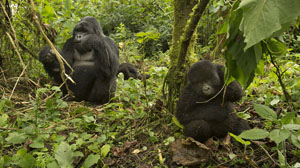
Kwitonda has three silverbacks and we ended up photographing at least two of them. One settled in an opening in good, soft light where a few juveniles rolled about or lounged nearby. Our trackers found another couple from the family group and, as they were near enough, we were able to split, with Mary and a few others going to the others while I stayed with the silverback. Mary’s group had a few very inquisitive juveniles, which she shot while lying prone upon the forest floor, providing a unique perspective with her wide-angle.
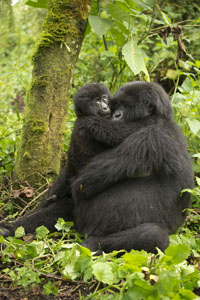
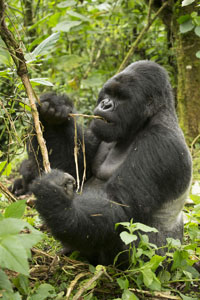
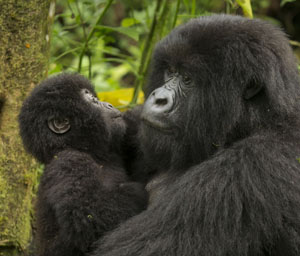
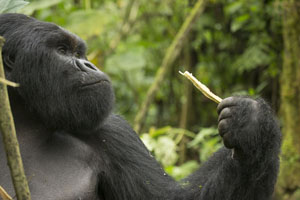
In a clearing in the bamboo forest we had great luck with a
mother and baby and, in another clearing, a silverback feeding
upon bamboo, sometimes with a baby close by.
The light stayed soft throughout the shoot although this ‘ideal’ light would have been deadly back in the film days, as our speeds were sometimes 1/250th at f2.8 with ISO 200! Yesterday, Dee Ann photographed a silverback at the end of the shoot when the gorilla was in the deep shade of the bamboo during the rains. She was using ISO 3200 and had an exposure of f4 at 1/10th! That’s dark, but she did manage a nice portrait nonetheless.
Cloud cover built up and storms looked likely for the afternoon as we headed back to the lodge.
Day 6. Sabyinyo Group
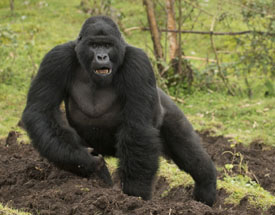 This was our last day and since it marked our 75th mountain gorilla trek the park, our outfitter, and the hotel were going to do some type of ceremony. Accordingly, we planned on doing a shorter trek so that we’d be back early enough for the celebration and to return to Kilgali that evening. Since the Sabyinyo group was our very first gorilla group we visited 10 years ago we thought it appropriate to finish this milestone trek with the same group. It proved an extremely auspicious choice, as this was the best gorilla viewing day we’ve ever had. One of the ‘fantasy photos’ or viewing opportunities we’ve lusted for happened today. It was incredible.
This was our last day and since it marked our 75th mountain gorilla trek the park, our outfitter, and the hotel were going to do some type of ceremony. Accordingly, we planned on doing a shorter trek so that we’d be back early enough for the celebration and to return to Kilgali that evening. Since the Sabyinyo group was our very first gorilla group we visited 10 years ago we thought it appropriate to finish this milestone trek with the same group. It proved an extremely auspicious choice, as this was the best gorilla viewing day we’ve ever had. One of the ‘fantasy photos’ or viewing opportunities we’ve lusted for happened today. It was incredible.
One large lenticular cloud covered Muhabora volcano at dawn, with a thick band of clouds covering much of the east. By the time we started our drive to Sabyinyo the sky was completely covered in clouds and rain seemed imminent. Our gorilla guide wanted to stall as much as he could so that a film crew from Kilgali would have time to meet us as we left the forest at the end of the trek. As we approached the wall marking the park boundary we learned that the gorillas were in the fields eating eucalyptus and we were given a choice – visit the gorillas at the grove or wait until they returned to the trees. Since rain seemed imminent we chose the grove, and it was a wise choice.
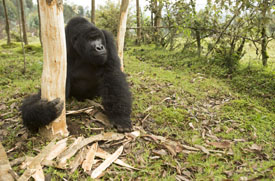 As we approached we could see the black shapes of gorillas moving through the eucalyptus orchard, moving rather fast as they paralleled the wall. One silverback was visible, and his white saddle, marking the silverback, glowed brightly even from a distance. A few minutes later he rounded the crest of a hill and for a few seconds stood in stark outline against the clouds and distant volcanic slopes. We were too far away for a photo, and unprepared, but the vision simply burned into our psyche.
As we approached we could see the black shapes of gorillas moving through the eucalyptus orchard, moving rather fast as they paralleled the wall. One silverback was visible, and his white saddle, marking the silverback, glowed brightly even from a distance. A few minutes later he rounded the crest of a hill and for a few seconds stood in stark outline against the clouds and distant volcanic slopes. We were too far away for a photo, and unprepared, but the vision simply burned into our psyche.
By the time we reached the gorillas they seemed settled down, busily chewing away at the eucalyptus tree bark like beavers, with 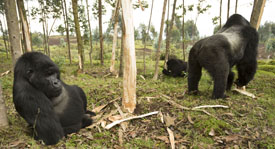 two different silverbacks and several juveniles munching away.
two different silverbacks and several juveniles munching away.
The gorillas slowly moved down through the grove and it seemed as if they settled down now that we were amongst them. I might be wrong but I felt as if they were uncomfortable and thus moving fast when they were alone, but now, in the presence of a tourist group, they regained their confidence and relaxed. We were surrounded by gorillas, with silverbacks, mothers with young babies, and subadults everywhere. At one point Guhonda climbed a 4 inch thick
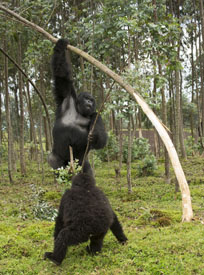
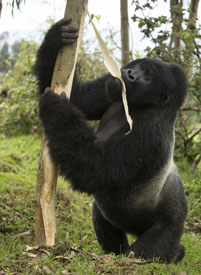
A silverback pulled down a six inch thick eucalyptus
tree, although just moments earlier it had girdled
and stripped off the bark of several other trees.
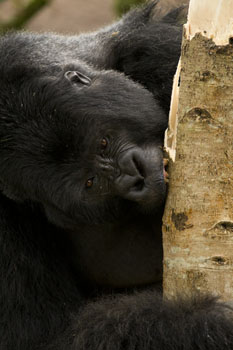
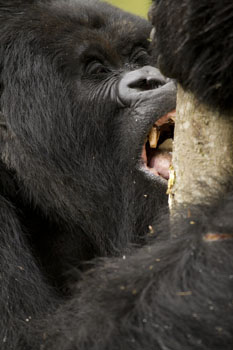
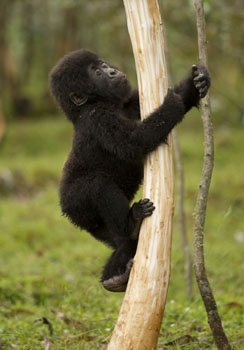
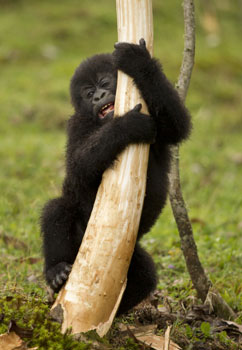
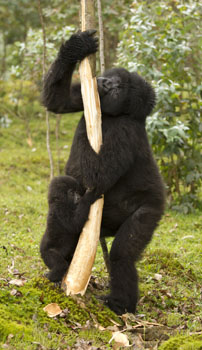
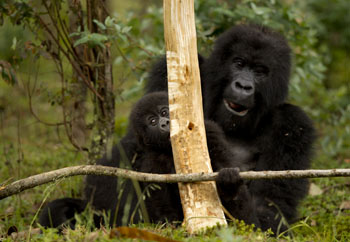
Mary's Sabyinyo Portfolio, where she concentrated
upon the details of a silverback working at the tree bark and pulp
and
a mother and baby at several other trees.
eucalyptus tree, going quite high until his weight caused the tree to bow, as he shifted his stance and, hanging by his arms, rode the tree to the ground where it was basically uprooted. After what seemed to be a very long time the gorillas, one by one, moved by us and began to follow the edge of the boundary wall.
Near the wall the group came upon a papaya tree and the silverbacks and several females and subadults basically went crazy. One black gorilla was feeding and a silverback, further back, started screaming and roaring in annoyance. Other silverbacks poured out of the forest and an altercation seemed likely but the group settled down. Then it got really interesting.
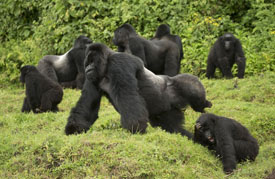
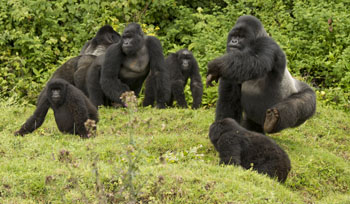
One of the silverbacks from Sabyinyo charges about,
almost stomping upon a juvenile who huddles and screams in fear.
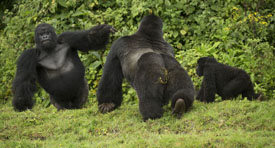
The two silverbacks from Sabyinyo and Hirwa have a brief confrontation, consisting only of arm swipes at one another. A juvenile of Sabyinyo fearlessly approaches and screams and grimaces in annoyance.
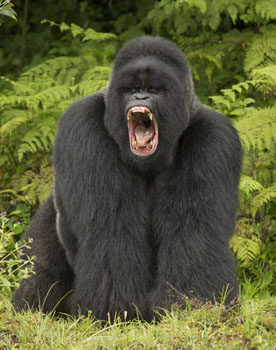
We were told that the Hirwa group was moving in our direction. One of the Sabyinyo gorillas spotted the silverback, Mumyinya, moving across the top of the field. Mumyinya is a huge gorilla and seemed quite confident as he advanced. The three silverbacks in Sabyinyo, including Guhonda, all started posturing and advancing and a fight or confrontation seemed seconds away.
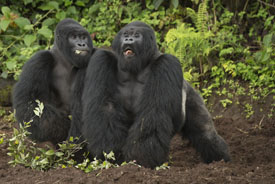
Our guide had us all moved to the edge of a shelf marking one of the farm field tiers. Behind us was a six foot or more drop to the next terrace, and in front of us was the field that abutted the wall. While we watched Mumyinya one of the Sabyinyo silverbacks charged, pounding down the field within a yard of where all of us 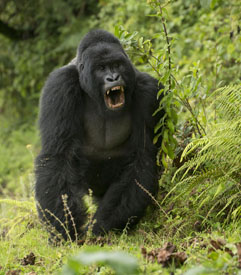 stood. I had placed one of my cameras on the ground and this massive freight train of an animal just missed it as it thundered by.
stood. I had placed one of my cameras on the ground and this massive freight train of an animal just missed it as it thundered by.
Just four days earlier the Sabyinyo group had met the Agasha group, had a confrontation, and from it basically switched territories. Now another clash was about to occur, this time with Sabyinyo’s three silverbacks against the lone, but huge, Mumyinya. The interaction was breath-taking.
Most of the time the two groups simply postured, sometimes quite close to one another as one, or the other, smashed down a small tree or reached to the wall to pull down branches or small trees. The front line moved back and forth, with the Hirwa group giving ground some times, but more frequently the Sabyinyo group slowly lost ground. They charged and thumped and once did an arm swing feint but without making contact. Interestingly, Big Ben, a 6 to 8 year old subadult male, was the first gorilla in the Sabyinyo group to confront Mumyinya, walking up and stopping in front of the large male. As things heated up Ben seemed to disappear.
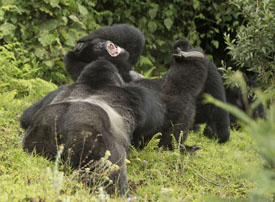 There was one true clash, and from my view it looked as if Mumyinya charged and made contact, while the remaining two silverbacks rushed to the aid of the third. The fight lasted only seconds and I could see no wounds but Mumyinya, even though outnumbered three to one, rarely backed down. Virtually all of his group members followed along behind, including the female with twins which rode upon their mother’s back. The question truly was – where do you look, what do you shoot, there was so much going on.
There was one true clash, and from my view it looked as if Mumyinya charged and made contact, while the remaining two silverbacks rushed to the aid of the third. The fight lasted only seconds and I could see no wounds but Mumyinya, even though outnumbered three to one, rarely backed down. Virtually all of his group members followed along behind, including the female with twins which rode upon their mother’s back. The question truly was – where do you look, what do you shoot, there was so much going on.
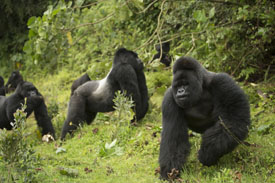 Eventually the two groups split and the Sabyinyo group drifted further down the wall, finally climbing over and disappearing into the forest. Hirwa moved in the opposite direction, the same way we were going to head back, and so we followed behind a short distance until our routes diverged. It seemed clear to us that Mumyinya won this encounter, despite being outnumbered. Our gorilla guide, with 31 years of experience with gorillas has seen about 20 confrontations or fights, but only two in the open like we had. I can’t imagine a better opportunity.
Eventually the two groups split and the Sabyinyo group drifted further down the wall, finally climbing over and disappearing into the forest. Hirwa moved in the opposite direction, the same way we were going to head back, and so we followed behind a short distance until our routes diverged. It seemed clear to us that Mumyinya won this encounter, despite being outnumbered. Our gorilla guide, with 31 years of experience with gorillas has seen about 20 confrontations or fights, but only two in the open like we had. I can’t imagine a better opportunity.
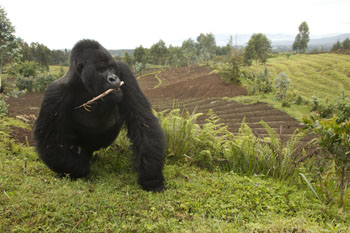
A silverback climbed up onto one of the terraces
unexpectedly and Mary dropped low, shooting the
gorilla as it passed close by with her wide-angle.
On the way back we met the camera crew and stopped for the first of several interviews about our visits to the gorillas and Rwanda. At 1PM we had a quick lunch – despite the planned festivities and the number of people attending the hotel planned poorly for our lunch and ran out of almost all the sought-after foods. By 2 we were assembled in the grasses where chairs were placed for the ceremony, facing the Sabyinyo volcano and the dance group assembled here. 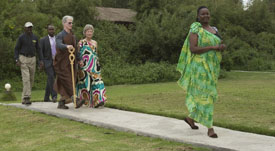 Mary and I were summoned to our room where we were dressed with kikoy wraps and me carrying a staff. We were instructed to come out slowly and stately, which we did, much to the amusement and/or delight of our participants and the other onlookers.
Mary and I were summoned to our room where we were dressed with kikoy wraps and me carrying a staff. We were instructed to come out slowly and stately, which we did, much to the amusement and/or delight of our participants and the other onlookers.
In the first two of the three images, Mary and I are leaving our cottage to the ceremonial coronation, king and queen for the day, marking our 75th trek. The bottom image shows the two of us with our crowns (mine weighed nearly 4 pounds) and the lodge and outiftter owners, respectively.
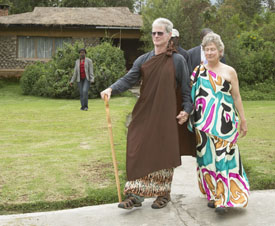 What followed was a real celebration, marked by a crowning ceremony – Mary with a striking beaded ornamental headband and necklace, and me with a goathair headband crown, and numerous speeches. An advancing storm cut our outdoor activities short and we moved back into the dining area where there were more speeches, an exchange of gifts (we gave the park and outfitter, and our two favorite guides gorilla prints; we received our outfitter’s team shirt signed by the entire guide staff and a beautiful woven disk), and more speeches of appreciation. A cake was brought out and we did our ‘cah-tah’ routine of cake cutting and eating, and more speeches. Everything ended by 5 and we did the long drive
What followed was a real celebration, marked by a crowning ceremony – Mary with a striking beaded ornamental headband and necklace, and me with a goathair headband crown, and numerous speeches. An advancing storm cut our outdoor activities short and we moved back into the dining area where there were more speeches, an exchange of gifts (we gave the park and outfitter, and our two favorite guides gorilla prints; we received our outfitter’s team shirt signed by the entire guide staff and a beautiful woven disk), and more speeches of appreciation. A cake was brought out and we did our ‘cah-tah’ routine of cake cutting and eating, and more speeches. Everything ended by 5 and we did the long drive 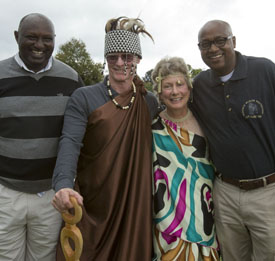 back to Kilgali in the dark, completely worn out from a spectacular day of gorilla viewing and photography and an afternoon of celebration.
back to Kilgali in the dark, completely worn out from a spectacular day of gorilla viewing and photography and an afternoon of celebration.
On this monumental day we’d rate the actual trek about a 2 on our 1 to 10 scale, and a 20 on our 1 to 10 gorilla viewing scale, as the two encounters, the one in the eucalyptus grove and the other with the confrontation, were both truly 10s. It was a wonderful way to end our five days of trekking and, more significantly, marking our 75th trek.
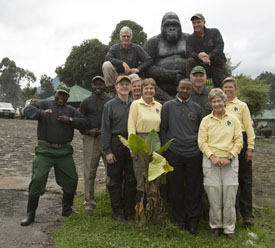
Our Group, left to right, bottom row:
Our gorilla guide; Alex, our guide; Don, Larry,
Judy, Anaclid the head of the guides, Sean, Mary, and Dee Ann.
Top Row: Joe, a gorilla statue, and Byron.
Check out our Previous Trip Reports: 2010, 2011, January 2012, October 2012
Read the Brochure.
For more images, check out our 2011 web gallery of this shoot!
Visit our Trip and Scouting Report Pages for more images and an even better idea of what our trips to the Pantanal are like. There you'll find our archived reports from previous years.
Trip Report:
The Mountain Gorillas of Rwanda
Trip 2,
November 2012

This trip marked our 71st to 75th Mountain Gorilla Trek, and our 75th trek became the most exciting, action-packed, and rewarding trek we ever had. One would think that with 75 treks (the world record, by the way!) we'd have seen and photographed everything possible but that simply isn't true. Each trek is a new experience and has the potential, as the 75th trek showed, of an incredible experience.
That afternoon the lodge, our outfitter, and the National Park held a wonderful event celebrating the completion of our landmark 75th trek. Perhaps making it even more special, Mary had had a total knee replacement on June 29th, just 5 months earlier.
 One of our participants really said it best. He noted that you really don't get a fair idea of how big these animals are, how intimate the experience is, and how great the experience is until you've done it. Pictures, no matter how wonderful, simply do not truly convey the uniqueness, the wonder and awe, of this experience.
One of our participants really said it best. He noted that you really don't get a fair idea of how big these animals are, how intimate the experience is, and how great the experience is until you've done it. Pictures, no matter how wonderful, simply do not truly convey the uniqueness, the wonder and awe, of this experience.
We'll be doing many more Rwanda Mountain Gorilla treks and we'd urge you to join us ... there is nothing like it in the natural world.
If you are interested, please read our Brochure and our other trip reports to get a great idea of the incredible opportunities a Rwanda Mountain Gorilla Trek offers.
Check out our Previous Trip Reports: 2010, 2011, January 2012, October 2012
What follows it the complete report.
Day 1. Our flight from Nairobi to Kilgali, Rwanda went uneventfully but our lunch, upon arrival, was marked by an incredible storm. From our open air restaurant we could hear the storm advancing over the city, as the countless tin roofed structures created a pounding, drumbeat as the storm advanced. Our restaurant had a metal roof as well and through much of the meal we were silent as the drumming rain made speaking almost impossible.
Our drive to our lodge went smoothly as the rains had stopped and, surprisingly, there was little evidence of the storm. As we reached the lodge, however, the rains began again, coming down in driving sheets that stopped just as we headed to our rooms. It rained through much of the evening and into the night and we worried that we’d face rains on our first day of trekking.
Day 2. Sabyinyo Group

Scattered clouds covered the volcanoes to the east, reflecting a pleasing orange in the predawn light, a visual that should have been captured as an image. We had our group assigned and our briefing at park headquarters and headed out to Sabyinyo. Some clouds covered the volcano slopes but the eastern sky and much of the sky above us was clear and we hoped that the clouds would build up to a pleasant canopy by the time we did our shoot.



We love using wide-angle lenses when we can to incorporate the landscape. Bright sunlight can create terrible contrast but in an opening, with the sky included, the light worked. In thick bamboo the shutter speeds are slow, especially when the hoped-for clouds block out the sun.
For the most part it did not and for much of the shoot, in fact the first half, the sun was bright and the contrast was simply terrible. I had borrowed another DX camera from my friend Bill as my DX’s LCD monitor had died and I did not want to do the shoot without having some reference to check exposures. The Sabyinyo group of  gorillas was in a fairly open glade amongst the bamboo, but most of the group, most times, were in the shade along the edges. A young gorilla, about 8 months old, repeatedly climbed a couple of bamboo stalks, and occasionally a cloud offered some shade, and good shooting, for a brief time.
gorillas was in a fairly open glade amongst the bamboo, but most of the group, most times, were in the shade along the edges. A young gorilla, about 8 months old, repeatedly climbed a couple of bamboo stalks, and occasionally a cloud offered some shade, and good shooting, for a brief time.



Mary's Sabyinyo Portfolio
The crazy Black-back, Shirimpumu, of the group was surprisingly well behaved, actually somewhat disappointingly so as his antics do create some excitement on a shoot. Guhonda, the 42 year old silverback and perhaps the largest in all the Virungas, made several appearances and at one point disciplined a juvenile or a female, pouncing on the smaller ape and apparently mauling it, but actually not creating any wounds.


His son, a twenty year old silverback, now disputes ownership of the family, creating tension at times. Our guide told us that this silverback, Gihishamosisi, often prevents Guhonda from mating. Last trip, however, Guhonda severely punished this other silverback for getting one of the babies in trouble, being caught in a snare. We could see the now healing wound on his shoulder.
Towards the end of the shoot Gihishamosisi walked right through our group, almost brushing shoulders with two of us as it went by.


Guhonda left, too, and we followed him into the bamboo where we had our final few minutes as he sat in the shade of the bamboo, fully in the open, and later, standing in the classic silverback pose.
 We were finished our shoot by 10:50 or so, and returned to the vehicle by 11:45. The volcanoes behind us were framed by ominous black storm clouds and, as we walked back we had the soft, cloudy-bright light we hoped for on the shoot. By 2 the storms reached our lodge and the day, once bright, is again dreary, dark, and very damp.
We were finished our shoot by 10:50 or so, and returned to the vehicle by 11:45. The volcanoes behind us were framed by ominous black storm clouds and, as we walked back we had the soft, cloudy-bright light we hoped for on the shoot. By 2 the storms reached our lodge and the day, once bright, is again dreary, dark, and very damp.
Day 3. Kwitonda
 Clouds covered the volcanoes at dawn and we worried that we might have rain early in the trek but by the time we started our worries were reversed – we hoped that the patches of blue sky would pass. Our guide drove our vehicle within a quarter mile of the stone fence that marks the park and the trek across the fields went fast, almost too fast as we hoped that the longer we waited the more likely the clouds would come. The trek through the forest was more difficult than yesterday, with a gradual uphill climb but through thick vegetation, often cut fresh with machetes. We met the trackers in a clearing amidst extremely thick vegetation, but shrub-like, and we hoped when we reached the gorillas we’d find them in a clearing.
Clouds covered the volcanoes at dawn and we worried that we might have rain early in the trek but by the time we started our worries were reversed – we hoped that the patches of blue sky would pass. Our guide drove our vehicle within a quarter mile of the stone fence that marks the park and the trek across the fields went fast, almost too fast as we hoped that the longer we waited the more likely the clouds would come. The trek through the forest was more difficult than yesterday, with a gradual uphill climb but through thick vegetation, often cut fresh with machetes. We met the trackers in a clearing amidst extremely thick vegetation, but shrub-like, and we hoped when we reached the gorillas we’d find them in a clearing.
 Indeed we did find a small family group parked in a clearing where four or five gorillas clumped together, posing nicely. Others climbed bamboo or tall trees in the background, but the contrast there was simply too great. By the time we reached the gorillas the clouds did arrive, making for wonderful cloudy bright conditions. Eventually the group moved off and we followed, looking for another opportunity.
Indeed we did find a small family group parked in a clearing where four or five gorillas clumped together, posing nicely. Others climbed bamboo or tall trees in the background, but the contrast there was simply too great. By the time we reached the gorillas the clouds did arrive, making for wonderful cloudy bright conditions. Eventually the group moved off and we followed, looking for another opportunity.



The first several minutes of this shoot were productive, with a family group posing together as well as both juveniles and a baby performing for us in the open.





Mary's Kwitonda Portfolio
 We found the dominant silverback sitting in a clearing, and through the rest of the shoot some females and babies moved in to join him. Our shooting, for the most part, comprised doing a semi-circle around the male. Towards the end of the shoot first one baby, then another slightly younger, joined the silverback and climbed atop his back. The first one to arrive slapped the male repeatedly across the silver back, but the male never flinched.
We found the dominant silverback sitting in a clearing, and through the rest of the shoot some females and babies moved in to join him. Our shooting, for the most part, comprised doing a semi-circle around the male. Towards the end of the shoot first one baby, then another slightly younger, joined the silverback and climbed atop his back. The first one to arrive slapped the male repeatedly across the silver back, but the male never flinched.


When the other arrived they wrestled, and at one point the older of the two stood on the silverback’s back and did his own chest thumping. As our hour progressed the shooting only got better and more intense, but fortunately the babies finally got off the silverback and, in a moment of relative calm, we were forced to leave as our time was up.



Portraits of a silverback and a juvenile being groomed. Below, a silverback disciplines a female, a fast charge that was extremely exciting to watch.
 Heavy black clouds crept in again but we did not have rain, and by 3PM, although the tops of the volcanoes are lost in cloud, it had not rained. Most of the group went out with our guide for some landscapes and people photography, although Don, Mary, and I stayed back to catch up on various things. By 4:15 the rains began again, continuing through most of the evening as a drizzle.
Heavy black clouds crept in again but we did not have rain, and by 3PM, although the tops of the volcanoes are lost in cloud, it had not rained. Most of the group went out with our guide for some landscapes and people photography, although Don, Mary, and I stayed back to catch up on various things. By 4:15 the rains began again, continuing through most of the evening as a drizzle.
Day 4. Agasha
 Some clouds covered Sabyinyo and Muhabura volcanoes and, by 5:45AM, beautiful color lit up the sky, the clouds, and the volcano slopes. In this early, hard angular light the fluted, convoluted slopes of the volcanoes can clearly be seen, parallel ridges that extend from the base high up onto the slopes. Seeing these, one can easily envision these mountains in more active times.
Some clouds covered Sabyinyo and Muhabura volcanoes and, by 5:45AM, beautiful color lit up the sky, the clouds, and the volcano slopes. In this early, hard angular light the fluted, convoluted slopes of the volcanoes can clearly be seen, parallel ridges that extend from the base high up onto the slopes. Seeing these, one can easily envision these mountains in more active times.
Our hike to the forest wall was short and easy but once inside the lava rock fence the trail grew steep as we climbed continuously through the dark, dank bamboo forest. We were told that the hike would take nearly an hour and we hoped that, with that climb, we’d find the gorillas outside of this deadly bamboo belt.
Normally, by 9:30 or so we’re with the gorillas but not today, as we skirted along the topographic line following the clearings and skirting the distant wall. In another 45 minutes or so we encountered the gorillas, but they were in thick cover, in an open glade so thickly vegetated that gorillas inside the brush were virtually invisible. By 10:30 we found a female atop a nest and the silverback nearby but neither stayed long and the entire troop slowly worked their way downhill. We followed, as best we could, negotiating over the slippery stems and roots of the meadow vegetation, sometimes brushing against the flat leaves or hairy stems of the innumerable stinging nettle bushes lining the trail.


A silverback feeds upon thistle flowers.

We had the Silverback once in an opening where he was feeding upon the flowers of thistles. A few weeks ago one of the babies in the group had been caught by a snare, requiring a veterinarian to tranquilize the baby. Agasha, the silverback, was quite upset and for the next several days charged any visitors, effectively closing down this group to tourism. We were cautioned not to point our monopods, as they might look like a dart gun and trigger some aggression from the male. He moved within a few minutes and what followed was a long, winding route through nettles, bamboo, thick brush, bamboo tunnels, and slippery roots as we slowly descended the mountain. Sometimes the silverback would just be a few yards in front of us, as if he was about to stop and rest, while at other times we’d need to step off the trail to let a mother, with a baby riding her back, stride by.
 Eventually we reached the lava rock boundary wall again where, scattered about at various eucalyptus trees, most of the gorilla family were huddled, busily chewing at the bark. The silverback paused in an opening on the park side of the fence, offering a wonderful view as several of his family passed beside him. He moved on and we followed, expecting him to climb over the stone fence and join the majority of his group.
Eventually we reached the lava rock boundary wall again where, scattered about at various eucalyptus trees, most of the gorilla family were huddled, busily chewing at the bark. The silverback paused in an opening on the park side of the fence, offering a wonderful view as several of his family passed beside him. He moved on and we followed, expecting him to climb over the stone fence and join the majority of his group.



We lost sight of the silverback momentarily and then, before us in a wide gap in the trail, he strode passed, offering just a brief glimpse of his massive forearms and a flash of his silver back. A second later a female passed, then another and another, and that viewing, offering no shots and lasting just a moment, was a quintessential experience – a tantalizing glimpse of wild gorillas, not a stoic, static primate sitting before us. He continued through the forest and we changed course, deciding on going for the large number of gorillas still feeding outside the wall.
 We crossed at a true barrier, climbing up and over with some difficulty. As the last people made the climb the gorillas began to pass, walking or stepping rapidly by, moving on to another clump of eucalyptus trees. We had one wonderful session with a female that stood and climbed a tree, opening her mouth wide at times to rake her incisors down, scraping away at the soft pulp beneath the bark. At one point, as Judy and I photographed, another gorilla unexpectedly walked right between us, just inches away, as it continued downhill to join another at a tree.
We crossed at a true barrier, climbing up and over with some difficulty. As the last people made the climb the gorillas began to pass, walking or stepping rapidly by, moving on to another clump of eucalyptus trees. We had one wonderful session with a female that stood and climbed a tree, opening her mouth wide at times to rake her incisors down, scraping away at the soft pulp beneath the bark. At one point, as Judy and I photographed, another gorilla unexpectedly walked right between us, just inches away, as it continued downhill to join another at a tree.
 The group fed and moved, paused for some bark or to tear off a eucalyptus branch, and moving on again, slowly working their way back to the lave rock wall. As the last gorilla climbed back over the wall the mist and low clouds we had all morning finally transitioned into a misting rain. We found a low breach in the wall and moved back into the forest as the rain intensified. The silverback sat beneath a canopy of bamboo inside but with the rain and an advancing fog the light had dropped to near night conditions. Shooting was impossible, or a waste of time and a threat to our equipment, and we called a halt to the shoot. Our porters joined us within minutes and, in a serious rain, we hiked back to our vehicle for a wet ride home.
The group fed and moved, paused for some bark or to tear off a eucalyptus branch, and moving on again, slowly working their way back to the lave rock wall. As the last gorilla climbed back over the wall the mist and low clouds we had all morning finally transitioned into a misting rain. We found a low breach in the wall and moved back into the forest as the rain intensified. The silverback sat beneath a canopy of bamboo inside but with the rain and an advancing fog the light had dropped to near night conditions. Shooting was impossible, or a waste of time and a threat to our equipment, and we called a halt to the shoot. Our porters joined us within minutes and, in a serious rain, we hiked back to our vehicle for a wet ride home.
Day 5. Kwitonda
 The volcanoes were capped with clouds at dawn and, as the sun cleared the horizon, we had the most spectacular sunrise landscape of the trip. Muhabura, the furthest volcano to the northeast, was topped by puffy clouds that caught the yellow-orange light brilliantly. As the early morning progressed we worried that our day would be too bright, as the eastern sky was clear of clouds. By 8 cloud cover began to build over all of the volcanic peaks and as we started our trek much of the sky was covered with a light veil of clouds.
The volcanoes were capped with clouds at dawn and, as the sun cleared the horizon, we had the most spectacular sunrise landscape of the trip. Muhabura, the furthest volcano to the northeast, was topped by puffy clouds that caught the yellow-orange light brilliantly. As the early morning progressed we worried that our day would be too bright, as the eastern sky was clear of clouds. By 8 cloud cover began to build over all of the volcanic peaks and as we started our trek much of the sky was covered with a light veil of clouds.
 Several of the closer gorilla groups have been deep in the bamboo forest, generally the least auspicious area for photography. Kwitonda was reported to still be below the bamboo belt and we decided to return to that group, and today the trekking was extremely easy, about a 2 on a scale of 10.
Several of the closer gorilla groups have been deep in the bamboo forest, generally the least auspicious area for photography. Kwitonda was reported to still be below the bamboo belt and we decided to return to that group, and today the trekking was extremely easy, about a 2 on a scale of 10.
When we started our shoot we worried that this would be a repeat of yesterday for the gorillas did not stay long at any spot and much of our time was simply spent following the group. Early on, soon after meeting the gorillas we did have a family group in the open,




The family group in the first clearing.



Mary's Kwitonda Portfolio
which provided a few nervous moments. One gorilla rushed right by me, and a mother gaped and vocalized at another, quite close to where I squatted in the vegetation. Soon all moved on and we began our chase.

Kwitonda has three silverbacks and we ended up photographing at least two of them. One settled in an opening in good, soft light where a few juveniles rolled about or lounged nearby. Our trackers found another couple from the family group and, as they were near enough, we were able to split, with Mary and a few others going to the others while I stayed with the silverback. Mary’s group had a few very inquisitive juveniles, which she shot while lying prone upon the forest floor, providing a unique perspective with her wide-angle.




In a clearing in the bamboo forest we had great luck with a
mother and baby and, in another clearing, a silverback feeding
upon bamboo, sometimes with a baby close by.
The light stayed soft throughout the shoot although this ‘ideal’ light would have been deadly back in the film days, as our speeds were sometimes 1/250th at f2.8 with ISO 200! Yesterday, Dee Ann photographed a silverback at the end of the shoot when the gorilla was in the deep shade of the bamboo during the rains. She was using ISO 3200 and had an exposure of f4 at 1/10th! That’s dark, but she did manage a nice portrait nonetheless.
Cloud cover built up and storms looked likely for the afternoon as we headed back to the lodge.
Day 6. Sabyinyo Group
 This was our last day and since it marked our 75th mountain gorilla trek the park, our outfitter, and the hotel were going to do some type of ceremony. Accordingly, we planned on doing a shorter trek so that we’d be back early enough for the celebration and to return to Kilgali that evening. Since the Sabyinyo group was our very first gorilla group we visited 10 years ago we thought it appropriate to finish this milestone trek with the same group. It proved an extremely auspicious choice, as this was the best gorilla viewing day we’ve ever had. One of the ‘fantasy photos’ or viewing opportunities we’ve lusted for happened today. It was incredible.
This was our last day and since it marked our 75th mountain gorilla trek the park, our outfitter, and the hotel were going to do some type of ceremony. Accordingly, we planned on doing a shorter trek so that we’d be back early enough for the celebration and to return to Kilgali that evening. Since the Sabyinyo group was our very first gorilla group we visited 10 years ago we thought it appropriate to finish this milestone trek with the same group. It proved an extremely auspicious choice, as this was the best gorilla viewing day we’ve ever had. One of the ‘fantasy photos’ or viewing opportunities we’ve lusted for happened today. It was incredible.
One large lenticular cloud covered Muhabora volcano at dawn, with a thick band of clouds covering much of the east. By the time we started our drive to Sabyinyo the sky was completely covered in clouds and rain seemed imminent. Our gorilla guide wanted to stall as much as he could so that a film crew from Kilgali would have time to meet us as we left the forest at the end of the trek. As we approached the wall marking the park boundary we learned that the gorillas were in the fields eating eucalyptus and we were given a choice – visit the gorillas at the grove or wait until they returned to the trees. Since rain seemed imminent we chose the grove, and it was a wise choice.
 As we approached we could see the black shapes of gorillas moving through the eucalyptus orchard, moving rather fast as they paralleled the wall. One silverback was visible, and his white saddle, marking the silverback, glowed brightly even from a distance. A few minutes later he rounded the crest of a hill and for a few seconds stood in stark outline against the clouds and distant volcanic slopes. We were too far away for a photo, and unprepared, but the vision simply burned into our psyche.
As we approached we could see the black shapes of gorillas moving through the eucalyptus orchard, moving rather fast as they paralleled the wall. One silverback was visible, and his white saddle, marking the silverback, glowed brightly even from a distance. A few minutes later he rounded the crest of a hill and for a few seconds stood in stark outline against the clouds and distant volcanic slopes. We were too far away for a photo, and unprepared, but the vision simply burned into our psyche.
By the time we reached the gorillas they seemed settled down, busily chewing away at the eucalyptus tree bark like beavers, with  two different silverbacks and several juveniles munching away.
two different silverbacks and several juveniles munching away.
The gorillas slowly moved down through the grove and it seemed as if they settled down now that we were amongst them. I might be wrong but I felt as if they were uncomfortable and thus moving fast when they were alone, but now, in the presence of a tourist group, they regained their confidence and relaxed. We were surrounded by gorillas, with silverbacks, mothers with young babies, and subadults everywhere. At one point Guhonda climbed a 4 inch thick


A silverback pulled down a six inch thick eucalyptus
tree, although just moments earlier it had girdled
and stripped off the bark of several other trees.






Mary's Sabyinyo Portfolio, where she concentrated
upon the details of a silverback working at the tree bark and pulp
and
a mother and baby at several other trees.
eucalyptus tree, going quite high until his weight caused the tree to bow, as he shifted his stance and, hanging by his arms, rode the tree to the ground where it was basically uprooted. After what seemed to be a very long time the gorillas, one by one, moved by us and began to follow the edge of the boundary wall.
Near the wall the group came upon a papaya tree and the silverbacks and several females and subadults basically went crazy. One black gorilla was feeding and a silverback, further back, started screaming and roaring in annoyance. Other silverbacks poured out of the forest and an altercation seemed likely but the group settled down. Then it got really interesting.


One of the silverbacks from Sabyinyo charges about,
almost stomping upon a juvenile who huddles and screams in fear.

The two silverbacks from Sabyinyo and Hirwa have a brief confrontation, consisting only of arm swipes at one another. A juvenile of Sabyinyo fearlessly approaches and screams and grimaces in annoyance.

We were told that the Hirwa group was moving in our direction. One of the Sabyinyo gorillas spotted the silverback, Mumyinya, moving across the top of the field. Mumyinya is a huge gorilla and seemed quite confident as he advanced. The three silverbacks in Sabyinyo, including Guhonda, all started posturing and advancing and a fight or confrontation seemed seconds away.

Our guide had us all moved to the edge of a shelf marking one of the farm field tiers. Behind us was a six foot or more drop to the next terrace, and in front of us was the field that abutted the wall. While we watched Mumyinya one of the Sabyinyo silverbacks charged, pounding down the field within a yard of where all of us  stood. I had placed one of my cameras on the ground and this massive freight train of an animal just missed it as it thundered by.
stood. I had placed one of my cameras on the ground and this massive freight train of an animal just missed it as it thundered by.
Just four days earlier the Sabyinyo group had met the Agasha group, had a confrontation, and from it basically switched territories. Now another clash was about to occur, this time with Sabyinyo’s three silverbacks against the lone, but huge, Mumyinya. The interaction was breath-taking.
Most of the time the two groups simply postured, sometimes quite close to one another as one, or the other, smashed down a small tree or reached to the wall to pull down branches or small trees. The front line moved back and forth, with the Hirwa group giving ground some times, but more frequently the Sabyinyo group slowly lost ground. They charged and thumped and once did an arm swing feint but without making contact. Interestingly, Big Ben, a 6 to 8 year old subadult male, was the first gorilla in the Sabyinyo group to confront Mumyinya, walking up and stopping in front of the large male. As things heated up Ben seemed to disappear.
 There was one true clash, and from my view it looked as if Mumyinya charged and made contact, while the remaining two silverbacks rushed to the aid of the third. The fight lasted only seconds and I could see no wounds but Mumyinya, even though outnumbered three to one, rarely backed down. Virtually all of his group members followed along behind, including the female with twins which rode upon their mother’s back. The question truly was – where do you look, what do you shoot, there was so much going on.
There was one true clash, and from my view it looked as if Mumyinya charged and made contact, while the remaining two silverbacks rushed to the aid of the third. The fight lasted only seconds and I could see no wounds but Mumyinya, even though outnumbered three to one, rarely backed down. Virtually all of his group members followed along behind, including the female with twins which rode upon their mother’s back. The question truly was – where do you look, what do you shoot, there was so much going on.
 Eventually the two groups split and the Sabyinyo group drifted further down the wall, finally climbing over and disappearing into the forest. Hirwa moved in the opposite direction, the same way we were going to head back, and so we followed behind a short distance until our routes diverged. It seemed clear to us that Mumyinya won this encounter, despite being outnumbered. Our gorilla guide, with 31 years of experience with gorillas has seen about 20 confrontations or fights, but only two in the open like we had. I can’t imagine a better opportunity.
Eventually the two groups split and the Sabyinyo group drifted further down the wall, finally climbing over and disappearing into the forest. Hirwa moved in the opposite direction, the same way we were going to head back, and so we followed behind a short distance until our routes diverged. It seemed clear to us that Mumyinya won this encounter, despite being outnumbered. Our gorilla guide, with 31 years of experience with gorillas has seen about 20 confrontations or fights, but only two in the open like we had. I can’t imagine a better opportunity.

A silverback climbed up onto one of the terraces
unexpectedly and Mary dropped low, shooting the
gorilla as it passed close by with her wide-angle.
On the way back we met the camera crew and stopped for the first of several interviews about our visits to the gorillas and Rwanda. At 1PM we had a quick lunch – despite the planned festivities and the number of people attending the hotel planned poorly for our lunch and ran out of almost all the sought-after foods. By 2 we were assembled in the grasses where chairs were placed for the ceremony, facing the Sabyinyo volcano and the dance group assembled here.  Mary and I were summoned to our room where we were dressed with kikoy wraps and me carrying a staff. We were instructed to come out slowly and stately, which we did, much to the amusement and/or delight of our participants and the other onlookers.
Mary and I were summoned to our room where we were dressed with kikoy wraps and me carrying a staff. We were instructed to come out slowly and stately, which we did, much to the amusement and/or delight of our participants and the other onlookers.
In the first two of the three images, Mary and I are leaving our cottage to the ceremonial coronation, king and queen for the day, marking our 75th trek. The bottom image shows the two of us with our crowns (mine weighed nearly 4 pounds) and the lodge and outiftter owners, respectively.
 What followed was a real celebration, marked by a crowning ceremony – Mary with a striking beaded ornamental headband and necklace, and me with a goathair headband crown, and numerous speeches. An advancing storm cut our outdoor activities short and we moved back into the dining area where there were more speeches, an exchange of gifts (we gave the park and outfitter, and our two favorite guides gorilla prints; we received our outfitter’s team shirt signed by the entire guide staff and a beautiful woven disk), and more speeches of appreciation. A cake was brought out and we did our ‘cah-tah’ routine of cake cutting and eating, and more speeches. Everything ended by 5 and we did the long drive
What followed was a real celebration, marked by a crowning ceremony – Mary with a striking beaded ornamental headband and necklace, and me with a goathair headband crown, and numerous speeches. An advancing storm cut our outdoor activities short and we moved back into the dining area where there were more speeches, an exchange of gifts (we gave the park and outfitter, and our two favorite guides gorilla prints; we received our outfitter’s team shirt signed by the entire guide staff and a beautiful woven disk), and more speeches of appreciation. A cake was brought out and we did our ‘cah-tah’ routine of cake cutting and eating, and more speeches. Everything ended by 5 and we did the long drive  back to Kilgali in the dark, completely worn out from a spectacular day of gorilla viewing and photography and an afternoon of celebration.
back to Kilgali in the dark, completely worn out from a spectacular day of gorilla viewing and photography and an afternoon of celebration.
On this monumental day we’d rate the actual trek about a 2 on our 1 to 10 scale, and a 20 on our 1 to 10 gorilla viewing scale, as the two encounters, the one in the eucalyptus grove and the other with the confrontation, were both truly 10s. It was a wonderful way to end our five days of trekking and, more significantly, marking our 75th trek.

Our Group, left to right, bottom row:
Our gorilla guide; Alex, our guide; Don, Larry,
Judy, Anaclid the head of the guides, Sean, Mary, and Dee Ann.
Top Row: Joe, a gorilla statue, and Byron.
Check out our Previous Trip Reports: 2010, 2011, January 2012, October 2012
Read the Brochure.
For more images, check out our 2011 web gallery of this shoot!
Visit our Trip and Scouting Report Pages for more images and an even better idea of what our trips to the Pantanal are like. There you'll find our archived reports from previous years.
Trip Report:
The Mountain Gorillas of Rwanda
Trip 2,
November 2012

This trip marked our 71st to 75th Mountain Gorilla Trek, and our 75th trek became the most exciting, action-packed, and rewarding trek we ever had. One would think that with 75 treks (the world record, by the way!) we'd have seen and photographed everything possible but that simply isn't true. Each trek is a new experience and has the potential, as the 75th trek showed, of an incredible experience.
That afternoon the lodge, our outfitter, and the National Park held a wonderful event celebrating the completion of our landmark 75th trek. Perhaps making it even more special, Mary had had a total knee replacement on June 29th, just 5 months earlier.
 One of our participants really said it best. He noted that you really don't get a fair idea of how big these animals are, how intimate the experience is, and how great the experience is until you've done it. Pictures, no matter how wonderful, simply do not truly convey the uniqueness, the wonder and awe, of this experience.
One of our participants really said it best. He noted that you really don't get a fair idea of how big these animals are, how intimate the experience is, and how great the experience is until you've done it. Pictures, no matter how wonderful, simply do not truly convey the uniqueness, the wonder and awe, of this experience.
We'll be doing many more Rwanda Mountain Gorilla treks and we'd urge you to join us ... there is nothing like it in the natural world.
If you are interested, please read our Brochure and our other trip reports to get a great idea of the incredible opportunities a Rwanda Mountain Gorilla Trek offers.
Check out our Previous Trip Reports: 2010, 2011, January 2012, October 2012
What follows it the complete report.
Day 1. Our flight from Nairobi to Kilgali, Rwanda went uneventfully but our lunch, upon arrival, was marked by an incredible storm. From our open air restaurant we could hear the storm advancing over the city, as the countless tin roofed structures created a pounding, drumbeat as the storm advanced. Our restaurant had a metal roof as well and through much of the meal we were silent as the drumming rain made speaking almost impossible.
Our drive to our lodge went smoothly as the rains had stopped and, surprisingly, there was little evidence of the storm. As we reached the lodge, however, the rains began again, coming down in driving sheets that stopped just as we headed to our rooms. It rained through much of the evening and into the night and we worried that we’d face rains on our first day of trekking.
Day 2. Sabyinyo Group

Scattered clouds covered the volcanoes to the east, reflecting a pleasing orange in the predawn light, a visual that should have been captured as an image. We had our group assigned and our briefing at park headquarters and headed out to Sabyinyo. Some clouds covered the volcano slopes but the eastern sky and much of the sky above us was clear and we hoped that the clouds would build up to a pleasant canopy by the time we did our shoot.



We love using wide-angle lenses when we can to incorporate the landscape. Bright sunlight can create terrible contrast but in an opening, with the sky included, the light worked. In thick bamboo the shutter speeds are slow, especially when the hoped-for clouds block out the sun.
For the most part it did not and for much of the shoot, in fact the first half, the sun was bright and the contrast was simply terrible. I had borrowed another DX camera from my friend Bill as my DX’s LCD monitor had died and I did not want to do the shoot without having some reference to check exposures. The Sabyinyo group of  gorillas was in a fairly open glade amongst the bamboo, but most of the group, most times, were in the shade along the edges. A young gorilla, about 8 months old, repeatedly climbed a couple of bamboo stalks, and occasionally a cloud offered some shade, and good shooting, for a brief time.
gorillas was in a fairly open glade amongst the bamboo, but most of the group, most times, were in the shade along the edges. A young gorilla, about 8 months old, repeatedly climbed a couple of bamboo stalks, and occasionally a cloud offered some shade, and good shooting, for a brief time.



Mary's Sabyinyo Portfolio
The crazy Black-back, Shirimpumu, of the group was surprisingly well behaved, actually somewhat disappointingly so as his antics do create some excitement on a shoot. Guhonda, the 42 year old silverback and perhaps the largest in all the Virungas, made several appearances and at one point disciplined a juvenile or a female, pouncing on the smaller ape and apparently mauling it, but actually not creating any wounds.


His son, a twenty year old silverback, now disputes ownership of the family, creating tension at times. Our guide told us that this silverback, Gihishamosisi, often prevents Guhonda from mating. Last trip, however, Guhonda severely punished this other silverback for getting one of the babies in trouble, being caught in a snare. We could see the now healing wound on his shoulder.
Towards the end of the shoot Gihishamosisi walked right through our group, almost brushing shoulders with two of us as it went by.


Guhonda left, too, and we followed him into the bamboo where we had our final few minutes as he sat in the shade of the bamboo, fully in the open, and later, standing in the classic silverback pose.
 We were finished our shoot by 10:50 or so, and returned to the vehicle by 11:45. The volcanoes behind us were framed by ominous black storm clouds and, as we walked back we had the soft, cloudy-bright light we hoped for on the shoot. By 2 the storms reached our lodge and the day, once bright, is again dreary, dark, and very damp.
We were finished our shoot by 10:50 or so, and returned to the vehicle by 11:45. The volcanoes behind us were framed by ominous black storm clouds and, as we walked back we had the soft, cloudy-bright light we hoped for on the shoot. By 2 the storms reached our lodge and the day, once bright, is again dreary, dark, and very damp.
Day 3. Kwitonda
 Clouds covered the volcanoes at dawn and we worried that we might have rain early in the trek but by the time we started our worries were reversed – we hoped that the patches of blue sky would pass. Our guide drove our vehicle within a quarter mile of the stone fence that marks the park and the trek across the fields went fast, almost too fast as we hoped that the longer we waited the more likely the clouds would come. The trek through the forest was more difficult than yesterday, with a gradual uphill climb but through thick vegetation, often cut fresh with machetes. We met the trackers in a clearing amidst extremely thick vegetation, but shrub-like, and we hoped when we reached the gorillas we’d find them in a clearing.
Clouds covered the volcanoes at dawn and we worried that we might have rain early in the trek but by the time we started our worries were reversed – we hoped that the patches of blue sky would pass. Our guide drove our vehicle within a quarter mile of the stone fence that marks the park and the trek across the fields went fast, almost too fast as we hoped that the longer we waited the more likely the clouds would come. The trek through the forest was more difficult than yesterday, with a gradual uphill climb but through thick vegetation, often cut fresh with machetes. We met the trackers in a clearing amidst extremely thick vegetation, but shrub-like, and we hoped when we reached the gorillas we’d find them in a clearing.
 Indeed we did find a small family group parked in a clearing where four or five gorillas clumped together, posing nicely. Others climbed bamboo or tall trees in the background, but the contrast there was simply too great. By the time we reached the gorillas the clouds did arrive, making for wonderful cloudy bright conditions. Eventually the group moved off and we followed, looking for another opportunity.
Indeed we did find a small family group parked in a clearing where four or five gorillas clumped together, posing nicely. Others climbed bamboo or tall trees in the background, but the contrast there was simply too great. By the time we reached the gorillas the clouds did arrive, making for wonderful cloudy bright conditions. Eventually the group moved off and we followed, looking for another opportunity.



The first several minutes of this shoot were productive, with a family group posing together as well as both juveniles and a baby performing for us in the open.





Mary's Kwitonda Portfolio
 We found the dominant silverback sitting in a clearing, and through the rest of the shoot some females and babies moved in to join him. Our shooting, for the most part, comprised doing a semi-circle around the male. Towards the end of the shoot first one baby, then another slightly younger, joined the silverback and climbed atop his back. The first one to arrive slapped the male repeatedly across the silver back, but the male never flinched.
We found the dominant silverback sitting in a clearing, and through the rest of the shoot some females and babies moved in to join him. Our shooting, for the most part, comprised doing a semi-circle around the male. Towards the end of the shoot first one baby, then another slightly younger, joined the silverback and climbed atop his back. The first one to arrive slapped the male repeatedly across the silver back, but the male never flinched.


When the other arrived they wrestled, and at one point the older of the two stood on the silverback’s back and did his own chest thumping. As our hour progressed the shooting only got better and more intense, but fortunately the babies finally got off the silverback and, in a moment of relative calm, we were forced to leave as our time was up.



Portraits of a silverback and a juvenile being groomed. Below, a silverback disciplines a female, a fast charge that was extremely exciting to watch.
 Heavy black clouds crept in again but we did not have rain, and by 3PM, although the tops of the volcanoes are lost in cloud, it had not rained. Most of the group went out with our guide for some landscapes and people photography, although Don, Mary, and I stayed back to catch up on various things. By 4:15 the rains began again, continuing through most of the evening as a drizzle.
Heavy black clouds crept in again but we did not have rain, and by 3PM, although the tops of the volcanoes are lost in cloud, it had not rained. Most of the group went out with our guide for some landscapes and people photography, although Don, Mary, and I stayed back to catch up on various things. By 4:15 the rains began again, continuing through most of the evening as a drizzle.
Day 4. Agasha
 Some clouds covered Sabyinyo and Muhabura volcanoes and, by 5:45AM, beautiful color lit up the sky, the clouds, and the volcano slopes. In this early, hard angular light the fluted, convoluted slopes of the volcanoes can clearly be seen, parallel ridges that extend from the base high up onto the slopes. Seeing these, one can easily envision these mountains in more active times.
Some clouds covered Sabyinyo and Muhabura volcanoes and, by 5:45AM, beautiful color lit up the sky, the clouds, and the volcano slopes. In this early, hard angular light the fluted, convoluted slopes of the volcanoes can clearly be seen, parallel ridges that extend from the base high up onto the slopes. Seeing these, one can easily envision these mountains in more active times.
Our hike to the forest wall was short and easy but once inside the lava rock fence the trail grew steep as we climbed continuously through the dark, dank bamboo forest. We were told that the hike would take nearly an hour and we hoped that, with that climb, we’d find the gorillas outside of this deadly bamboo belt.
Normally, by 9:30 or so we’re with the gorillas but not today, as we skirted along the topographic line following the clearings and skirting the distant wall. In another 45 minutes or so we encountered the gorillas, but they were in thick cover, in an open glade so thickly vegetated that gorillas inside the brush were virtually invisible. By 10:30 we found a female atop a nest and the silverback nearby but neither stayed long and the entire troop slowly worked their way downhill. We followed, as best we could, negotiating over the slippery stems and roots of the meadow vegetation, sometimes brushing against the flat leaves or hairy stems of the innumerable stinging nettle bushes lining the trail.


A silverback feeds upon thistle flowers.

We had the Silverback once in an opening where he was feeding upon the flowers of thistles. A few weeks ago one of the babies in the group had been caught by a snare, requiring a veterinarian to tranquilize the baby. Agasha, the silverback, was quite upset and for the next several days charged any visitors, effectively closing down this group to tourism. We were cautioned not to point our monopods, as they might look like a dart gun and trigger some aggression from the male. He moved within a few minutes and what followed was a long, winding route through nettles, bamboo, thick brush, bamboo tunnels, and slippery roots as we slowly descended the mountain. Sometimes the silverback would just be a few yards in front of us, as if he was about to stop and rest, while at other times we’d need to step off the trail to let a mother, with a baby riding her back, stride by.
 Eventually we reached the lava rock boundary wall again where, scattered about at various eucalyptus trees, most of the gorilla family were huddled, busily chewing at the bark. The silverback paused in an opening on the park side of the fence, offering a wonderful view as several of his family passed beside him. He moved on and we followed, expecting him to climb over the stone fence and join the majority of his group.
Eventually we reached the lava rock boundary wall again where, scattered about at various eucalyptus trees, most of the gorilla family were huddled, busily chewing at the bark. The silverback paused in an opening on the park side of the fence, offering a wonderful view as several of his family passed beside him. He moved on and we followed, expecting him to climb over the stone fence and join the majority of his group.



We lost sight of the silverback momentarily and then, before us in a wide gap in the trail, he strode passed, offering just a brief glimpse of his massive forearms and a flash of his silver back. A second later a female passed, then another and another, and that viewing, offering no shots and lasting just a moment, was a quintessential experience – a tantalizing glimpse of wild gorillas, not a stoic, static primate sitting before us. He continued through the forest and we changed course, deciding on going for the large number of gorillas still feeding outside the wall.
 We crossed at a true barrier, climbing up and over with some difficulty. As the last people made the climb the gorillas began to pass, walking or stepping rapidly by, moving on to another clump of eucalyptus trees. We had one wonderful session with a female that stood and climbed a tree, opening her mouth wide at times to rake her incisors down, scraping away at the soft pulp beneath the bark. At one point, as Judy and I photographed, another gorilla unexpectedly walked right between us, just inches away, as it continued downhill to join another at a tree.
We crossed at a true barrier, climbing up and over with some difficulty. As the last people made the climb the gorillas began to pass, walking or stepping rapidly by, moving on to another clump of eucalyptus trees. We had one wonderful session with a female that stood and climbed a tree, opening her mouth wide at times to rake her incisors down, scraping away at the soft pulp beneath the bark. At one point, as Judy and I photographed, another gorilla unexpectedly walked right between us, just inches away, as it continued downhill to join another at a tree.
 The group fed and moved, paused for some bark or to tear off a eucalyptus branch, and moving on again, slowly working their way back to the lave rock wall. As the last gorilla climbed back over the wall the mist and low clouds we had all morning finally transitioned into a misting rain. We found a low breach in the wall and moved back into the forest as the rain intensified. The silverback sat beneath a canopy of bamboo inside but with the rain and an advancing fog the light had dropped to near night conditions. Shooting was impossible, or a waste of time and a threat to our equipment, and we called a halt to the shoot. Our porters joined us within minutes and, in a serious rain, we hiked back to our vehicle for a wet ride home.
The group fed and moved, paused for some bark or to tear off a eucalyptus branch, and moving on again, slowly working their way back to the lave rock wall. As the last gorilla climbed back over the wall the mist and low clouds we had all morning finally transitioned into a misting rain. We found a low breach in the wall and moved back into the forest as the rain intensified. The silverback sat beneath a canopy of bamboo inside but with the rain and an advancing fog the light had dropped to near night conditions. Shooting was impossible, or a waste of time and a threat to our equipment, and we called a halt to the shoot. Our porters joined us within minutes and, in a serious rain, we hiked back to our vehicle for a wet ride home.
Day 5. Kwitonda
 The volcanoes were capped with clouds at dawn and, as the sun cleared the horizon, we had the most spectacular sunrise landscape of the trip. Muhabura, the furthest volcano to the northeast, was topped by puffy clouds that caught the yellow-orange light brilliantly. As the early morning progressed we worried that our day would be too bright, as the eastern sky was clear of clouds. By 8 cloud cover began to build over all of the volcanic peaks and as we started our trek much of the sky was covered with a light veil of clouds.
The volcanoes were capped with clouds at dawn and, as the sun cleared the horizon, we had the most spectacular sunrise landscape of the trip. Muhabura, the furthest volcano to the northeast, was topped by puffy clouds that caught the yellow-orange light brilliantly. As the early morning progressed we worried that our day would be too bright, as the eastern sky was clear of clouds. By 8 cloud cover began to build over all of the volcanic peaks and as we started our trek much of the sky was covered with a light veil of clouds.
 Several of the closer gorilla groups have been deep in the bamboo forest, generally the least auspicious area for photography. Kwitonda was reported to still be below the bamboo belt and we decided to return to that group, and today the trekking was extremely easy, about a 2 on a scale of 10.
Several of the closer gorilla groups have been deep in the bamboo forest, generally the least auspicious area for photography. Kwitonda was reported to still be below the bamboo belt and we decided to return to that group, and today the trekking was extremely easy, about a 2 on a scale of 10.
When we started our shoot we worried that this would be a repeat of yesterday for the gorillas did not stay long at any spot and much of our time was simply spent following the group. Early on, soon after meeting the gorillas we did have a family group in the open,




The family group in the first clearing.



Mary's Kwitonda Portfolio
which provided a few nervous moments. One gorilla rushed right by me, and a mother gaped and vocalized at another, quite close to where I squatted in the vegetation. Soon all moved on and we began our chase.

Kwitonda has three silverbacks and we ended up photographing at least two of them. One settled in an opening in good, soft light where a few juveniles rolled about or lounged nearby. Our trackers found another couple from the family group and, as they were near enough, we were able to split, with Mary and a few others going to the others while I stayed with the silverback. Mary’s group had a few very inquisitive juveniles, which she shot while lying prone upon the forest floor, providing a unique perspective with her wide-angle.




In a clearing in the bamboo forest we had great luck with a
mother and baby and, in another clearing, a silverback feeding
upon bamboo, sometimes with a baby close by.
The light stayed soft throughout the shoot although this ‘ideal’ light would have been deadly back in the film days, as our speeds were sometimes 1/250th at f2.8 with ISO 200! Yesterday, Dee Ann photographed a silverback at the end of the shoot when the gorilla was in the deep shade of the bamboo during the rains. She was using ISO 3200 and had an exposure of f4 at 1/10th! That’s dark, but she did manage a nice portrait nonetheless.
Cloud cover built up and storms looked likely for the afternoon as we headed back to the lodge.
Day 6. Sabyinyo Group
 This was our last day and since it marked our 75th mountain gorilla trek the park, our outfitter, and the hotel were going to do some type of ceremony. Accordingly, we planned on doing a shorter trek so that we’d be back early enough for the celebration and to return to Kilgali that evening. Since the Sabyinyo group was our very first gorilla group we visited 10 years ago we thought it appropriate to finish this milestone trek with the same group. It proved an extremely auspicious choice, as this was the best gorilla viewing day we’ve ever had. One of the ‘fantasy photos’ or viewing opportunities we’ve lusted for happened today. It was incredible.
This was our last day and since it marked our 75th mountain gorilla trek the park, our outfitter, and the hotel were going to do some type of ceremony. Accordingly, we planned on doing a shorter trek so that we’d be back early enough for the celebration and to return to Kilgali that evening. Since the Sabyinyo group was our very first gorilla group we visited 10 years ago we thought it appropriate to finish this milestone trek with the same group. It proved an extremely auspicious choice, as this was the best gorilla viewing day we’ve ever had. One of the ‘fantasy photos’ or viewing opportunities we’ve lusted for happened today. It was incredible.
One large lenticular cloud covered Muhabora volcano at dawn, with a thick band of clouds covering much of the east. By the time we started our drive to Sabyinyo the sky was completely covered in clouds and rain seemed imminent. Our gorilla guide wanted to stall as much as he could so that a film crew from Kilgali would have time to meet us as we left the forest at the end of the trek. As we approached the wall marking the park boundary we learned that the gorillas were in the fields eating eucalyptus and we were given a choice – visit the gorillas at the grove or wait until they returned to the trees. Since rain seemed imminent we chose the grove, and it was a wise choice.
 As we approached we could see the black shapes of gorillas moving through the eucalyptus orchard, moving rather fast as they paralleled the wall. One silverback was visible, and his white saddle, marking the silverback, glowed brightly even from a distance. A few minutes later he rounded the crest of a hill and for a few seconds stood in stark outline against the clouds and distant volcanic slopes. We were too far away for a photo, and unprepared, but the vision simply burned into our psyche.
As we approached we could see the black shapes of gorillas moving through the eucalyptus orchard, moving rather fast as they paralleled the wall. One silverback was visible, and his white saddle, marking the silverback, glowed brightly even from a distance. A few minutes later he rounded the crest of a hill and for a few seconds stood in stark outline against the clouds and distant volcanic slopes. We were too far away for a photo, and unprepared, but the vision simply burned into our psyche.
By the time we reached the gorillas they seemed settled down, busily chewing away at the eucalyptus tree bark like beavers, with  two different silverbacks and several juveniles munching away.
two different silverbacks and several juveniles munching away.
The gorillas slowly moved down through the grove and it seemed as if they settled down now that we were amongst them. I might be wrong but I felt as if they were uncomfortable and thus moving fast when they were alone, but now, in the presence of a tourist group, they regained their confidence and relaxed. We were surrounded by gorillas, with silverbacks, mothers with young babies, and subadults everywhere. At one point Guhonda climbed a 4 inch thick


A silverback pulled down a six inch thick eucalyptus
tree, although just moments earlier it had girdled
and stripped off the bark of several other trees.






Mary's Sabyinyo Portfolio, where she concentrated
upon the details of a silverback working at the tree bark and pulp
and
a mother and baby at several other trees.
eucalyptus tree, going quite high until his weight caused the tree to bow, as he shifted his stance and, hanging by his arms, rode the tree to the ground where it was basically uprooted. After what seemed to be a very long time the gorillas, one by one, moved by us and began to follow the edge of the boundary wall.
Near the wall the group came upon a papaya tree and the silverbacks and several females and subadults basically went crazy. One black gorilla was feeding and a silverback, further back, started screaming and roaring in annoyance. Other silverbacks poured out of the forest and an altercation seemed likely but the group settled down. Then it got really interesting.


One of the silverbacks from Sabyinyo charges about,
almost stomping upon a juvenile who huddles and screams in fear.

The two silverbacks from Sabyinyo and Hirwa have a brief confrontation, consisting only of arm swipes at one another. A juvenile of Sabyinyo fearlessly approaches and screams and grimaces in annoyance.

We were told that the Hirwa group was moving in our direction. One of the Sabyinyo gorillas spotted the silverback, Mumyinya, moving across the top of the field. Mumyinya is a huge gorilla and seemed quite confident as he advanced. The three silverbacks in Sabyinyo, including Guhonda, all started posturing and advancing and a fight or confrontation seemed seconds away.

Our guide had us all moved to the edge of a shelf marking one of the farm field tiers. Behind us was a six foot or more drop to the next terrace, and in front of us was the field that abutted the wall. While we watched Mumyinya one of the Sabyinyo silverbacks charged, pounding down the field within a yard of where all of us  stood. I had placed one of my cameras on the ground and this massive freight train of an animal just missed it as it thundered by.
stood. I had placed one of my cameras on the ground and this massive freight train of an animal just missed it as it thundered by.
Just four days earlier the Sabyinyo group had met the Agasha group, had a confrontation, and from it basically switched territories. Now another clash was about to occur, this time with Sabyinyo’s three silverbacks against the lone, but huge, Mumyinya. The interaction was breath-taking.
Most of the time the two groups simply postured, sometimes quite close to one another as one, or the other, smashed down a small tree or reached to the wall to pull down branches or small trees. The front line moved back and forth, with the Hirwa group giving ground some times, but more frequently the Sabyinyo group slowly lost ground. They charged and thumped and once did an arm swing feint but without making contact. Interestingly, Big Ben, a 6 to 8 year old subadult male, was the first gorilla in the Sabyinyo group to confront Mumyinya, walking up and stopping in front of the large male. As things heated up Ben seemed to disappear.
 There was one true clash, and from my view it looked as if Mumyinya charged and made contact, while the remaining two silverbacks rushed to the aid of the third. The fight lasted only seconds and I could see no wounds but Mumyinya, even though outnumbered three to one, rarely backed down. Virtually all of his group members followed along behind, including the female with twins which rode upon their mother’s back. The question truly was – where do you look, what do you shoot, there was so much going on.
There was one true clash, and from my view it looked as if Mumyinya charged and made contact, while the remaining two silverbacks rushed to the aid of the third. The fight lasted only seconds and I could see no wounds but Mumyinya, even though outnumbered three to one, rarely backed down. Virtually all of his group members followed along behind, including the female with twins which rode upon their mother’s back. The question truly was – where do you look, what do you shoot, there was so much going on.
 Eventually the two groups split and the Sabyinyo group drifted further down the wall, finally climbing over and disappearing into the forest. Hirwa moved in the opposite direction, the same way we were going to head back, and so we followed behind a short distance until our routes diverged. It seemed clear to us that Mumyinya won this encounter, despite being outnumbered. Our gorilla guide, with 31 years of experience with gorillas has seen about 20 confrontations or fights, but only two in the open like we had. I can’t imagine a better opportunity.
Eventually the two groups split and the Sabyinyo group drifted further down the wall, finally climbing over and disappearing into the forest. Hirwa moved in the opposite direction, the same way we were going to head back, and so we followed behind a short distance until our routes diverged. It seemed clear to us that Mumyinya won this encounter, despite being outnumbered. Our gorilla guide, with 31 years of experience with gorillas has seen about 20 confrontations or fights, but only two in the open like we had. I can’t imagine a better opportunity.

A silverback climbed up onto one of the terraces
unexpectedly and Mary dropped low, shooting the
gorilla as it passed close by with her wide-angle.
On the way back we met the camera crew and stopped for the first of several interviews about our visits to the gorillas and Rwanda. At 1PM we had a quick lunch – despite the planned festivities and the number of people attending the hotel planned poorly for our lunch and ran out of almost all the sought-after foods. By 2 we were assembled in the grasses where chairs were placed for the ceremony, facing the Sabyinyo volcano and the dance group assembled here.  Mary and I were summoned to our room where we were dressed with kikoy wraps and me carrying a staff. We were instructed to come out slowly and stately, which we did, much to the amusement and/or delight of our participants and the other onlookers.
Mary and I were summoned to our room where we were dressed with kikoy wraps and me carrying a staff. We were instructed to come out slowly and stately, which we did, much to the amusement and/or delight of our participants and the other onlookers.
In the first two of the three images, Mary and I are leaving our cottage to the ceremonial coronation, king and queen for the day, marking our 75th trek. The bottom image shows the two of us with our crowns (mine weighed nearly 4 pounds) and the lodge and outiftter owners, respectively.
 What followed was a real celebration, marked by a crowning ceremony – Mary with a striking beaded ornamental headband and necklace, and me with a goathair headband crown, and numerous speeches. An advancing storm cut our outdoor activities short and we moved back into the dining area where there were more speeches, an exchange of gifts (we gave the park and outfitter, and our two favorite guides gorilla prints; we received our outfitter’s team shirt signed by the entire guide staff and a beautiful woven disk), and more speeches of appreciation. A cake was brought out and we did our ‘cah-tah’ routine of cake cutting and eating, and more speeches. Everything ended by 5 and we did the long drive
What followed was a real celebration, marked by a crowning ceremony – Mary with a striking beaded ornamental headband and necklace, and me with a goathair headband crown, and numerous speeches. An advancing storm cut our outdoor activities short and we moved back into the dining area where there were more speeches, an exchange of gifts (we gave the park and outfitter, and our two favorite guides gorilla prints; we received our outfitter’s team shirt signed by the entire guide staff and a beautiful woven disk), and more speeches of appreciation. A cake was brought out and we did our ‘cah-tah’ routine of cake cutting and eating, and more speeches. Everything ended by 5 and we did the long drive  back to Kilgali in the dark, completely worn out from a spectacular day of gorilla viewing and photography and an afternoon of celebration.
back to Kilgali in the dark, completely worn out from a spectacular day of gorilla viewing and photography and an afternoon of celebration.
On this monumental day we’d rate the actual trek about a 2 on our 1 to 10 scale, and a 20 on our 1 to 10 gorilla viewing scale, as the two encounters, the one in the eucalyptus grove and the other with the confrontation, were both truly 10s. It was a wonderful way to end our five days of trekking and, more significantly, marking our 75th trek.

Our Group, left to right, bottom row:
Our gorilla guide; Alex, our guide; Don, Larry,
Judy, Anaclid the head of the guides, Sean, Mary, and Dee Ann.
Top Row: Joe, a gorilla statue, and Byron.
Check out our Previous Trip Reports: 2010, 2011, January 2012, October 2012
Read the Brochure.
For more images, check out our 2011 web gallery of this shoot!
Visit our Trip and Scouting Report Pages for more images and an even better idea of what our trips to the Pantanal are like. There you'll find our archived reports from previous years.
Trip Report:
The Mountain Gorillas of Rwanda
Trip 2,
November 2012

This trip marked our 71st to 75th Mountain Gorilla Trek, and our 75th trek became the most exciting, action-packed, and rewarding trek we ever had. One would think that with 75 treks (the world record, by the way!) we'd have seen and photographed everything possible but that simply isn't true. Each trek is a new experience and has the potential, as the 75th trek showed, of an incredible experience.
That afternoon the lodge, our outfitter, and the National Park held a wonderful event celebrating the completion of our landmark 75th trek. Perhaps making it even more special, Mary had had a total knee replacement on June 29th, just 5 months earlier.
 One of our participants really said it best. He noted that you really don't get a fair idea of how big these animals are, how intimate the experience is, and how great the experience is until you've done it. Pictures, no matter how wonderful, simply do not truly convey the uniqueness, the wonder and awe, of this experience.
One of our participants really said it best. He noted that you really don't get a fair idea of how big these animals are, how intimate the experience is, and how great the experience is until you've done it. Pictures, no matter how wonderful, simply do not truly convey the uniqueness, the wonder and awe, of this experience.
We'll be doing many more Rwanda Mountain Gorilla treks and we'd urge you to join us ... there is nothing like it in the natural world.
If you are interested, please read our Brochure and our other trip reports to get a great idea of the incredible opportunities a Rwanda Mountain Gorilla Trek offers.
Check out our Previous Trip Reports: 2010, 2011, January 2012, October 2012
What follows it the complete report.
Day 1. Our flight from Nairobi to Kilgali, Rwanda went uneventfully but our lunch, upon arrival, was marked by an incredible storm. From our open air restaurant we could hear the storm advancing over the city, as the countless tin roofed structures created a pounding, drumbeat as the storm advanced. Our restaurant had a metal roof as well and through much of the meal we were silent as the drumming rain made speaking almost impossible.
Our drive to our lodge went smoothly as the rains had stopped and, surprisingly, there was little evidence of the storm. As we reached the lodge, however, the rains began again, coming down in driving sheets that stopped just as we headed to our rooms. It rained through much of the evening and into the night and we worried that we’d face rains on our first day of trekking.
Day 2. Sabyinyo Group

Scattered clouds covered the volcanoes to the east, reflecting a pleasing orange in the predawn light, a visual that should have been captured as an image. We had our group assigned and our briefing at park headquarters and headed out to Sabyinyo. Some clouds covered the volcano slopes but the eastern sky and much of the sky above us was clear and we hoped that the clouds would build up to a pleasant canopy by the time we did our shoot.



We love using wide-angle lenses when we can to incorporate the landscape. Bright sunlight can create terrible contrast but in an opening, with the sky included, the light worked. In thick bamboo the shutter speeds are slow, especially when the hoped-for clouds block out the sun.
For the most part it did not and for much of the shoot, in fact the first half, the sun was bright and the contrast was simply terrible. I had borrowed another DX camera from my friend Bill as my DX’s LCD monitor had died and I did not want to do the shoot without having some reference to check exposures. The Sabyinyo group of  gorillas was in a fairly open glade amongst the bamboo, but most of the group, most times, were in the shade along the edges. A young gorilla, about 8 months old, repeatedly climbed a couple of bamboo stalks, and occasionally a cloud offered some shade, and good shooting, for a brief time.
gorillas was in a fairly open glade amongst the bamboo, but most of the group, most times, were in the shade along the edges. A young gorilla, about 8 months old, repeatedly climbed a couple of bamboo stalks, and occasionally a cloud offered some shade, and good shooting, for a brief time.



Mary's Sabyinyo Portfolio
The crazy Black-back, Shirimpumu, of the group was surprisingly well behaved, actually somewhat disappointingly so as his antics do create some excitement on a shoot. Guhonda, the 42 year old silverback and perhaps the largest in all the Virungas, made several appearances and at one point disciplined a juvenile or a female, pouncing on the smaller ape and apparently mauling it, but actually not creating any wounds.


His son, a twenty year old silverback, now disputes ownership of the family, creating tension at times. Our guide told us that this silverback, Gihishamosisi, often prevents Guhonda from mating. Last trip, however, Guhonda severely punished this other silverback for getting one of the babies in trouble, being caught in a snare. We could see the now healing wound on his shoulder.
Towards the end of the shoot Gihishamosisi walked right through our group, almost brushing shoulders with two of us as it went by.


Guhonda left, too, and we followed him into the bamboo where we had our final few minutes as he sat in the shade of the bamboo, fully in the open, and later, standing in the classic silverback pose.
 We were finished our shoot by 10:50 or so, and returned to the vehicle by 11:45. The volcanoes behind us were framed by ominous black storm clouds and, as we walked back we had the soft, cloudy-bright light we hoped for on the shoot. By 2 the storms reached our lodge and the day, once bright, is again dreary, dark, and very damp.
We were finished our shoot by 10:50 or so, and returned to the vehicle by 11:45. The volcanoes behind us were framed by ominous black storm clouds and, as we walked back we had the soft, cloudy-bright light we hoped for on the shoot. By 2 the storms reached our lodge and the day, once bright, is again dreary, dark, and very damp.
Day 3. Kwitonda
 Clouds covered the volcanoes at dawn and we worried that we might have rain early in the trek but by the time we started our worries were reversed – we hoped that the patches of blue sky would pass. Our guide drove our vehicle within a quarter mile of the stone fence that marks the park and the trek across the fields went fast, almost too fast as we hoped that the longer we waited the more likely the clouds would come. The trek through the forest was more difficult than yesterday, with a gradual uphill climb but through thick vegetation, often cut fresh with machetes. We met the trackers in a clearing amidst extremely thick vegetation, but shrub-like, and we hoped when we reached the gorillas we’d find them in a clearing.
Clouds covered the volcanoes at dawn and we worried that we might have rain early in the trek but by the time we started our worries were reversed – we hoped that the patches of blue sky would pass. Our guide drove our vehicle within a quarter mile of the stone fence that marks the park and the trek across the fields went fast, almost too fast as we hoped that the longer we waited the more likely the clouds would come. The trek through the forest was more difficult than yesterday, with a gradual uphill climb but through thick vegetation, often cut fresh with machetes. We met the trackers in a clearing amidst extremely thick vegetation, but shrub-like, and we hoped when we reached the gorillas we’d find them in a clearing.
 Indeed we did find a small family group parked in a clearing where four or five gorillas clumped together, posing nicely. Others climbed bamboo or tall trees in the background, but the contrast there was simply too great. By the time we reached the gorillas the clouds did arrive, making for wonderful cloudy bright conditions. Eventually the group moved off and we followed, looking for another opportunity.
Indeed we did find a small family group parked in a clearing where four or five gorillas clumped together, posing nicely. Others climbed bamboo or tall trees in the background, but the contrast there was simply too great. By the time we reached the gorillas the clouds did arrive, making for wonderful cloudy bright conditions. Eventually the group moved off and we followed, looking for another opportunity.



The first several minutes of this shoot were productive, with a family group posing together as well as both juveniles and a baby performing for us in the open.





Mary's Kwitonda Portfolio
 We found the dominant silverback sitting in a clearing, and through the rest of the shoot some females and babies moved in to join him. Our shooting, for the most part, comprised doing a semi-circle around the male. Towards the end of the shoot first one baby, then another slightly younger, joined the silverback and climbed atop his back. The first one to arrive slapped the male repeatedly across the silver back, but the male never flinched.
We found the dominant silverback sitting in a clearing, and through the rest of the shoot some females and babies moved in to join him. Our shooting, for the most part, comprised doing a semi-circle around the male. Towards the end of the shoot first one baby, then another slightly younger, joined the silverback and climbed atop his back. The first one to arrive slapped the male repeatedly across the silver back, but the male never flinched.


When the other arrived they wrestled, and at one point the older of the two stood on the silverback’s back and did his own chest thumping. As our hour progressed the shooting only got better and more intense, but fortunately the babies finally got off the silverback and, in a moment of relative calm, we were forced to leave as our time was up.



Portraits of a silverback and a juvenile being groomed. Below, a silverback disciplines a female, a fast charge that was extremely exciting to watch.
 Heavy black clouds crept in again but we did not have rain, and by 3PM, although the tops of the volcanoes are lost in cloud, it had not rained. Most of the group went out with our guide for some landscapes and people photography, although Don, Mary, and I stayed back to catch up on various things. By 4:15 the rains began again, continuing through most of the evening as a drizzle.
Heavy black clouds crept in again but we did not have rain, and by 3PM, although the tops of the volcanoes are lost in cloud, it had not rained. Most of the group went out with our guide for some landscapes and people photography, although Don, Mary, and I stayed back to catch up on various things. By 4:15 the rains began again, continuing through most of the evening as a drizzle.
Day 4. Agasha
 Some clouds covered Sabyinyo and Muhabura volcanoes and, by 5:45AM, beautiful color lit up the sky, the clouds, and the volcano slopes. In this early, hard angular light the fluted, convoluted slopes of the volcanoes can clearly be seen, parallel ridges that extend from the base high up onto the slopes. Seeing these, one can easily envision these mountains in more active times.
Some clouds covered Sabyinyo and Muhabura volcanoes and, by 5:45AM, beautiful color lit up the sky, the clouds, and the volcano slopes. In this early, hard angular light the fluted, convoluted slopes of the volcanoes can clearly be seen, parallel ridges that extend from the base high up onto the slopes. Seeing these, one can easily envision these mountains in more active times.
Our hike to the forest wall was short and easy but once inside the lava rock fence the trail grew steep as we climbed continuously through the dark, dank bamboo forest. We were told that the hike would take nearly an hour and we hoped that, with that climb, we’d find the gorillas outside of this deadly bamboo belt.
Normally, by 9:30 or so we’re with the gorillas but not today, as we skirted along the topographic line following the clearings and skirting the distant wall. In another 45 minutes or so we encountered the gorillas, but they were in thick cover, in an open glade so thickly vegetated that gorillas inside the brush were virtually invisible. By 10:30 we found a female atop a nest and the silverback nearby but neither stayed long and the entire troop slowly worked their way downhill. We followed, as best we could, negotiating over the slippery stems and roots of the meadow vegetation, sometimes brushing against the flat leaves or hairy stems of the innumerable stinging nettle bushes lining the trail.


A silverback feeds upon thistle flowers.

We had the Silverback once in an opening where he was feeding upon the flowers of thistles. A few weeks ago one of the babies in the group had been caught by a snare, requiring a veterinarian to tranquilize the baby. Agasha, the silverback, was quite upset and for the next several days charged any visitors, effectively closing down this group to tourism. We were cautioned not to point our monopods, as they might look like a dart gun and trigger some aggression from the male. He moved within a few minutes and what followed was a long, winding route through nettles, bamboo, thick brush, bamboo tunnels, and slippery roots as we slowly descended the mountain. Sometimes the silverback would just be a few yards in front of us, as if he was about to stop and rest, while at other times we’d need to step off the trail to let a mother, with a baby riding her back, stride by.
 Eventually we reached the lava rock boundary wall again where, scattered about at various eucalyptus trees, most of the gorilla family were huddled, busily chewing at the bark. The silverback paused in an opening on the park side of the fence, offering a wonderful view as several of his family passed beside him. He moved on and we followed, expecting him to climb over the stone fence and join the majority of his group.
Eventually we reached the lava rock boundary wall again where, scattered about at various eucalyptus trees, most of the gorilla family were huddled, busily chewing at the bark. The silverback paused in an opening on the park side of the fence, offering a wonderful view as several of his family passed beside him. He moved on and we followed, expecting him to climb over the stone fence and join the majority of his group.



We lost sight of the silverback momentarily and then, before us in a wide gap in the trail, he strode passed, offering just a brief glimpse of his massive forearms and a flash of his silver back. A second later a female passed, then another and another, and that viewing, offering no shots and lasting just a moment, was a quintessential experience – a tantalizing glimpse of wild gorillas, not a stoic, static primate sitting before us. He continued through the forest and we changed course, deciding on going for the large number of gorillas still feeding outside the wall.
 We crossed at a true barrier, climbing up and over with some difficulty. As the last people made the climb the gorillas began to pass, walking or stepping rapidly by, moving on to another clump of eucalyptus trees. We had one wonderful session with a female that stood and climbed a tree, opening her mouth wide at times to rake her incisors down, scraping away at the soft pulp beneath the bark. At one point, as Judy and I photographed, another gorilla unexpectedly walked right between us, just inches away, as it continued downhill to join another at a tree.
We crossed at a true barrier, climbing up and over with some difficulty. As the last people made the climb the gorillas began to pass, walking or stepping rapidly by, moving on to another clump of eucalyptus trees. We had one wonderful session with a female that stood and climbed a tree, opening her mouth wide at times to rake her incisors down, scraping away at the soft pulp beneath the bark. At one point, as Judy and I photographed, another gorilla unexpectedly walked right between us, just inches away, as it continued downhill to join another at a tree.
 The group fed and moved, paused for some bark or to tear off a eucalyptus branch, and moving on again, slowly working their way back to the lave rock wall. As the last gorilla climbed back over the wall the mist and low clouds we had all morning finally transitioned into a misting rain. We found a low breach in the wall and moved back into the forest as the rain intensified. The silverback sat beneath a canopy of bamboo inside but with the rain and an advancing fog the light had dropped to near night conditions. Shooting was impossible, or a waste of time and a threat to our equipment, and we called a halt to the shoot. Our porters joined us within minutes and, in a serious rain, we hiked back to our vehicle for a wet ride home.
The group fed and moved, paused for some bark or to tear off a eucalyptus branch, and moving on again, slowly working their way back to the lave rock wall. As the last gorilla climbed back over the wall the mist and low clouds we had all morning finally transitioned into a misting rain. We found a low breach in the wall and moved back into the forest as the rain intensified. The silverback sat beneath a canopy of bamboo inside but with the rain and an advancing fog the light had dropped to near night conditions. Shooting was impossible, or a waste of time and a threat to our equipment, and we called a halt to the shoot. Our porters joined us within minutes and, in a serious rain, we hiked back to our vehicle for a wet ride home.
Day 5. Kwitonda
 The volcanoes were capped with clouds at dawn and, as the sun cleared the horizon, we had the most spectacular sunrise landscape of the trip. Muhabura, the furthest volcano to the northeast, was topped by puffy clouds that caught the yellow-orange light brilliantly. As the early morning progressed we worried that our day would be too bright, as the eastern sky was clear of clouds. By 8 cloud cover began to build over all of the volcanic peaks and as we started our trek much of the sky was covered with a light veil of clouds.
The volcanoes were capped with clouds at dawn and, as the sun cleared the horizon, we had the most spectacular sunrise landscape of the trip. Muhabura, the furthest volcano to the northeast, was topped by puffy clouds that caught the yellow-orange light brilliantly. As the early morning progressed we worried that our day would be too bright, as the eastern sky was clear of clouds. By 8 cloud cover began to build over all of the volcanic peaks and as we started our trek much of the sky was covered with a light veil of clouds.
 Several of the closer gorilla groups have been deep in the bamboo forest, generally the least auspicious area for photography. Kwitonda was reported to still be below the bamboo belt and we decided to return to that group, and today the trekking was extremely easy, about a 2 on a scale of 10.
Several of the closer gorilla groups have been deep in the bamboo forest, generally the least auspicious area for photography. Kwitonda was reported to still be below the bamboo belt and we decided to return to that group, and today the trekking was extremely easy, about a 2 on a scale of 10.
When we started our shoot we worried that this would be a repeat of yesterday for the gorillas did not stay long at any spot and much of our time was simply spent following the group. Early on, soon after meeting the gorillas we did have a family group in the open,




The family group in the first clearing.



Mary's Kwitonda Portfolio
which provided a few nervous moments. One gorilla rushed right by me, and a mother gaped and vocalized at another, quite close to where I squatted in the vegetation. Soon all moved on and we began our chase.

Kwitonda has three silverbacks and we ended up photographing at least two of them. One settled in an opening in good, soft light where a few juveniles rolled about or lounged nearby. Our trackers found another couple from the family group and, as they were near enough, we were able to split, with Mary and a few others going to the others while I stayed with the silverback. Mary’s group had a few very inquisitive juveniles, which she shot while lying prone upon the forest floor, providing a unique perspective with her wide-angle.




In a clearing in the bamboo forest we had great luck with a
mother and baby and, in another clearing, a silverback feeding
upon bamboo, sometimes with a baby close by.
The light stayed soft throughout the shoot although this ‘ideal’ light would have been deadly back in the film days, as our speeds were sometimes 1/250th at f2.8 with ISO 200! Yesterday, Dee Ann photographed a silverback at the end of the shoot when the gorilla was in the deep shade of the bamboo during the rains. She was using ISO 3200 and had an exposure of f4 at 1/10th! That’s dark, but she did manage a nice portrait nonetheless.
Cloud cover built up and storms looked likely for the afternoon as we headed back to the lodge.
Day 6. Sabyinyo Group
 This was our last day and since it marked our 75th mountain gorilla trek the park, our outfitter, and the hotel were going to do some type of ceremony. Accordingly, we planned on doing a shorter trek so that we’d be back early enough for the celebration and to return to Kilgali that evening. Since the Sabyinyo group was our very first gorilla group we visited 10 years ago we thought it appropriate to finish this milestone trek with the same group. It proved an extremely auspicious choice, as this was the best gorilla viewing day we’ve ever had. One of the ‘fantasy photos’ or viewing opportunities we’ve lusted for happened today. It was incredible.
This was our last day and since it marked our 75th mountain gorilla trek the park, our outfitter, and the hotel were going to do some type of ceremony. Accordingly, we planned on doing a shorter trek so that we’d be back early enough for the celebration and to return to Kilgali that evening. Since the Sabyinyo group was our very first gorilla group we visited 10 years ago we thought it appropriate to finish this milestone trek with the same group. It proved an extremely auspicious choice, as this was the best gorilla viewing day we’ve ever had. One of the ‘fantasy photos’ or viewing opportunities we’ve lusted for happened today. It was incredible.
One large lenticular cloud covered Muhabora volcano at dawn, with a thick band of clouds covering much of the east. By the time we started our drive to Sabyinyo the sky was completely covered in clouds and rain seemed imminent. Our gorilla guide wanted to stall as much as he could so that a film crew from Kilgali would have time to meet us as we left the forest at the end of the trek. As we approached the wall marking the park boundary we learned that the gorillas were in the fields eating eucalyptus and we were given a choice – visit the gorillas at the grove or wait until they returned to the trees. Since rain seemed imminent we chose the grove, and it was a wise choice.
 As we approached we could see the black shapes of gorillas moving through the eucalyptus orchard, moving rather fast as they paralleled the wall. One silverback was visible, and his white saddle, marking the silverback, glowed brightly even from a distance. A few minutes later he rounded the crest of a hill and for a few seconds stood in stark outline against the clouds and distant volcanic slopes. We were too far away for a photo, and unprepared, but the vision simply burned into our psyche.
As we approached we could see the black shapes of gorillas moving through the eucalyptus orchard, moving rather fast as they paralleled the wall. One silverback was visible, and his white saddle, marking the silverback, glowed brightly even from a distance. A few minutes later he rounded the crest of a hill and for a few seconds stood in stark outline against the clouds and distant volcanic slopes. We were too far away for a photo, and unprepared, but the vision simply burned into our psyche.
By the time we reached the gorillas they seemed settled down, busily chewing away at the eucalyptus tree bark like beavers, with  two different silverbacks and several juveniles munching away.
two different silverbacks and several juveniles munching away.
The gorillas slowly moved down through the grove and it seemed as if they settled down now that we were amongst them. I might be wrong but I felt as if they were uncomfortable and thus moving fast when they were alone, but now, in the presence of a tourist group, they regained their confidence and relaxed. We were surrounded by gorillas, with silverbacks, mothers with young babies, and subadults everywhere. At one point Guhonda climbed a 4 inch thick


A silverback pulled down a six inch thick eucalyptus
tree, although just moments earlier it had girdled
and stripped off the bark of several other trees.






Mary's Sabyinyo Portfolio, where she concentrated
upon the details of a silverback working at the tree bark and pulp
and
a mother and baby at several other trees.
eucalyptus tree, going quite high until his weight caused the tree to bow, as he shifted his stance and, hanging by his arms, rode the tree to the ground where it was basically uprooted. After what seemed to be a very long time the gorillas, one by one, moved by us and began to follow the edge of the boundary wall.
Near the wall the group came upon a papaya tree and the silverbacks and several females and subadults basically went crazy. One black gorilla was feeding and a silverback, further back, started screaming and roaring in annoyance. Other silverbacks poured out of the forest and an altercation seemed likely but the group settled down. Then it got really interesting.


One of the silverbacks from Sabyinyo charges about,
almost stomping upon a juvenile who huddles and screams in fear.

The two silverbacks from Sabyinyo and Hirwa have a brief confrontation, consisting only of arm swipes at one another. A juvenile of Sabyinyo fearlessly approaches and screams and grimaces in annoyance.

We were told that the Hirwa group was moving in our direction. One of the Sabyinyo gorillas spotted the silverback, Mumyinya, moving across the top of the field. Mumyinya is a huge gorilla and seemed quite confident as he advanced. The three silverbacks in Sabyinyo, including Guhonda, all started posturing and advancing and a fight or confrontation seemed seconds away.

Our guide had us all moved to the edge of a shelf marking one of the farm field tiers. Behind us was a six foot or more drop to the next terrace, and in front of us was the field that abutted the wall. While we watched Mumyinya one of the Sabyinyo silverbacks charged, pounding down the field within a yard of where all of us  stood. I had placed one of my cameras on the ground and this massive freight train of an animal just missed it as it thundered by.
stood. I had placed one of my cameras on the ground and this massive freight train of an animal just missed it as it thundered by.
Just four days earlier the Sabyinyo group had met the Agasha group, had a confrontation, and from it basically switched territories. Now another clash was about to occur, this time with Sabyinyo’s three silverbacks against the lone, but huge, Mumyinya. The interaction was breath-taking.
Most of the time the two groups simply postured, sometimes quite close to one another as one, or the other, smashed down a small tree or reached to the wall to pull down branches or small trees. The front line moved back and forth, with the Hirwa group giving ground some times, but more frequently the Sabyinyo group slowly lost ground. They charged and thumped and once did an arm swing feint but without making contact. Interestingly, Big Ben, a 6 to 8 year old subadult male, was the first gorilla in the Sabyinyo group to confront Mumyinya, walking up and stopping in front of the large male. As things heated up Ben seemed to disappear.
 There was one true clash, and from my view it looked as if Mumyinya charged and made contact, while the remaining two silverbacks rushed to the aid of the third. The fight lasted only seconds and I could see no wounds but Mumyinya, even though outnumbered three to one, rarely backed down. Virtually all of his group members followed along behind, including the female with twins which rode upon their mother’s back. The question truly was – where do you look, what do you shoot, there was so much going on.
There was one true clash, and from my view it looked as if Mumyinya charged and made contact, while the remaining two silverbacks rushed to the aid of the third. The fight lasted only seconds and I could see no wounds but Mumyinya, even though outnumbered three to one, rarely backed down. Virtually all of his group members followed along behind, including the female with twins which rode upon their mother’s back. The question truly was – where do you look, what do you shoot, there was so much going on.
 Eventually the two groups split and the Sabyinyo group drifted further down the wall, finally climbing over and disappearing into the forest. Hirwa moved in the opposite direction, the same way we were going to head back, and so we followed behind a short distance until our routes diverged. It seemed clear to us that Mumyinya won this encounter, despite being outnumbered. Our gorilla guide, with 31 years of experience with gorillas has seen about 20 confrontations or fights, but only two in the open like we had. I can’t imagine a better opportunity.
Eventually the two groups split and the Sabyinyo group drifted further down the wall, finally climbing over and disappearing into the forest. Hirwa moved in the opposite direction, the same way we were going to head back, and so we followed behind a short distance until our routes diverged. It seemed clear to us that Mumyinya won this encounter, despite being outnumbered. Our gorilla guide, with 31 years of experience with gorillas has seen about 20 confrontations or fights, but only two in the open like we had. I can’t imagine a better opportunity.

A silverback climbed up onto one of the terraces
unexpectedly and Mary dropped low, shooting the
gorilla as it passed close by with her wide-angle.
On the way back we met the camera crew and stopped for the first of several interviews about our visits to the gorillas and Rwanda. At 1PM we had a quick lunch – despite the planned festivities and the number of people attending the hotel planned poorly for our lunch and ran out of almost all the sought-after foods. By 2 we were assembled in the grasses where chairs were placed for the ceremony, facing the Sabyinyo volcano and the dance group assembled here.  Mary and I were summoned to our room where we were dressed with kikoy wraps and me carrying a staff. We were instructed to come out slowly and stately, which we did, much to the amusement and/or delight of our participants and the other onlookers.
Mary and I were summoned to our room where we were dressed with kikoy wraps and me carrying a staff. We were instructed to come out slowly and stately, which we did, much to the amusement and/or delight of our participants and the other onlookers.
In the first two of the three images, Mary and I are leaving our cottage to the ceremonial coronation, king and queen for the day, marking our 75th trek. The bottom image shows the two of us with our crowns (mine weighed nearly 4 pounds) and the lodge and outiftter owners, respectively.
 What followed was a real celebration, marked by a crowning ceremony – Mary with a striking beaded ornamental headband and necklace, and me with a goathair headband crown, and numerous speeches. An advancing storm cut our outdoor activities short and we moved back into the dining area where there were more speeches, an exchange of gifts (we gave the park and outfitter, and our two favorite guides gorilla prints; we received our outfitter’s team shirt signed by the entire guide staff and a beautiful woven disk), and more speeches of appreciation. A cake was brought out and we did our ‘cah-tah’ routine of cake cutting and eating, and more speeches. Everything ended by 5 and we did the long drive
What followed was a real celebration, marked by a crowning ceremony – Mary with a striking beaded ornamental headband and necklace, and me with a goathair headband crown, and numerous speeches. An advancing storm cut our outdoor activities short and we moved back into the dining area where there were more speeches, an exchange of gifts (we gave the park and outfitter, and our two favorite guides gorilla prints; we received our outfitter’s team shirt signed by the entire guide staff and a beautiful woven disk), and more speeches of appreciation. A cake was brought out and we did our ‘cah-tah’ routine of cake cutting and eating, and more speeches. Everything ended by 5 and we did the long drive  back to Kilgali in the dark, completely worn out from a spectacular day of gorilla viewing and photography and an afternoon of celebration.
back to Kilgali in the dark, completely worn out from a spectacular day of gorilla viewing and photography and an afternoon of celebration.
On this monumental day we’d rate the actual trek about a 2 on our 1 to 10 scale, and a 20 on our 1 to 10 gorilla viewing scale, as the two encounters, the one in the eucalyptus grove and the other with the confrontation, were both truly 10s. It was a wonderful way to end our five days of trekking and, more significantly, marking our 75th trek.

Our Group, left to right, bottom row:
Our gorilla guide; Alex, our guide; Don, Larry,
Judy, Anaclid the head of the guides, Sean, Mary, and Dee Ann.
Top Row: Joe, a gorilla statue, and Byron.
Check out our Previous Trip Reports: 2010, 2011, January 2012, October 2012
Read the Brochure.
For more images, check out our 2011 web gallery of this shoot!
Visit our Trip and Scouting Report Pages for more images and an even better idea of what our trips to the Pantanal are like. There you'll find our archived reports from previous years.
Trip Report:
The Mountain Gorillas of Rwanda
Trip 2,
November 2012

This trip marked our 71st to 75th Mountain Gorilla Trek, and our 75th trek became the most exciting, action-packed, and rewarding trek we ever had. One would think that with 75 treks (the world record, by the way!) we'd have seen and photographed everything possible but that simply isn't true. Each trek is a new experience and has the potential, as the 75th trek showed, of an incredible experience.
That afternoon the lodge, our outfitter, and the National Park held a wonderful event celebrating the completion of our landmark 75th trek. Perhaps making it even more special, Mary had had a total knee replacement on June 29th, just 5 months earlier.
 One of our participants really said it best. He noted that you really don't get a fair idea of how big these animals are, how intimate the experience is, and how great the experience is until you've done it. Pictures, no matter how wonderful, simply do not truly convey the uniqueness, the wonder and awe, of this experience.
One of our participants really said it best. He noted that you really don't get a fair idea of how big these animals are, how intimate the experience is, and how great the experience is until you've done it. Pictures, no matter how wonderful, simply do not truly convey the uniqueness, the wonder and awe, of this experience.
We'll be doing many more Rwanda Mountain Gorilla treks and we'd urge you to join us ... there is nothing like it in the natural world.
If you are interested, please read our Brochure and our other trip reports to get a great idea of the incredible opportunities a Rwanda Mountain Gorilla Trek offers.
Check out our Previous Trip Reports: 2010, 2011, January 2012, October 2012
What follows it the complete report.
Day 1. Our flight from Nairobi to Kilgali, Rwanda went uneventfully but our lunch, upon arrival, was marked by an incredible storm. From our open air restaurant we could hear the storm advancing over the city, as the countless tin roofed structures created a pounding, drumbeat as the storm advanced. Our restaurant had a metal roof as well and through much of the meal we were silent as the drumming rain made speaking almost impossible.
Our drive to our lodge went smoothly as the rains had stopped and, surprisingly, there was little evidence of the storm. As we reached the lodge, however, the rains began again, coming down in driving sheets that stopped just as we headed to our rooms. It rained through much of the evening and into the night and we worried that we’d face rains on our first day of trekking.
Day 2. Sabyinyo Group

Scattered clouds covered the volcanoes to the east, reflecting a pleasing orange in the predawn light, a visual that should have been captured as an image. We had our group assigned and our briefing at park headquarters and headed out to Sabyinyo. Some clouds covered the volcano slopes but the eastern sky and much of the sky above us was clear and we hoped that the clouds would build up to a pleasant canopy by the time we did our shoot.



We love using wide-angle lenses when we can to incorporate the landscape. Bright sunlight can create terrible contrast but in an opening, with the sky included, the light worked. In thick bamboo the shutter speeds are slow, especially when the hoped-for clouds block out the sun.
For the most part it did not and for much of the shoot, in fact the first half, the sun was bright and the contrast was simply terrible. I had borrowed another DX camera from my friend Bill as my DX’s LCD monitor had died and I did not want to do the shoot without having some reference to check exposures. The Sabyinyo group of  gorillas was in a fairly open glade amongst the bamboo, but most of the group, most times, were in the shade along the edges. A young gorilla, about 8 months old, repeatedly climbed a couple of bamboo stalks, and occasionally a cloud offered some shade, and good shooting, for a brief time.
gorillas was in a fairly open glade amongst the bamboo, but most of the group, most times, were in the shade along the edges. A young gorilla, about 8 months old, repeatedly climbed a couple of bamboo stalks, and occasionally a cloud offered some shade, and good shooting, for a brief time.



Mary's Sabyinyo Portfolio
The crazy Black-back, Shirimpumu, of the group was surprisingly well behaved, actually somewhat disappointingly so as his antics do create some excitement on a shoot. Guhonda, the 42 year old silverback and perhaps the largest in all the Virungas, made several appearances and at one point disciplined a juvenile or a female, pouncing on the smaller ape and apparently mauling it, but actually not creating any wounds.


His son, a twenty year old silverback, now disputes ownership of the family, creating tension at times. Our guide told us that this silverback, Gihishamosisi, often prevents Guhonda from mating. Last trip, however, Guhonda severely punished this other silverback for getting one of the babies in trouble, being caught in a snare. We could see the now healing wound on his shoulder.
Towards the end of the shoot Gihishamosisi walked right through our group, almost brushing shoulders with two of us as it went by.


Guhonda left, too, and we followed him into the bamboo where we had our final few minutes as he sat in the shade of the bamboo, fully in the open, and later, standing in the classic silverback pose.
 We were finished our shoot by 10:50 or so, and returned to the vehicle by 11:45. The volcanoes behind us were framed by ominous black storm clouds and, as we walked back we had the soft, cloudy-bright light we hoped for on the shoot. By 2 the storms reached our lodge and the day, once bright, is again dreary, dark, and very damp.
We were finished our shoot by 10:50 or so, and returned to the vehicle by 11:45. The volcanoes behind us were framed by ominous black storm clouds and, as we walked back we had the soft, cloudy-bright light we hoped for on the shoot. By 2 the storms reached our lodge and the day, once bright, is again dreary, dark, and very damp.
Day 3. Kwitonda
 Clouds covered the volcanoes at dawn and we worried that we might have rain early in the trek but by the time we started our worries were reversed – we hoped that the patches of blue sky would pass. Our guide drove our vehicle within a quarter mile of the stone fence that marks the park and the trek across the fields went fast, almost too fast as we hoped that the longer we waited the more likely the clouds would come. The trek through the forest was more difficult than yesterday, with a gradual uphill climb but through thick vegetation, often cut fresh with machetes. We met the trackers in a clearing amidst extremely thick vegetation, but shrub-like, and we hoped when we reached the gorillas we’d find them in a clearing.
Clouds covered the volcanoes at dawn and we worried that we might have rain early in the trek but by the time we started our worries were reversed – we hoped that the patches of blue sky would pass. Our guide drove our vehicle within a quarter mile of the stone fence that marks the park and the trek across the fields went fast, almost too fast as we hoped that the longer we waited the more likely the clouds would come. The trek through the forest was more difficult than yesterday, with a gradual uphill climb but through thick vegetation, often cut fresh with machetes. We met the trackers in a clearing amidst extremely thick vegetation, but shrub-like, and we hoped when we reached the gorillas we’d find them in a clearing.
 Indeed we did find a small family group parked in a clearing where four or five gorillas clumped together, posing nicely. Others climbed bamboo or tall trees in the background, but the contrast there was simply too great. By the time we reached the gorillas the clouds did arrive, making for wonderful cloudy bright conditions. Eventually the group moved off and we followed, looking for another opportunity.
Indeed we did find a small family group parked in a clearing where four or five gorillas clumped together, posing nicely. Others climbed bamboo or tall trees in the background, but the contrast there was simply too great. By the time we reached the gorillas the clouds did arrive, making for wonderful cloudy bright conditions. Eventually the group moved off and we followed, looking for another opportunity.



The first several minutes of this shoot were productive, with a family group posing together as well as both juveniles and a baby performing for us in the open.





Mary's Kwitonda Portfolio
 We found the dominant silverback sitting in a clearing, and through the rest of the shoot some females and babies moved in to join him. Our shooting, for the most part, comprised doing a semi-circle around the male. Towards the end of the shoot first one baby, then another slightly younger, joined the silverback and climbed atop his back. The first one to arrive slapped the male repeatedly across the silver back, but the male never flinched.
We found the dominant silverback sitting in a clearing, and through the rest of the shoot some females and babies moved in to join him. Our shooting, for the most part, comprised doing a semi-circle around the male. Towards the end of the shoot first one baby, then another slightly younger, joined the silverback and climbed atop his back. The first one to arrive slapped the male repeatedly across the silver back, but the male never flinched.


When the other arrived they wrestled, and at one point the older of the two stood on the silverback’s back and did his own chest thumping. As our hour progressed the shooting only got better and more intense, but fortunately the babies finally got off the silverback and, in a moment of relative calm, we were forced to leave as our time was up.



Portraits of a silverback and a juvenile being groomed. Below, a silverback disciplines a female, a fast charge that was extremely exciting to watch.
 Heavy black clouds crept in again but we did not have rain, and by 3PM, although the tops of the volcanoes are lost in cloud, it had not rained. Most of the group went out with our guide for some landscapes and people photography, although Don, Mary, and I stayed back to catch up on various things. By 4:15 the rains began again, continuing through most of the evening as a drizzle.
Heavy black clouds crept in again but we did not have rain, and by 3PM, although the tops of the volcanoes are lost in cloud, it had not rained. Most of the group went out with our guide for some landscapes and people photography, although Don, Mary, and I stayed back to catch up on various things. By 4:15 the rains began again, continuing through most of the evening as a drizzle.
Day 4. Agasha
 Some clouds covered Sabyinyo and Muhabura volcanoes and, by 5:45AM, beautiful color lit up the sky, the clouds, and the volcano slopes. In this early, hard angular light the fluted, convoluted slopes of the volcanoes can clearly be seen, parallel ridges that extend from the base high up onto the slopes. Seeing these, one can easily envision these mountains in more active times.
Some clouds covered Sabyinyo and Muhabura volcanoes and, by 5:45AM, beautiful color lit up the sky, the clouds, and the volcano slopes. In this early, hard angular light the fluted, convoluted slopes of the volcanoes can clearly be seen, parallel ridges that extend from the base high up onto the slopes. Seeing these, one can easily envision these mountains in more active times.
Our hike to the forest wall was short and easy but once inside the lava rock fence the trail grew steep as we climbed continuously through the dark, dank bamboo forest. We were told that the hike would take nearly an hour and we hoped that, with that climb, we’d find the gorillas outside of this deadly bamboo belt.
Normally, by 9:30 or so we’re with the gorillas but not today, as we skirted along the topographic line following the clearings and skirting the distant wall. In another 45 minutes or so we encountered the gorillas, but they were in thick cover, in an open glade so thickly vegetated that gorillas inside the brush were virtually invisible. By 10:30 we found a female atop a nest and the silverback nearby but neither stayed long and the entire troop slowly worked their way downhill. We followed, as best we could, negotiating over the slippery stems and roots of the meadow vegetation, sometimes brushing against the flat leaves or hairy stems of the innumerable stinging nettle bushes lining the trail.


A silverback feeds upon thistle flowers.

We had the Silverback once in an opening where he was feeding upon the flowers of thistles. A few weeks ago one of the babies in the group had been caught by a snare, requiring a veterinarian to tranquilize the baby. Agasha, the silverback, was quite upset and for the next several days charged any visitors, effectively closing down this group to tourism. We were cautioned not to point our monopods, as they might look like a dart gun and trigger some aggression from the male. He moved within a few minutes and what followed was a long, winding route through nettles, bamboo, thick brush, bamboo tunnels, and slippery roots as we slowly descended the mountain. Sometimes the silverback would just be a few yards in front of us, as if he was about to stop and rest, while at other times we’d need to step off the trail to let a mother, with a baby riding her back, stride by.
 Eventually we reached the lava rock boundary wall again where, scattered about at various eucalyptus trees, most of the gorilla family were huddled, busily chewing at the bark. The silverback paused in an opening on the park side of the fence, offering a wonderful view as several of his family passed beside him. He moved on and we followed, expecting him to climb over the stone fence and join the majority of his group.
Eventually we reached the lava rock boundary wall again where, scattered about at various eucalyptus trees, most of the gorilla family were huddled, busily chewing at the bark. The silverback paused in an opening on the park side of the fence, offering a wonderful view as several of his family passed beside him. He moved on and we followed, expecting him to climb over the stone fence and join the majority of his group.



We lost sight of the silverback momentarily and then, before us in a wide gap in the trail, he strode passed, offering just a brief glimpse of his massive forearms and a flash of his silver back. A second later a female passed, then another and another, and that viewing, offering no shots and lasting just a moment, was a quintessential experience – a tantalizing glimpse of wild gorillas, not a stoic, static primate sitting before us. He continued through the forest and we changed course, deciding on going for the large number of gorillas still feeding outside the wall.
 We crossed at a true barrier, climbing up and over with some difficulty. As the last people made the climb the gorillas began to pass, walking or stepping rapidly by, moving on to another clump of eucalyptus trees. We had one wonderful session with a female that stood and climbed a tree, opening her mouth wide at times to rake her incisors down, scraping away at the soft pulp beneath the bark. At one point, as Judy and I photographed, another gorilla unexpectedly walked right between us, just inches away, as it continued downhill to join another at a tree.
We crossed at a true barrier, climbing up and over with some difficulty. As the last people made the climb the gorillas began to pass, walking or stepping rapidly by, moving on to another clump of eucalyptus trees. We had one wonderful session with a female that stood and climbed a tree, opening her mouth wide at times to rake her incisors down, scraping away at the soft pulp beneath the bark. At one point, as Judy and I photographed, another gorilla unexpectedly walked right between us, just inches away, as it continued downhill to join another at a tree.
 The group fed and moved, paused for some bark or to tear off a eucalyptus branch, and moving on again, slowly working their way back to the lave rock wall. As the last gorilla climbed back over the wall the mist and low clouds we had all morning finally transitioned into a misting rain. We found a low breach in the wall and moved back into the forest as the rain intensified. The silverback sat beneath a canopy of bamboo inside but with the rain and an advancing fog the light had dropped to near night conditions. Shooting was impossible, or a waste of time and a threat to our equipment, and we called a halt to the shoot. Our porters joined us within minutes and, in a serious rain, we hiked back to our vehicle for a wet ride home.
The group fed and moved, paused for some bark or to tear off a eucalyptus branch, and moving on again, slowly working their way back to the lave rock wall. As the last gorilla climbed back over the wall the mist and low clouds we had all morning finally transitioned into a misting rain. We found a low breach in the wall and moved back into the forest as the rain intensified. The silverback sat beneath a canopy of bamboo inside but with the rain and an advancing fog the light had dropped to near night conditions. Shooting was impossible, or a waste of time and a threat to our equipment, and we called a halt to the shoot. Our porters joined us within minutes and, in a serious rain, we hiked back to our vehicle for a wet ride home.
Day 5. Kwitonda
 The volcanoes were capped with clouds at dawn and, as the sun cleared the horizon, we had the most spectacular sunrise landscape of the trip. Muhabura, the furthest volcano to the northeast, was topped by puffy clouds that caught the yellow-orange light brilliantly. As the early morning progressed we worried that our day would be too bright, as the eastern sky was clear of clouds. By 8 cloud cover began to build over all of the volcanic peaks and as we started our trek much of the sky was covered with a light veil of clouds.
The volcanoes were capped with clouds at dawn and, as the sun cleared the horizon, we had the most spectacular sunrise landscape of the trip. Muhabura, the furthest volcano to the northeast, was topped by puffy clouds that caught the yellow-orange light brilliantly. As the early morning progressed we worried that our day would be too bright, as the eastern sky was clear of clouds. By 8 cloud cover began to build over all of the volcanic peaks and as we started our trek much of the sky was covered with a light veil of clouds.
 Several of the closer gorilla groups have been deep in the bamboo forest, generally the least auspicious area for photography. Kwitonda was reported to still be below the bamboo belt and we decided to return to that group, and today the trekking was extremely easy, about a 2 on a scale of 10.
Several of the closer gorilla groups have been deep in the bamboo forest, generally the least auspicious area for photography. Kwitonda was reported to still be below the bamboo belt and we decided to return to that group, and today the trekking was extremely easy, about a 2 on a scale of 10.
When we started our shoot we worried that this would be a repeat of yesterday for the gorillas did not stay long at any spot and much of our time was simply spent following the group. Early on, soon after meeting the gorillas we did have a family group in the open,




The family group in the first clearing.



Mary's Kwitonda Portfolio
which provided a few nervous moments. One gorilla rushed right by me, and a mother gaped and vocalized at another, quite close to where I squatted in the vegetation. Soon all moved on and we began our chase.

Kwitonda has three silverbacks and we ended up photographing at least two of them. One settled in an opening in good, soft light where a few juveniles rolled about or lounged nearby. Our trackers found another couple from the family group and, as they were near enough, we were able to split, with Mary and a few others going to the others while I stayed with the silverback. Mary’s group had a few very inquisitive juveniles, which she shot while lying prone upon the forest floor, providing a unique perspective with her wide-angle.




In a clearing in the bamboo forest we had great luck with a
mother and baby and, in another clearing, a silverback feeding
upon bamboo, sometimes with a baby close by.
The light stayed soft throughout the shoot although this ‘ideal’ light would have been deadly back in the film days, as our speeds were sometimes 1/250th at f2.8 with ISO 200! Yesterday, Dee Ann photographed a silverback at the end of the shoot when the gorilla was in the deep shade of the bamboo during the rains. She was using ISO 3200 and had an exposure of f4 at 1/10th! That’s dark, but she did manage a nice portrait nonetheless.
Cloud cover built up and storms looked likely for the afternoon as we headed back to the lodge.
Day 6. Sabyinyo Group
 This was our last day and since it marked our 75th mountain gorilla trek the park, our outfitter, and the hotel were going to do some type of ceremony. Accordingly, we planned on doing a shorter trek so that we’d be back early enough for the celebration and to return to Kilgali that evening. Since the Sabyinyo group was our very first gorilla group we visited 10 years ago we thought it appropriate to finish this milestone trek with the same group. It proved an extremely auspicious choice, as this was the best gorilla viewing day we’ve ever had. One of the ‘fantasy photos’ or viewing opportunities we’ve lusted for happened today. It was incredible.
This was our last day and since it marked our 75th mountain gorilla trek the park, our outfitter, and the hotel were going to do some type of ceremony. Accordingly, we planned on doing a shorter trek so that we’d be back early enough for the celebration and to return to Kilgali that evening. Since the Sabyinyo group was our very first gorilla group we visited 10 years ago we thought it appropriate to finish this milestone trek with the same group. It proved an extremely auspicious choice, as this was the best gorilla viewing day we’ve ever had. One of the ‘fantasy photos’ or viewing opportunities we’ve lusted for happened today. It was incredible.
One large lenticular cloud covered Muhabora volcano at dawn, with a thick band of clouds covering much of the east. By the time we started our drive to Sabyinyo the sky was completely covered in clouds and rain seemed imminent. Our gorilla guide wanted to stall as much as he could so that a film crew from Kilgali would have time to meet us as we left the forest at the end of the trek. As we approached the wall marking the park boundary we learned that the gorillas were in the fields eating eucalyptus and we were given a choice – visit the gorillas at the grove or wait until they returned to the trees. Since rain seemed imminent we chose the grove, and it was a wise choice.
 As we approached we could see the black shapes of gorillas moving through the eucalyptus orchard, moving rather fast as they paralleled the wall. One silverback was visible, and his white saddle, marking the silverback, glowed brightly even from a distance. A few minutes later he rounded the crest of a hill and for a few seconds stood in stark outline against the clouds and distant volcanic slopes. We were too far away for a photo, and unprepared, but the vision simply burned into our psyche.
As we approached we could see the black shapes of gorillas moving through the eucalyptus orchard, moving rather fast as they paralleled the wall. One silverback was visible, and his white saddle, marking the silverback, glowed brightly even from a distance. A few minutes later he rounded the crest of a hill and for a few seconds stood in stark outline against the clouds and distant volcanic slopes. We were too far away for a photo, and unprepared, but the vision simply burned into our psyche.
By the time we reached the gorillas they seemed settled down, busily chewing away at the eucalyptus tree bark like beavers, with  two different silverbacks and several juveniles munching away.
two different silverbacks and several juveniles munching away.
The gorillas slowly moved down through the grove and it seemed as if they settled down now that we were amongst them. I might be wrong but I felt as if they were uncomfortable and thus moving fast when they were alone, but now, in the presence of a tourist group, they regained their confidence and relaxed. We were surrounded by gorillas, with silverbacks, mothers with young babies, and subadults everywhere. At one point Guhonda climbed a 4 inch thick


A silverback pulled down a six inch thick eucalyptus
tree, although just moments earlier it had girdled
and stripped off the bark of several other trees.






Mary's Sabyinyo Portfolio, where she concentrated
upon the details of a silverback working at the tree bark and pulp
and
a mother and baby at several other trees.
eucalyptus tree, going quite high until his weight caused the tree to bow, as he shifted his stance and, hanging by his arms, rode the tree to the ground where it was basically uprooted. After what seemed to be a very long time the gorillas, one by one, moved by us and began to follow the edge of the boundary wall.
Near the wall the group came upon a papaya tree and the silverbacks and several females and subadults basically went crazy. One black gorilla was feeding and a silverback, further back, started screaming and roaring in annoyance. Other silverbacks poured out of the forest and an altercation seemed likely but the group settled down. Then it got really interesting.


One of the silverbacks from Sabyinyo charges about,
almost stomping upon a juvenile who huddles and screams in fear.

The two silverbacks from Sabyinyo and Hirwa have a brief confrontation, consisting only of arm swipes at one another. A juvenile of Sabyinyo fearlessly approaches and screams and grimaces in annoyance.

We were told that the Hirwa group was moving in our direction. One of the Sabyinyo gorillas spotted the silverback, Mumyinya, moving across the top of the field. Mumyinya is a huge gorilla and seemed quite confident as he advanced. The three silverbacks in Sabyinyo, including Guhonda, all started posturing and advancing and a fight or confrontation seemed seconds away.

Our guide had us all moved to the edge of a shelf marking one of the farm field tiers. Behind us was a six foot or more drop to the next terrace, and in front of us was the field that abutted the wall. While we watched Mumyinya one of the Sabyinyo silverbacks charged, pounding down the field within a yard of where all of us  stood. I had placed one of my cameras on the ground and this massive freight train of an animal just missed it as it thundered by.
stood. I had placed one of my cameras on the ground and this massive freight train of an animal just missed it as it thundered by.
Just four days earlier the Sabyinyo group had met the Agasha group, had a confrontation, and from it basically switched territories. Now another clash was about to occur, this time with Sabyinyo’s three silverbacks against the lone, but huge, Mumyinya. The interaction was breath-taking.
Most of the time the two groups simply postured, sometimes quite close to one another as one, or the other, smashed down a small tree or reached to the wall to pull down branches or small trees. The front line moved back and forth, with the Hirwa group giving ground some times, but more frequently the Sabyinyo group slowly lost ground. They charged and thumped and once did an arm swing feint but without making contact. Interestingly, Big Ben, a 6 to 8 year old subadult male, was the first gorilla in the Sabyinyo group to confront Mumyinya, walking up and stopping in front of the large male. As things heated up Ben seemed to disappear.
 There was one true clash, and from my view it looked as if Mumyinya charged and made contact, while the remaining two silverbacks rushed to the aid of the third. The fight lasted only seconds and I could see no wounds but Mumyinya, even though outnumbered three to one, rarely backed down. Virtually all of his group members followed along behind, including the female with twins which rode upon their mother’s back. The question truly was – where do you look, what do you shoot, there was so much going on.
There was one true clash, and from my view it looked as if Mumyinya charged and made contact, while the remaining two silverbacks rushed to the aid of the third. The fight lasted only seconds and I could see no wounds but Mumyinya, even though outnumbered three to one, rarely backed down. Virtually all of his group members followed along behind, including the female with twins which rode upon their mother’s back. The question truly was – where do you look, what do you shoot, there was so much going on.
 Eventually the two groups split and the Sabyinyo group drifted further down the wall, finally climbing over and disappearing into the forest. Hirwa moved in the opposite direction, the same way we were going to head back, and so we followed behind a short distance until our routes diverged. It seemed clear to us that Mumyinya won this encounter, despite being outnumbered. Our gorilla guide, with 31 years of experience with gorillas has seen about 20 confrontations or fights, but only two in the open like we had. I can’t imagine a better opportunity.
Eventually the two groups split and the Sabyinyo group drifted further down the wall, finally climbing over and disappearing into the forest. Hirwa moved in the opposite direction, the same way we were going to head back, and so we followed behind a short distance until our routes diverged. It seemed clear to us that Mumyinya won this encounter, despite being outnumbered. Our gorilla guide, with 31 years of experience with gorillas has seen about 20 confrontations or fights, but only two in the open like we had. I can’t imagine a better opportunity.

A silverback climbed up onto one of the terraces
unexpectedly and Mary dropped low, shooting the
gorilla as it passed close by with her wide-angle.
On the way back we met the camera crew and stopped for the first of several interviews about our visits to the gorillas and Rwanda. At 1PM we had a quick lunch – despite the planned festivities and the number of people attending the hotel planned poorly for our lunch and ran out of almost all the sought-after foods. By 2 we were assembled in the grasses where chairs were placed for the ceremony, facing the Sabyinyo volcano and the dance group assembled here.  Mary and I were summoned to our room where we were dressed with kikoy wraps and me carrying a staff. We were instructed to come out slowly and stately, which we did, much to the amusement and/or delight of our participants and the other onlookers.
Mary and I were summoned to our room where we were dressed with kikoy wraps and me carrying a staff. We were instructed to come out slowly and stately, which we did, much to the amusement and/or delight of our participants and the other onlookers.
In the first two of the three images, Mary and I are leaving our cottage to the ceremonial coronation, king and queen for the day, marking our 75th trek. The bottom image shows the two of us with our crowns (mine weighed nearly 4 pounds) and the lodge and outiftter owners, respectively.
 What followed was a real celebration, marked by a crowning ceremony – Mary with a striking beaded ornamental headband and necklace, and me with a goathair headband crown, and numerous speeches. An advancing storm cut our outdoor activities short and we moved back into the dining area where there were more speeches, an exchange of gifts (we gave the park and outfitter, and our two favorite guides gorilla prints; we received our outfitter’s team shirt signed by the entire guide staff and a beautiful woven disk), and more speeches of appreciation. A cake was brought out and we did our ‘cah-tah’ routine of cake cutting and eating, and more speeches. Everything ended by 5 and we did the long drive
What followed was a real celebration, marked by a crowning ceremony – Mary with a striking beaded ornamental headband and necklace, and me with a goathair headband crown, and numerous speeches. An advancing storm cut our outdoor activities short and we moved back into the dining area where there were more speeches, an exchange of gifts (we gave the park and outfitter, and our two favorite guides gorilla prints; we received our outfitter’s team shirt signed by the entire guide staff and a beautiful woven disk), and more speeches of appreciation. A cake was brought out and we did our ‘cah-tah’ routine of cake cutting and eating, and more speeches. Everything ended by 5 and we did the long drive  back to Kilgali in the dark, completely worn out from a spectacular day of gorilla viewing and photography and an afternoon of celebration.
back to Kilgali in the dark, completely worn out from a spectacular day of gorilla viewing and photography and an afternoon of celebration.
On this monumental day we’d rate the actual trek about a 2 on our 1 to 10 scale, and a 20 on our 1 to 10 gorilla viewing scale, as the two encounters, the one in the eucalyptus grove and the other with the confrontation, were both truly 10s. It was a wonderful way to end our five days of trekking and, more significantly, marking our 75th trek.

Our Group, left to right, bottom row:
Our gorilla guide; Alex, our guide; Don, Larry,
Judy, Anaclid the head of the guides, Sean, Mary, and Dee Ann.
Top Row: Joe, a gorilla statue, and Byron.
Check out our Previous Trip Reports: 2010, 2011, January 2012, October 2012
Read the Brochure.
For more images, check out our 2011 web gallery of this shoot!
Visit our Trip and Scouting Report Pages for more images and an even better idea of what our trips to the Pantanal are like. There you'll find our archived reports from previous years.
Trip Report:
The Mountain Gorillas of Rwanda
Trip 2,
November 2012

This trip marked our 71st to 75th Mountain Gorilla Trek, and our 75th trek became the most exciting, action-packed, and rewarding trek we ever had. One would think that with 75 treks (the world record, by the way!) we'd have seen and photographed everything possible but that simply isn't true. Each trek is a new experience and has the potential, as the 75th trek showed, of an incredible experience.
That afternoon the lodge, our outfitter, and the National Park held a wonderful event celebrating the completion of our landmark 75th trek. Perhaps making it even more special, Mary had had a total knee replacement on June 29th, just 5 months earlier.
 One of our participants really said it best. He noted that you really don't get a fair idea of how big these animals are, how intimate the experience is, and how great the experience is until you've done it. Pictures, no matter how wonderful, simply do not truly convey the uniqueness, the wonder and awe, of this experience.
One of our participants really said it best. He noted that you really don't get a fair idea of how big these animals are, how intimate the experience is, and how great the experience is until you've done it. Pictures, no matter how wonderful, simply do not truly convey the uniqueness, the wonder and awe, of this experience.
We'll be doing many more Rwanda Mountain Gorilla treks and we'd urge you to join us ... there is nothing like it in the natural world.
If you are interested, please read our Brochure and our other trip reports to get a great idea of the incredible opportunities a Rwanda Mountain Gorilla Trek offers.
Check out our Previous Trip Reports: 2010, 2011, January 2012, October 2012
What follows it the complete report.
Day 1. Our flight from Nairobi to Kilgali, Rwanda went uneventfully but our lunch, upon arrival, was marked by an incredible storm. From our open air restaurant we could hear the storm advancing over the city, as the countless tin roofed structures created a pounding, drumbeat as the storm advanced. Our restaurant had a metal roof as well and through much of the meal we were silent as the drumming rain made speaking almost impossible.
Our drive to our lodge went smoothly as the rains had stopped and, surprisingly, there was little evidence of the storm. As we reached the lodge, however, the rains began again, coming down in driving sheets that stopped just as we headed to our rooms. It rained through much of the evening and into the night and we worried that we’d face rains on our first day of trekking.
Day 2. Sabyinyo Group

Scattered clouds covered the volcanoes to the east, reflecting a pleasing orange in the predawn light, a visual that should have been captured as an image. We had our group assigned and our briefing at park headquarters and headed out to Sabyinyo. Some clouds covered the volcano slopes but the eastern sky and much of the sky above us was clear and we hoped that the clouds would build up to a pleasant canopy by the time we did our shoot.



We love using wide-angle lenses when we can to incorporate the landscape. Bright sunlight can create terrible contrast but in an opening, with the sky included, the light worked. In thick bamboo the shutter speeds are slow, especially when the hoped-for clouds block out the sun.
For the most part it did not and for much of the shoot, in fact the first half, the sun was bright and the contrast was simply terrible. I had borrowed another DX camera from my friend Bill as my DX’s LCD monitor had died and I did not want to do the shoot without having some reference to check exposures. The Sabyinyo group of  gorillas was in a fairly open glade amongst the bamboo, but most of the group, most times, were in the shade along the edges. A young gorilla, about 8 months old, repeatedly climbed a couple of bamboo stalks, and occasionally a cloud offered some shade, and good shooting, for a brief time.
gorillas was in a fairly open glade amongst the bamboo, but most of the group, most times, were in the shade along the edges. A young gorilla, about 8 months old, repeatedly climbed a couple of bamboo stalks, and occasionally a cloud offered some shade, and good shooting, for a brief time.



Mary's Sabyinyo Portfolio
The crazy Black-back, Shirimpumu, of the group was surprisingly well behaved, actually somewhat disappointingly so as his antics do create some excitement on a shoot. Guhonda, the 42 year old silverback and perhaps the largest in all the Virungas, made several appearances and at one point disciplined a juvenile or a female, pouncing on the smaller ape and apparently mauling it, but actually not creating any wounds.


His son, a twenty year old silverback, now disputes ownership of the family, creating tension at times. Our guide told us that this silverback, Gihishamosisi, often prevents Guhonda from mating. Last trip, however, Guhonda severely punished this other silverback for getting one of the babies in trouble, being caught in a snare. We could see the now healing wound on his shoulder.
Towards the end of the shoot Gihishamosisi walked right through our group, almost brushing shoulders with two of us as it went by.


Guhonda left, too, and we followed him into the bamboo where we had our final few minutes as he sat in the shade of the bamboo, fully in the open, and later, standing in the classic silverback pose.
 We were finished our shoot by 10:50 or so, and returned to the vehicle by 11:45. The volcanoes behind us were framed by ominous black storm clouds and, as we walked back we had the soft, cloudy-bright light we hoped for on the shoot. By 2 the storms reached our lodge and the day, once bright, is again dreary, dark, and very damp.
We were finished our shoot by 10:50 or so, and returned to the vehicle by 11:45. The volcanoes behind us were framed by ominous black storm clouds and, as we walked back we had the soft, cloudy-bright light we hoped for on the shoot. By 2 the storms reached our lodge and the day, once bright, is again dreary, dark, and very damp.
Day 3. Kwitonda
 Clouds covered the volcanoes at dawn and we worried that we might have rain early in the trek but by the time we started our worries were reversed – we hoped that the patches of blue sky would pass. Our guide drove our vehicle within a quarter mile of the stone fence that marks the park and the trek across the fields went fast, almost too fast as we hoped that the longer we waited the more likely the clouds would come. The trek through the forest was more difficult than yesterday, with a gradual uphill climb but through thick vegetation, often cut fresh with machetes. We met the trackers in a clearing amidst extremely thick vegetation, but shrub-like, and we hoped when we reached the gorillas we’d find them in a clearing.
Clouds covered the volcanoes at dawn and we worried that we might have rain early in the trek but by the time we started our worries were reversed – we hoped that the patches of blue sky would pass. Our guide drove our vehicle within a quarter mile of the stone fence that marks the park and the trek across the fields went fast, almost too fast as we hoped that the longer we waited the more likely the clouds would come. The trek through the forest was more difficult than yesterday, with a gradual uphill climb but through thick vegetation, often cut fresh with machetes. We met the trackers in a clearing amidst extremely thick vegetation, but shrub-like, and we hoped when we reached the gorillas we’d find them in a clearing.
 Indeed we did find a small family group parked in a clearing where four or five gorillas clumped together, posing nicely. Others climbed bamboo or tall trees in the background, but the contrast there was simply too great. By the time we reached the gorillas the clouds did arrive, making for wonderful cloudy bright conditions. Eventually the group moved off and we followed, looking for another opportunity.
Indeed we did find a small family group parked in a clearing where four or five gorillas clumped together, posing nicely. Others climbed bamboo or tall trees in the background, but the contrast there was simply too great. By the time we reached the gorillas the clouds did arrive, making for wonderful cloudy bright conditions. Eventually the group moved off and we followed, looking for another opportunity.



The first several minutes of this shoot were productive, with a family group posing together as well as both juveniles and a baby performing for us in the open.





Mary's Kwitonda Portfolio
 We found the dominant silverback sitting in a clearing, and through the rest of the shoot some females and babies moved in to join him. Our shooting, for the most part, comprised doing a semi-circle around the male. Towards the end of the shoot first one baby, then another slightly younger, joined the silverback and climbed atop his back. The first one to arrive slapped the male repeatedly across the silver back, but the male never flinched.
We found the dominant silverback sitting in a clearing, and through the rest of the shoot some females and babies moved in to join him. Our shooting, for the most part, comprised doing a semi-circle around the male. Towards the end of the shoot first one baby, then another slightly younger, joined the silverback and climbed atop his back. The first one to arrive slapped the male repeatedly across the silver back, but the male never flinched.


When the other arrived they wrestled, and at one point the older of the two stood on the silverback’s back and did his own chest thumping. As our hour progressed the shooting only got better and more intense, but fortunately the babies finally got off the silverback and, in a moment of relative calm, we were forced to leave as our time was up.



Portraits of a silverback and a juvenile being groomed. Below, a silverback disciplines a female, a fast charge that was extremely exciting to watch.
 Heavy black clouds crept in again but we did not have rain, and by 3PM, although the tops of the volcanoes are lost in cloud, it had not rained. Most of the group went out with our guide for some landscapes and people photography, although Don, Mary, and I stayed back to catch up on various things. By 4:15 the rains began again, continuing through most of the evening as a drizzle.
Heavy black clouds crept in again but we did not have rain, and by 3PM, although the tops of the volcanoes are lost in cloud, it had not rained. Most of the group went out with our guide for some landscapes and people photography, although Don, Mary, and I stayed back to catch up on various things. By 4:15 the rains began again, continuing through most of the evening as a drizzle.
Day 4. Agasha
 Some clouds covered Sabyinyo and Muhabura volcanoes and, by 5:45AM, beautiful color lit up the sky, the clouds, and the volcano slopes. In this early, hard angular light the fluted, convoluted slopes of the volcanoes can clearly be seen, parallel ridges that extend from the base high up onto the slopes. Seeing these, one can easily envision these mountains in more active times.
Some clouds covered Sabyinyo and Muhabura volcanoes and, by 5:45AM, beautiful color lit up the sky, the clouds, and the volcano slopes. In this early, hard angular light the fluted, convoluted slopes of the volcanoes can clearly be seen, parallel ridges that extend from the base high up onto the slopes. Seeing these, one can easily envision these mountains in more active times.
Our hike to the forest wall was short and easy but once inside the lava rock fence the trail grew steep as we climbed continuously through the dark, dank bamboo forest. We were told that the hike would take nearly an hour and we hoped that, with that climb, we’d find the gorillas outside of this deadly bamboo belt.
Normally, by 9:30 or so we’re with the gorillas but not today, as we skirted along the topographic line following the clearings and skirting the distant wall. In another 45 minutes or so we encountered the gorillas, but they were in thick cover, in an open glade so thickly vegetated that gorillas inside the brush were virtually invisible. By 10:30 we found a female atop a nest and the silverback nearby but neither stayed long and the entire troop slowly worked their way downhill. We followed, as best we could, negotiating over the slippery stems and roots of the meadow vegetation, sometimes brushing against the flat leaves or hairy stems of the innumerable stinging nettle bushes lining the trail.


A silverback feeds upon thistle flowers.

We had the Silverback once in an opening where he was feeding upon the flowers of thistles. A few weeks ago one of the babies in the group had been caught by a snare, requiring a veterinarian to tranquilize the baby. Agasha, the silverback, was quite upset and for the next several days charged any visitors, effectively closing down this group to tourism. We were cautioned not to point our monopods, as they might look like a dart gun and trigger some aggression from the male. He moved within a few minutes and what followed was a long, winding route through nettles, bamboo, thick brush, bamboo tunnels, and slippery roots as we slowly descended the mountain. Sometimes the silverback would just be a few yards in front of us, as if he was about to stop and rest, while at other times we’d need to step off the trail to let a mother, with a baby riding her back, stride by.
 Eventually we reached the lava rock boundary wall again where, scattered about at various eucalyptus trees, most of the gorilla family were huddled, busily chewing at the bark. The silverback paused in an opening on the park side of the fence, offering a wonderful view as several of his family passed beside him. He moved on and we followed, expecting him to climb over the stone fence and join the majority of his group.
Eventually we reached the lava rock boundary wall again where, scattered about at various eucalyptus trees, most of the gorilla family were huddled, busily chewing at the bark. The silverback paused in an opening on the park side of the fence, offering a wonderful view as several of his family passed beside him. He moved on and we followed, expecting him to climb over the stone fence and join the majority of his group.



We lost sight of the silverback momentarily and then, before us in a wide gap in the trail, he strode passed, offering just a brief glimpse of his massive forearms and a flash of his silver back. A second later a female passed, then another and another, and that viewing, offering no shots and lasting just a moment, was a quintessential experience – a tantalizing glimpse of wild gorillas, not a stoic, static primate sitting before us. He continued through the forest and we changed course, deciding on going for the large number of gorillas still feeding outside the wall.
 We crossed at a true barrier, climbing up and over with some difficulty. As the last people made the climb the gorillas began to pass, walking or stepping rapidly by, moving on to another clump of eucalyptus trees. We had one wonderful session with a female that stood and climbed a tree, opening her mouth wide at times to rake her incisors down, scraping away at the soft pulp beneath the bark. At one point, as Judy and I photographed, another gorilla unexpectedly walked right between us, just inches away, as it continued downhill to join another at a tree.
We crossed at a true barrier, climbing up and over with some difficulty. As the last people made the climb the gorillas began to pass, walking or stepping rapidly by, moving on to another clump of eucalyptus trees. We had one wonderful session with a female that stood and climbed a tree, opening her mouth wide at times to rake her incisors down, scraping away at the soft pulp beneath the bark. At one point, as Judy and I photographed, another gorilla unexpectedly walked right between us, just inches away, as it continued downhill to join another at a tree.
 The group fed and moved, paused for some bark or to tear off a eucalyptus branch, and moving on again, slowly working their way back to the lave rock wall. As the last gorilla climbed back over the wall the mist and low clouds we had all morning finally transitioned into a misting rain. We found a low breach in the wall and moved back into the forest as the rain intensified. The silverback sat beneath a canopy of bamboo inside but with the rain and an advancing fog the light had dropped to near night conditions. Shooting was impossible, or a waste of time and a threat to our equipment, and we called a halt to the shoot. Our porters joined us within minutes and, in a serious rain, we hiked back to our vehicle for a wet ride home.
The group fed and moved, paused for some bark or to tear off a eucalyptus branch, and moving on again, slowly working their way back to the lave rock wall. As the last gorilla climbed back over the wall the mist and low clouds we had all morning finally transitioned into a misting rain. We found a low breach in the wall and moved back into the forest as the rain intensified. The silverback sat beneath a canopy of bamboo inside but with the rain and an advancing fog the light had dropped to near night conditions. Shooting was impossible, or a waste of time and a threat to our equipment, and we called a halt to the shoot. Our porters joined us within minutes and, in a serious rain, we hiked back to our vehicle for a wet ride home.
Day 5. Kwitonda
 The volcanoes were capped with clouds at dawn and, as the sun cleared the horizon, we had the most spectacular sunrise landscape of the trip. Muhabura, the furthest volcano to the northeast, was topped by puffy clouds that caught the yellow-orange light brilliantly. As the early morning progressed we worried that our day would be too bright, as the eastern sky was clear of clouds. By 8 cloud cover began to build over all of the volcanic peaks and as we started our trek much of the sky was covered with a light veil of clouds.
The volcanoes were capped with clouds at dawn and, as the sun cleared the horizon, we had the most spectacular sunrise landscape of the trip. Muhabura, the furthest volcano to the northeast, was topped by puffy clouds that caught the yellow-orange light brilliantly. As the early morning progressed we worried that our day would be too bright, as the eastern sky was clear of clouds. By 8 cloud cover began to build over all of the volcanic peaks and as we started our trek much of the sky was covered with a light veil of clouds.
 Several of the closer gorilla groups have been deep in the bamboo forest, generally the least auspicious area for photography. Kwitonda was reported to still be below the bamboo belt and we decided to return to that group, and today the trekking was extremely easy, about a 2 on a scale of 10.
Several of the closer gorilla groups have been deep in the bamboo forest, generally the least auspicious area for photography. Kwitonda was reported to still be below the bamboo belt and we decided to return to that group, and today the trekking was extremely easy, about a 2 on a scale of 10.
When we started our shoot we worried that this would be a repeat of yesterday for the gorillas did not stay long at any spot and much of our time was simply spent following the group. Early on, soon after meeting the gorillas we did have a family group in the open,




The family group in the first clearing.



Mary's Kwitonda Portfolio
which provided a few nervous moments. One gorilla rushed right by me, and a mother gaped and vocalized at another, quite close to where I squatted in the vegetation. Soon all moved on and we began our chase.

Kwitonda has three silverbacks and we ended up photographing at least two of them. One settled in an opening in good, soft light where a few juveniles rolled about or lounged nearby. Our trackers found another couple from the family group and, as they were near enough, we were able to split, with Mary and a few others going to the others while I stayed with the silverback. Mary’s group had a few very inquisitive juveniles, which she shot while lying prone upon the forest floor, providing a unique perspective with her wide-angle.




In a clearing in the bamboo forest we had great luck with a
mother and baby and, in another clearing, a silverback feeding
upon bamboo, sometimes with a baby close by.
The light stayed soft throughout the shoot although this ‘ideal’ light would have been deadly back in the film days, as our speeds were sometimes 1/250th at f2.8 with ISO 200! Yesterday, Dee Ann photographed a silverback at the end of the shoot when the gorilla was in the deep shade of the bamboo during the rains. She was using ISO 3200 and had an exposure of f4 at 1/10th! That’s dark, but she did manage a nice portrait nonetheless.
Cloud cover built up and storms looked likely for the afternoon as we headed back to the lodge.
Day 6. Sabyinyo Group
 This was our last day and since it marked our 75th mountain gorilla trek the park, our outfitter, and the hotel were going to do some type of ceremony. Accordingly, we planned on doing a shorter trek so that we’d be back early enough for the celebration and to return to Kilgali that evening. Since the Sabyinyo group was our very first gorilla group we visited 10 years ago we thought it appropriate to finish this milestone trek with the same group. It proved an extremely auspicious choice, as this was the best gorilla viewing day we’ve ever had. One of the ‘fantasy photos’ or viewing opportunities we’ve lusted for happened today. It was incredible.
This was our last day and since it marked our 75th mountain gorilla trek the park, our outfitter, and the hotel were going to do some type of ceremony. Accordingly, we planned on doing a shorter trek so that we’d be back early enough for the celebration and to return to Kilgali that evening. Since the Sabyinyo group was our very first gorilla group we visited 10 years ago we thought it appropriate to finish this milestone trek with the same group. It proved an extremely auspicious choice, as this was the best gorilla viewing day we’ve ever had. One of the ‘fantasy photos’ or viewing opportunities we’ve lusted for happened today. It was incredible.
One large lenticular cloud covered Muhabora volcano at dawn, with a thick band of clouds covering much of the east. By the time we started our drive to Sabyinyo the sky was completely covered in clouds and rain seemed imminent. Our gorilla guide wanted to stall as much as he could so that a film crew from Kilgali would have time to meet us as we left the forest at the end of the trek. As we approached the wall marking the park boundary we learned that the gorillas were in the fields eating eucalyptus and we were given a choice – visit the gorillas at the grove or wait until they returned to the trees. Since rain seemed imminent we chose the grove, and it was a wise choice.
 As we approached we could see the black shapes of gorillas moving through the eucalyptus orchard, moving rather fast as they paralleled the wall. One silverback was visible, and his white saddle, marking the silverback, glowed brightly even from a distance. A few minutes later he rounded the crest of a hill and for a few seconds stood in stark outline against the clouds and distant volcanic slopes. We were too far away for a photo, and unprepared, but the vision simply burned into our psyche.
As we approached we could see the black shapes of gorillas moving through the eucalyptus orchard, moving rather fast as they paralleled the wall. One silverback was visible, and his white saddle, marking the silverback, glowed brightly even from a distance. A few minutes later he rounded the crest of a hill and for a few seconds stood in stark outline against the clouds and distant volcanic slopes. We were too far away for a photo, and unprepared, but the vision simply burned into our psyche.
By the time we reached the gorillas they seemed settled down, busily chewing away at the eucalyptus tree bark like beavers, with  two different silverbacks and several juveniles munching away.
two different silverbacks and several juveniles munching away.
The gorillas slowly moved down through the grove and it seemed as if they settled down now that we were amongst them. I might be wrong but I felt as if they were uncomfortable and thus moving fast when they were alone, but now, in the presence of a tourist group, they regained their confidence and relaxed. We were surrounded by gorillas, with silverbacks, mothers with young babies, and subadults everywhere. At one point Guhonda climbed a 4 inch thick


A silverback pulled down a six inch thick eucalyptus
tree, although just moments earlier it had girdled
and stripped off the bark of several other trees.






Mary's Sabyinyo Portfolio, where she concentrated
upon the details of a silverback working at the tree bark and pulp
and
a mother and baby at several other trees.
eucalyptus tree, going quite high until his weight caused the tree to bow, as he shifted his stance and, hanging by his arms, rode the tree to the ground where it was basically uprooted. After what seemed to be a very long time the gorillas, one by one, moved by us and began to follow the edge of the boundary wall.
Near the wall the group came upon a papaya tree and the silverbacks and several females and subadults basically went crazy. One black gorilla was feeding and a silverback, further back, started screaming and roaring in annoyance. Other silverbacks poured out of the forest and an altercation seemed likely but the group settled down. Then it got really interesting.


One of the silverbacks from Sabyinyo charges about,
almost stomping upon a juvenile who huddles and screams in fear.

The two silverbacks from Sabyinyo and Hirwa have a brief confrontation, consisting only of arm swipes at one another. A juvenile of Sabyinyo fearlessly approaches and screams and grimaces in annoyance.

We were told that the Hirwa group was moving in our direction. One of the Sabyinyo gorillas spotted the silverback, Mumyinya, moving across the top of the field. Mumyinya is a huge gorilla and seemed quite confident as he advanced. The three silverbacks in Sabyinyo, including Guhonda, all started posturing and advancing and a fight or confrontation seemed seconds away.

Our guide had us all moved to the edge of a shelf marking one of the farm field tiers. Behind us was a six foot or more drop to the next terrace, and in front of us was the field that abutted the wall. While we watched Mumyinya one of the Sabyinyo silverbacks charged, pounding down the field within a yard of where all of us  stood. I had placed one of my cameras on the ground and this massive freight train of an animal just missed it as it thundered by.
stood. I had placed one of my cameras on the ground and this massive freight train of an animal just missed it as it thundered by.
Just four days earlier the Sabyinyo group had met the Agasha group, had a confrontation, and from it basically switched territories. Now another clash was about to occur, this time with Sabyinyo’s three silverbacks against the lone, but huge, Mumyinya. The interaction was breath-taking.
Most of the time the two groups simply postured, sometimes quite close to one another as one, or the other, smashed down a small tree or reached to the wall to pull down branches or small trees. The front line moved back and forth, with the Hirwa group giving ground some times, but more frequently the Sabyinyo group slowly lost ground. They charged and thumped and once did an arm swing feint but without making contact. Interestingly, Big Ben, a 6 to 8 year old subadult male, was the first gorilla in the Sabyinyo group to confront Mumyinya, walking up and stopping in front of the large male. As things heated up Ben seemed to disappear.
 There was one true clash, and from my view it looked as if Mumyinya charged and made contact, while the remaining two silverbacks rushed to the aid of the third. The fight lasted only seconds and I could see no wounds but Mumyinya, even though outnumbered three to one, rarely backed down. Virtually all of his group members followed along behind, including the female with twins which rode upon their mother’s back. The question truly was – where do you look, what do you shoot, there was so much going on.
There was one true clash, and from my view it looked as if Mumyinya charged and made contact, while the remaining two silverbacks rushed to the aid of the third. The fight lasted only seconds and I could see no wounds but Mumyinya, even though outnumbered three to one, rarely backed down. Virtually all of his group members followed along behind, including the female with twins which rode upon their mother’s back. The question truly was – where do you look, what do you shoot, there was so much going on.
 Eventually the two groups split and the Sabyinyo group drifted further down the wall, finally climbing over and disappearing into the forest. Hirwa moved in the opposite direction, the same way we were going to head back, and so we followed behind a short distance until our routes diverged. It seemed clear to us that Mumyinya won this encounter, despite being outnumbered. Our gorilla guide, with 31 years of experience with gorillas has seen about 20 confrontations or fights, but only two in the open like we had. I can’t imagine a better opportunity.
Eventually the two groups split and the Sabyinyo group drifted further down the wall, finally climbing over and disappearing into the forest. Hirwa moved in the opposite direction, the same way we were going to head back, and so we followed behind a short distance until our routes diverged. It seemed clear to us that Mumyinya won this encounter, despite being outnumbered. Our gorilla guide, with 31 years of experience with gorillas has seen about 20 confrontations or fights, but only two in the open like we had. I can’t imagine a better opportunity.

A silverback climbed up onto one of the terraces
unexpectedly and Mary dropped low, shooting the
gorilla as it passed close by with her wide-angle.
On the way back we met the camera crew and stopped for the first of several interviews about our visits to the gorillas and Rwanda. At 1PM we had a quick lunch – despite the planned festivities and the number of people attending the hotel planned poorly for our lunch and ran out of almost all the sought-after foods. By 2 we were assembled in the grasses where chairs were placed for the ceremony, facing the Sabyinyo volcano and the dance group assembled here.  Mary and I were summoned to our room where we were dressed with kikoy wraps and me carrying a staff. We were instructed to come out slowly and stately, which we did, much to the amusement and/or delight of our participants and the other onlookers.
Mary and I were summoned to our room where we were dressed with kikoy wraps and me carrying a staff. We were instructed to come out slowly and stately, which we did, much to the amusement and/or delight of our participants and the other onlookers.
In the first two of the three images, Mary and I are leaving our cottage to the ceremonial coronation, king and queen for the day, marking our 75th trek. The bottom image shows the two of us with our crowns (mine weighed nearly 4 pounds) and the lodge and outiftter owners, respectively.
 What followed was a real celebration, marked by a crowning ceremony – Mary with a striking beaded ornamental headband and necklace, and me with a goathair headband crown, and numerous speeches. An advancing storm cut our outdoor activities short and we moved back into the dining area where there were more speeches, an exchange of gifts (we gave the park and outfitter, and our two favorite guides gorilla prints; we received our outfitter’s team shirt signed by the entire guide staff and a beautiful woven disk), and more speeches of appreciation. A cake was brought out and we did our ‘cah-tah’ routine of cake cutting and eating, and more speeches. Everything ended by 5 and we did the long drive
What followed was a real celebration, marked by a crowning ceremony – Mary with a striking beaded ornamental headband and necklace, and me with a goathair headband crown, and numerous speeches. An advancing storm cut our outdoor activities short and we moved back into the dining area where there were more speeches, an exchange of gifts (we gave the park and outfitter, and our two favorite guides gorilla prints; we received our outfitter’s team shirt signed by the entire guide staff and a beautiful woven disk), and more speeches of appreciation. A cake was brought out and we did our ‘cah-tah’ routine of cake cutting and eating, and more speeches. Everything ended by 5 and we did the long drive  back to Kilgali in the dark, completely worn out from a spectacular day of gorilla viewing and photography and an afternoon of celebration.
back to Kilgali in the dark, completely worn out from a spectacular day of gorilla viewing and photography and an afternoon of celebration.
On this monumental day we’d rate the actual trek about a 2 on our 1 to 10 scale, and a 20 on our 1 to 10 gorilla viewing scale, as the two encounters, the one in the eucalyptus grove and the other with the confrontation, were both truly 10s. It was a wonderful way to end our five days of trekking and, more significantly, marking our 75th trek.

Our Group, left to right, bottom row:
Our gorilla guide; Alex, our guide; Don, Larry,
Judy, Anaclid the head of the guides, Sean, Mary, and Dee Ann.
Top Row: Joe, a gorilla statue, and Byron.
Check out our Previous Trip Reports: 2010, 2011, January 2012, October 2012
Read the Brochure.
For more images, check out our 2011 web gallery of this shoot!
Visit our Trip and Scouting Report Pages for more images and an even better idea of what our trips to the Pantanal are like. There you'll find our archived reports from previous years.
Trip Report:
The Mountain Gorillas of Rwanda
Trip 2,
November 2012

This trip marked our 71st to 75th Mountain Gorilla Trek, and our 75th trek became the most exciting, action-packed, and rewarding trek we ever had. One would think that with 75 treks (the world record, by the way!) we'd have seen and photographed everything possible but that simply isn't true. Each trek is a new experience and has the potential, as the 75th trek showed, of an incredible experience.
That afternoon the lodge, our outfitter, and the National Park held a wonderful event celebrating the completion of our landmark 75th trek. Perhaps making it even more special, Mary had had a total knee replacement on June 29th, just 5 months earlier.
 One of our participants really said it best. He noted that you really don't get a fair idea of how big these animals are, how intimate the experience is, and how great the experience is until you've done it. Pictures, no matter how wonderful, simply do not truly convey the uniqueness, the wonder and awe, of this experience.
One of our participants really said it best. He noted that you really don't get a fair idea of how big these animals are, how intimate the experience is, and how great the experience is until you've done it. Pictures, no matter how wonderful, simply do not truly convey the uniqueness, the wonder and awe, of this experience.We'll be doing many more Rwanda Mountain Gorilla treks and we'd urge you to join us ... there is nothing like it in the natural world.
If you are interested, please read our Brochure and our other trip reports to get a great idea of the incredible opportunities a Rwanda Mountain Gorilla Trek offers.
Check out our Previous Trip Reports: 2010, 2011, January 2012, October 2012
What follows it the complete report.
Day 1. Our flight from Nairobi to Kilgali, Rwanda went uneventfully but our lunch, upon arrival, was marked by an incredible storm. From our open air restaurant we could hear the storm advancing over the city, as the countless tin roofed structures created a pounding, drumbeat as the storm advanced. Our restaurant had a metal roof as well and through much of the meal we were silent as the drumming rain made speaking almost impossible.
Our drive to our lodge went smoothly as the rains had stopped and, surprisingly, there was little evidence of the storm. As we reached the lodge, however, the rains began again, coming down in driving sheets that stopped just as we headed to our rooms. It rained through much of the evening and into the night and we worried that we’d face rains on our first day of trekking.
Day 2. Sabyinyo Group

Scattered clouds covered the volcanoes to the east, reflecting a pleasing orange in the predawn light, a visual that should have been captured as an image. We had our group assigned and our briefing at park headquarters and headed out to Sabyinyo. Some clouds covered the volcano slopes but the eastern sky and much of the sky above us was clear and we hoped that the clouds would build up to a pleasant canopy by the time we did our shoot.



We love using wide-angle lenses when we can to incorporate the landscape. Bright sunlight can create terrible contrast but in an opening, with the sky included, the light worked. In thick bamboo the shutter speeds are slow, especially when the hoped-for clouds block out the sun.
For the most part it did not and for much of the shoot, in fact the first half, the sun was bright and the contrast was simply terrible. I had borrowed another DX camera from my friend Bill as my DX’s LCD monitor had died and I did not want to do the shoot without having some reference to check exposures. The Sabyinyo group of  gorillas was in a fairly open glade amongst the bamboo, but most of the group, most times, were in the shade along the edges. A young gorilla, about 8 months old, repeatedly climbed a couple of bamboo stalks, and occasionally a cloud offered some shade, and good shooting, for a brief time.
gorillas was in a fairly open glade amongst the bamboo, but most of the group, most times, were in the shade along the edges. A young gorilla, about 8 months old, repeatedly climbed a couple of bamboo stalks, and occasionally a cloud offered some shade, and good shooting, for a brief time.



Mary's Sabyinyo Portfolio
The crazy Black-back, Shirimpumu, of the group was surprisingly well behaved, actually somewhat disappointingly so as his antics do create some excitement on a shoot. Guhonda, the 42 year old silverback and perhaps the largest in all the Virungas, made several appearances and at one point disciplined a juvenile or a female, pouncing on the smaller ape and apparently mauling it, but actually not creating any wounds.


His son, a twenty year old silverback, now disputes ownership of the family, creating tension at times. Our guide told us that this silverback, Gihishamosisi, often prevents Guhonda from mating. Last trip, however, Guhonda severely punished this other silverback for getting one of the babies in trouble, being caught in a snare. We could see the now healing wound on his shoulder.
Towards the end of the shoot Gihishamosisi walked right through our group, almost brushing shoulders with two of us as it went by.


Guhonda left, too, and we followed him into the bamboo where we had our final few minutes as he sat in the shade of the bamboo, fully in the open, and later, standing in the classic silverback pose.
 We were finished our shoot by 10:50 or so, and returned to the vehicle by 11:45. The volcanoes behind us were framed by ominous black storm clouds and, as we walked back we had the soft, cloudy-bright light we hoped for on the shoot. By 2 the storms reached our lodge and the day, once bright, is again dreary, dark, and very damp.
We were finished our shoot by 10:50 or so, and returned to the vehicle by 11:45. The volcanoes behind us were framed by ominous black storm clouds and, as we walked back we had the soft, cloudy-bright light we hoped for on the shoot. By 2 the storms reached our lodge and the day, once bright, is again dreary, dark, and very damp.
Day 3. Kwitonda
 Clouds covered the volcanoes at dawn and we worried that we might have rain early in the trek but by the time we started our worries were reversed – we hoped that the patches of blue sky would pass. Our guide drove our vehicle within a quarter mile of the stone fence that marks the park and the trek across the fields went fast, almost too fast as we hoped that the longer we waited the more likely the clouds would come. The trek through the forest was more difficult than yesterday, with a gradual uphill climb but through thick vegetation, often cut fresh with machetes. We met the trackers in a clearing amidst extremely thick vegetation, but shrub-like, and we hoped when we reached the gorillas we’d find them in a clearing.
Clouds covered the volcanoes at dawn and we worried that we might have rain early in the trek but by the time we started our worries were reversed – we hoped that the patches of blue sky would pass. Our guide drove our vehicle within a quarter mile of the stone fence that marks the park and the trek across the fields went fast, almost too fast as we hoped that the longer we waited the more likely the clouds would come. The trek through the forest was more difficult than yesterday, with a gradual uphill climb but through thick vegetation, often cut fresh with machetes. We met the trackers in a clearing amidst extremely thick vegetation, but shrub-like, and we hoped when we reached the gorillas we’d find them in a clearing.
 Indeed we did find a small family group parked in a clearing where four or five gorillas clumped together, posing nicely. Others climbed bamboo or tall trees in the background, but the contrast there was simply too great. By the time we reached the gorillas the clouds did arrive, making for wonderful cloudy bright conditions. Eventually the group moved off and we followed, looking for another opportunity.
Indeed we did find a small family group parked in a clearing where four or five gorillas clumped together, posing nicely. Others climbed bamboo or tall trees in the background, but the contrast there was simply too great. By the time we reached the gorillas the clouds did arrive, making for wonderful cloudy bright conditions. Eventually the group moved off and we followed, looking for another opportunity.



The first several minutes of this shoot were productive, with a family group posing together as well as both juveniles and a baby performing for us in the open.





Mary's Kwitonda Portfolio
 We found the dominant silverback sitting in a clearing, and through the rest of the shoot some females and babies moved in to join him. Our shooting, for the most part, comprised doing a semi-circle around the male. Towards the end of the shoot first one baby, then another slightly younger, joined the silverback and climbed atop his back. The first one to arrive slapped the male repeatedly across the silver back, but the male never flinched.
We found the dominant silverback sitting in a clearing, and through the rest of the shoot some females and babies moved in to join him. Our shooting, for the most part, comprised doing a semi-circle around the male. Towards the end of the shoot first one baby, then another slightly younger, joined the silverback and climbed atop his back. The first one to arrive slapped the male repeatedly across the silver back, but the male never flinched.


When the other arrived they wrestled, and at one point the older of the two stood on the silverback’s back and did his own chest thumping. As our hour progressed the shooting only got better and more intense, but fortunately the babies finally got off the silverback and, in a moment of relative calm, we were forced to leave as our time was up.



Portraits of a silverback and a juvenile being groomed. Below, a silverback disciplines a female, a fast charge that was extremely exciting to watch.
 Heavy black clouds crept in again but we did not have rain, and by 3PM, although the tops of the volcanoes are lost in cloud, it had not rained. Most of the group went out with our guide for some landscapes and people photography, although Don, Mary, and I stayed back to catch up on various things. By 4:15 the rains began again, continuing through most of the evening as a drizzle.
Heavy black clouds crept in again but we did not have rain, and by 3PM, although the tops of the volcanoes are lost in cloud, it had not rained. Most of the group went out with our guide for some landscapes and people photography, although Don, Mary, and I stayed back to catch up on various things. By 4:15 the rains began again, continuing through most of the evening as a drizzle.
Day 4. Agasha
 Some clouds covered Sabyinyo and Muhabura volcanoes and, by 5:45AM, beautiful color lit up the sky, the clouds, and the volcano slopes. In this early, hard angular light the fluted, convoluted slopes of the volcanoes can clearly be seen, parallel ridges that extend from the base high up onto the slopes. Seeing these, one can easily envision these mountains in more active times.
Some clouds covered Sabyinyo and Muhabura volcanoes and, by 5:45AM, beautiful color lit up the sky, the clouds, and the volcano slopes. In this early, hard angular light the fluted, convoluted slopes of the volcanoes can clearly be seen, parallel ridges that extend from the base high up onto the slopes. Seeing these, one can easily envision these mountains in more active times.
Our hike to the forest wall was short and easy but once inside the lava rock fence the trail grew steep as we climbed continuously through the dark, dank bamboo forest. We were told that the hike would take nearly an hour and we hoped that, with that climb, we’d find the gorillas outside of this deadly bamboo belt.
Normally, by 9:30 or so we’re with the gorillas but not today, as we skirted along the topographic line following the clearings and skirting the distant wall. In another 45 minutes or so we encountered the gorillas, but they were in thick cover, in an open glade so thickly vegetated that gorillas inside the brush were virtually invisible. By 10:30 we found a female atop a nest and the silverback nearby but neither stayed long and the entire troop slowly worked their way downhill. We followed, as best we could, negotiating over the slippery stems and roots of the meadow vegetation, sometimes brushing against the flat leaves or hairy stems of the innumerable stinging nettle bushes lining the trail.


A silverback feeds upon thistle flowers.

We had the Silverback once in an opening where he was feeding upon the flowers of thistles. A few weeks ago one of the babies in the group had been caught by a snare, requiring a veterinarian to tranquilize the baby. Agasha, the silverback, was quite upset and for the next several days charged any visitors, effectively closing down this group to tourism. We were cautioned not to point our monopods, as they might look like a dart gun and trigger some aggression from the male. He moved within a few minutes and what followed was a long, winding route through nettles, bamboo, thick brush, bamboo tunnels, and slippery roots as we slowly descended the mountain. Sometimes the silverback would just be a few yards in front of us, as if he was about to stop and rest, while at other times we’d need to step off the trail to let a mother, with a baby riding her back, stride by.
 Eventually we reached the lava rock boundary wall again where, scattered about at various eucalyptus trees, most of the gorilla family were huddled, busily chewing at the bark. The silverback paused in an opening on the park side of the fence, offering a wonderful view as several of his family passed beside him. He moved on and we followed, expecting him to climb over the stone fence and join the majority of his group.
Eventually we reached the lava rock boundary wall again where, scattered about at various eucalyptus trees, most of the gorilla family were huddled, busily chewing at the bark. The silverback paused in an opening on the park side of the fence, offering a wonderful view as several of his family passed beside him. He moved on and we followed, expecting him to climb over the stone fence and join the majority of his group.



We lost sight of the silverback momentarily and then, before us in a wide gap in the trail, he strode passed, offering just a brief glimpse of his massive forearms and a flash of his silver back. A second later a female passed, then another and another, and that viewing, offering no shots and lasting just a moment, was a quintessential experience – a tantalizing glimpse of wild gorillas, not a stoic, static primate sitting before us. He continued through the forest and we changed course, deciding on going for the large number of gorillas still feeding outside the wall.
 We crossed at a true barrier, climbing up and over with some difficulty. As the last people made the climb the gorillas began to pass, walking or stepping rapidly by, moving on to another clump of eucalyptus trees. We had one wonderful session with a female that stood and climbed a tree, opening her mouth wide at times to rake her incisors down, scraping away at the soft pulp beneath the bark. At one point, as Judy and I photographed, another gorilla unexpectedly walked right between us, just inches away, as it continued downhill to join another at a tree.
We crossed at a true barrier, climbing up and over with some difficulty. As the last people made the climb the gorillas began to pass, walking or stepping rapidly by, moving on to another clump of eucalyptus trees. We had one wonderful session with a female that stood and climbed a tree, opening her mouth wide at times to rake her incisors down, scraping away at the soft pulp beneath the bark. At one point, as Judy and I photographed, another gorilla unexpectedly walked right between us, just inches away, as it continued downhill to join another at a tree.
 The group fed and moved, paused for some bark or to tear off a eucalyptus branch, and moving on again, slowly working their way back to the lave rock wall. As the last gorilla climbed back over the wall the mist and low clouds we had all morning finally transitioned into a misting rain. We found a low breach in the wall and moved back into the forest as the rain intensified. The silverback sat beneath a canopy of bamboo inside but with the rain and an advancing fog the light had dropped to near night conditions. Shooting was impossible, or a waste of time and a threat to our equipment, and we called a halt to the shoot. Our porters joined us within minutes and, in a serious rain, we hiked back to our vehicle for a wet ride home.
The group fed and moved, paused for some bark or to tear off a eucalyptus branch, and moving on again, slowly working their way back to the lave rock wall. As the last gorilla climbed back over the wall the mist and low clouds we had all morning finally transitioned into a misting rain. We found a low breach in the wall and moved back into the forest as the rain intensified. The silverback sat beneath a canopy of bamboo inside but with the rain and an advancing fog the light had dropped to near night conditions. Shooting was impossible, or a waste of time and a threat to our equipment, and we called a halt to the shoot. Our porters joined us within minutes and, in a serious rain, we hiked back to our vehicle for a wet ride home.
Day 5. Kwitonda
 The volcanoes were capped with clouds at dawn and, as the sun cleared the horizon, we had the most spectacular sunrise landscape of the trip. Muhabura, the furthest volcano to the northeast, was topped by puffy clouds that caught the yellow-orange light brilliantly. As the early morning progressed we worried that our day would be too bright, as the eastern sky was clear of clouds. By 8 cloud cover began to build over all of the volcanic peaks and as we started our trek much of the sky was covered with a light veil of clouds.
The volcanoes were capped with clouds at dawn and, as the sun cleared the horizon, we had the most spectacular sunrise landscape of the trip. Muhabura, the furthest volcano to the northeast, was topped by puffy clouds that caught the yellow-orange light brilliantly. As the early morning progressed we worried that our day would be too bright, as the eastern sky was clear of clouds. By 8 cloud cover began to build over all of the volcanic peaks and as we started our trek much of the sky was covered with a light veil of clouds.
 Several of the closer gorilla groups have been deep in the bamboo forest, generally the least auspicious area for photography. Kwitonda was reported to still be below the bamboo belt and we decided to return to that group, and today the trekking was extremely easy, about a 2 on a scale of 10.
Several of the closer gorilla groups have been deep in the bamboo forest, generally the least auspicious area for photography. Kwitonda was reported to still be below the bamboo belt and we decided to return to that group, and today the trekking was extremely easy, about a 2 on a scale of 10.
When we started our shoot we worried that this would be a repeat of yesterday for the gorillas did not stay long at any spot and much of our time was simply spent following the group. Early on, soon after meeting the gorillas we did have a family group in the open,




The family group in the first clearing.



Mary's Kwitonda Portfolio
which provided a few nervous moments. One gorilla rushed right by me, and a mother gaped and vocalized at another, quite close to where I squatted in the vegetation. Soon all moved on and we began our chase.

Kwitonda has three silverbacks and we ended up photographing at least two of them. One settled in an opening in good, soft light where a few juveniles rolled about or lounged nearby. Our trackers found another couple from the family group and, as they were near enough, we were able to split, with Mary and a few others going to the others while I stayed with the silverback. Mary’s group had a few very inquisitive juveniles, which she shot while lying prone upon the forest floor, providing a unique perspective with her wide-angle.




In a clearing in the bamboo forest we had great luck with a
mother and baby and, in another clearing, a silverback feeding
upon bamboo, sometimes with a baby close by.
The light stayed soft throughout the shoot although this ‘ideal’ light would have been deadly back in the film days, as our speeds were sometimes 1/250th at f2.8 with ISO 200! Yesterday, Dee Ann photographed a silverback at the end of the shoot when the gorilla was in the deep shade of the bamboo during the rains. She was using ISO 3200 and had an exposure of f4 at 1/10th! That’s dark, but she did manage a nice portrait nonetheless.
Cloud cover built up and storms looked likely for the afternoon as we headed back to the lodge.
Day 6. Sabyinyo Group
 This was our last day and since it marked our 75th mountain gorilla trek the park, our outfitter, and the hotel were going to do some type of ceremony. Accordingly, we planned on doing a shorter trek so that we’d be back early enough for the celebration and to return to Kilgali that evening. Since the Sabyinyo group was our very first gorilla group we visited 10 years ago we thought it appropriate to finish this milestone trek with the same group. It proved an extremely auspicious choice, as this was the best gorilla viewing day we’ve ever had. One of the ‘fantasy photos’ or viewing opportunities we’ve lusted for happened today. It was incredible.
This was our last day and since it marked our 75th mountain gorilla trek the park, our outfitter, and the hotel were going to do some type of ceremony. Accordingly, we planned on doing a shorter trek so that we’d be back early enough for the celebration and to return to Kilgali that evening. Since the Sabyinyo group was our very first gorilla group we visited 10 years ago we thought it appropriate to finish this milestone trek with the same group. It proved an extremely auspicious choice, as this was the best gorilla viewing day we’ve ever had. One of the ‘fantasy photos’ or viewing opportunities we’ve lusted for happened today. It was incredible.
One large lenticular cloud covered Muhabora volcano at dawn, with a thick band of clouds covering much of the east. By the time we started our drive to Sabyinyo the sky was completely covered in clouds and rain seemed imminent. Our gorilla guide wanted to stall as much as he could so that a film crew from Kilgali would have time to meet us as we left the forest at the end of the trek. As we approached the wall marking the park boundary we learned that the gorillas were in the fields eating eucalyptus and we were given a choice – visit the gorillas at the grove or wait until they returned to the trees. Since rain seemed imminent we chose the grove, and it was a wise choice.
 As we approached we could see the black shapes of gorillas moving through the eucalyptus orchard, moving rather fast as they paralleled the wall. One silverback was visible, and his white saddle, marking the silverback, glowed brightly even from a distance. A few minutes later he rounded the crest of a hill and for a few seconds stood in stark outline against the clouds and distant volcanic slopes. We were too far away for a photo, and unprepared, but the vision simply burned into our psyche.
As we approached we could see the black shapes of gorillas moving through the eucalyptus orchard, moving rather fast as they paralleled the wall. One silverback was visible, and his white saddle, marking the silverback, glowed brightly even from a distance. A few minutes later he rounded the crest of a hill and for a few seconds stood in stark outline against the clouds and distant volcanic slopes. We were too far away for a photo, and unprepared, but the vision simply burned into our psyche.
By the time we reached the gorillas they seemed settled down, busily chewing away at the eucalyptus tree bark like beavers, with  two different silverbacks and several juveniles munching away.
two different silverbacks and several juveniles munching away.
The gorillas slowly moved down through the grove and it seemed as if they settled down now that we were amongst them. I might be wrong but I felt as if they were uncomfortable and thus moving fast when they were alone, but now, in the presence of a tourist group, they regained their confidence and relaxed. We were surrounded by gorillas, with silverbacks, mothers with young babies, and subadults everywhere. At one point Guhonda climbed a 4 inch thick


A silverback pulled down a six inch thick eucalyptus
tree, although just moments earlier it had girdled
and stripped off the bark of several other trees.






Mary's Sabyinyo Portfolio, where she concentrated
upon the details of a silverback working at the tree bark and pulp
and
a mother and baby at several other trees.
eucalyptus tree, going quite high until his weight caused the tree to bow, as he shifted his stance and, hanging by his arms, rode the tree to the ground where it was basically uprooted. After what seemed to be a very long time the gorillas, one by one, moved by us and began to follow the edge of the boundary wall.
Near the wall the group came upon a papaya tree and the silverbacks and several females and subadults basically went crazy. One black gorilla was feeding and a silverback, further back, started screaming and roaring in annoyance. Other silverbacks poured out of the forest and an altercation seemed likely but the group settled down. Then it got really interesting.


One of the silverbacks from Sabyinyo charges about,
almost stomping upon a juvenile who huddles and screams in fear.

The two silverbacks from Sabyinyo and Hirwa have a brief confrontation, consisting only of arm swipes at one another. A juvenile of Sabyinyo fearlessly approaches and screams and grimaces in annoyance.

We were told that the Hirwa group was moving in our direction. One of the Sabyinyo gorillas spotted the silverback, Mumyinya, moving across the top of the field. Mumyinya is a huge gorilla and seemed quite confident as he advanced. The three silverbacks in Sabyinyo, including Guhonda, all started posturing and advancing and a fight or confrontation seemed seconds away.

Our guide had us all moved to the edge of a shelf marking one of the farm field tiers. Behind us was a six foot or more drop to the next terrace, and in front of us was the field that abutted the wall. While we watched Mumyinya one of the Sabyinyo silverbacks charged, pounding down the field within a yard of where all of us  stood. I had placed one of my cameras on the ground and this massive freight train of an animal just missed it as it thundered by.
stood. I had placed one of my cameras on the ground and this massive freight train of an animal just missed it as it thundered by.
Just four days earlier the Sabyinyo group had met the Agasha group, had a confrontation, and from it basically switched territories. Now another clash was about to occur, this time with Sabyinyo’s three silverbacks against the lone, but huge, Mumyinya. The interaction was breath-taking.
Most of the time the two groups simply postured, sometimes quite close to one another as one, or the other, smashed down a small tree or reached to the wall to pull down branches or small trees. The front line moved back and forth, with the Hirwa group giving ground some times, but more frequently the Sabyinyo group slowly lost ground. They charged and thumped and once did an arm swing feint but without making contact. Interestingly, Big Ben, a 6 to 8 year old subadult male, was the first gorilla in the Sabyinyo group to confront Mumyinya, walking up and stopping in front of the large male. As things heated up Ben seemed to disappear.
 There was one true clash, and from my view it looked as if Mumyinya charged and made contact, while the remaining two silverbacks rushed to the aid of the third. The fight lasted only seconds and I could see no wounds but Mumyinya, even though outnumbered three to one, rarely backed down. Virtually all of his group members followed along behind, including the female with twins which rode upon their mother’s back. The question truly was – where do you look, what do you shoot, there was so much going on.
There was one true clash, and from my view it looked as if Mumyinya charged and made contact, while the remaining two silverbacks rushed to the aid of the third. The fight lasted only seconds and I could see no wounds but Mumyinya, even though outnumbered three to one, rarely backed down. Virtually all of his group members followed along behind, including the female with twins which rode upon their mother’s back. The question truly was – where do you look, what do you shoot, there was so much going on.
 Eventually the two groups split and the Sabyinyo group drifted further down the wall, finally climbing over and disappearing into the forest. Hirwa moved in the opposite direction, the same way we were going to head back, and so we followed behind a short distance until our routes diverged. It seemed clear to us that Mumyinya won this encounter, despite being outnumbered. Our gorilla guide, with 31 years of experience with gorillas has seen about 20 confrontations or fights, but only two in the open like we had. I can’t imagine a better opportunity.
Eventually the two groups split and the Sabyinyo group drifted further down the wall, finally climbing over and disappearing into the forest. Hirwa moved in the opposite direction, the same way we were going to head back, and so we followed behind a short distance until our routes diverged. It seemed clear to us that Mumyinya won this encounter, despite being outnumbered. Our gorilla guide, with 31 years of experience with gorillas has seen about 20 confrontations or fights, but only two in the open like we had. I can’t imagine a better opportunity.

A silverback climbed up onto one of the terraces
unexpectedly and Mary dropped low, shooting the
gorilla as it passed close by with her wide-angle.
On the way back we met the camera crew and stopped for the first of several interviews about our visits to the gorillas and Rwanda. At 1PM we had a quick lunch – despite the planned festivities and the number of people attending the hotel planned poorly for our lunch and ran out of almost all the sought-after foods. By 2 we were assembled in the grasses where chairs were placed for the ceremony, facing the Sabyinyo volcano and the dance group assembled here.  Mary and I were summoned to our room where we were dressed with kikoy wraps and me carrying a staff. We were instructed to come out slowly and stately, which we did, much to the amusement and/or delight of our participants and the other onlookers.
Mary and I were summoned to our room where we were dressed with kikoy wraps and me carrying a staff. We were instructed to come out slowly and stately, which we did, much to the amusement and/or delight of our participants and the other onlookers.
In the first two of the three images, Mary and I are leaving our cottage to the ceremonial coronation, king and queen for the day, marking our 75th trek. The bottom image shows the two of us with our crowns (mine weighed nearly 4 pounds) and the lodge and outiftter owners, respectively.
 What followed was a real celebration, marked by a crowning ceremony – Mary with a striking beaded ornamental headband and necklace, and me with a goathair headband crown, and numerous speeches. An advancing storm cut our outdoor activities short and we moved back into the dining area where there were more speeches, an exchange of gifts (we gave the park and outfitter, and our two favorite guides gorilla prints; we received our outfitter’s team shirt signed by the entire guide staff and a beautiful woven disk), and more speeches of appreciation. A cake was brought out and we did our ‘cah-tah’ routine of cake cutting and eating, and more speeches. Everything ended by 5 and we did the long drive
What followed was a real celebration, marked by a crowning ceremony – Mary with a striking beaded ornamental headband and necklace, and me with a goathair headband crown, and numerous speeches. An advancing storm cut our outdoor activities short and we moved back into the dining area where there were more speeches, an exchange of gifts (we gave the park and outfitter, and our two favorite guides gorilla prints; we received our outfitter’s team shirt signed by the entire guide staff and a beautiful woven disk), and more speeches of appreciation. A cake was brought out and we did our ‘cah-tah’ routine of cake cutting and eating, and more speeches. Everything ended by 5 and we did the long drive  back to Kilgali in the dark, completely worn out from a spectacular day of gorilla viewing and photography and an afternoon of celebration.
back to Kilgali in the dark, completely worn out from a spectacular day of gorilla viewing and photography and an afternoon of celebration.
On this monumental day we’d rate the actual trek about a 2 on our 1 to 10 scale, and a 20 on our 1 to 10 gorilla viewing scale, as the two encounters, the one in the eucalyptus grove and the other with the confrontation, were both truly 10s. It was a wonderful way to end our five days of trekking and, more significantly, marking our 75th trek.

Our Group, left to right, bottom row:
Our gorilla guide; Alex, our guide; Don, Larry,
Judy, Anaclid the head of the guides, Sean, Mary, and Dee Ann.
Top Row: Joe, a gorilla statue, and Byron.
Check out our Previous Trip Reports: 2010, 2011, January 2012, October 2012
Read the Brochure.
For more images, check out our 2011 web gallery of this shoot!
Visit our Trip and Scouting Report Pages for more images and an even better idea of what our trips to the Pantanal are like. There you'll find our archived reports from previous years.


